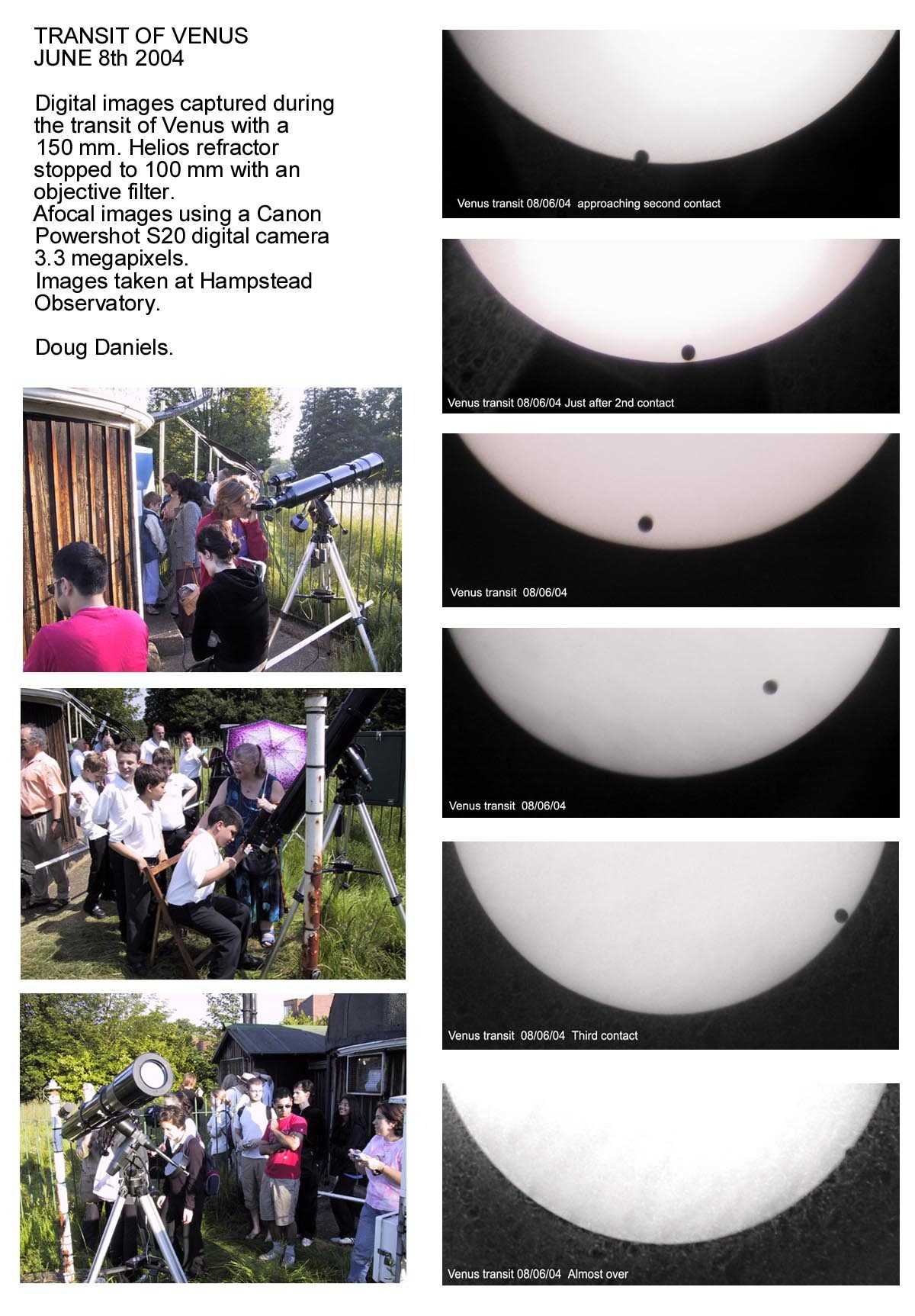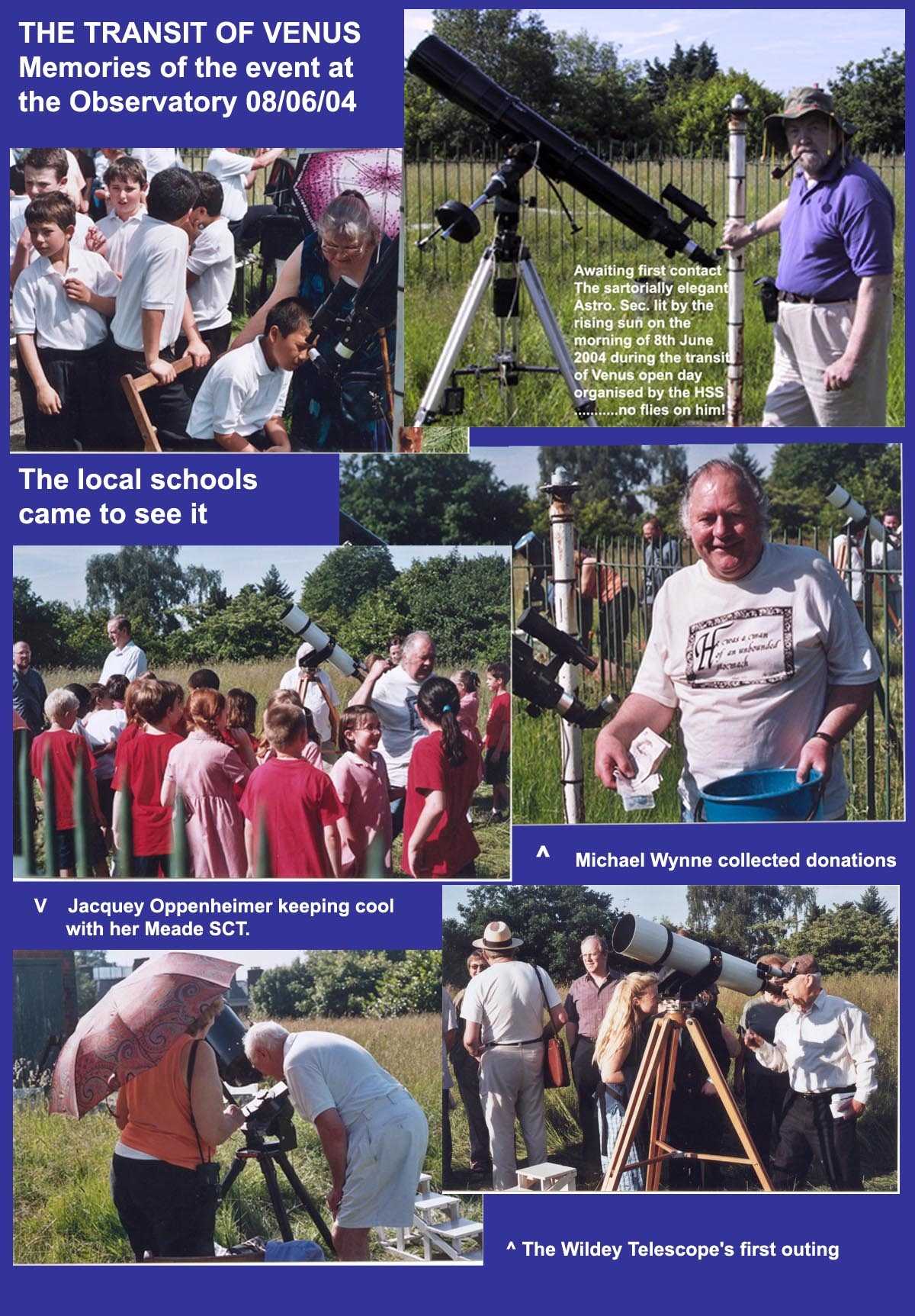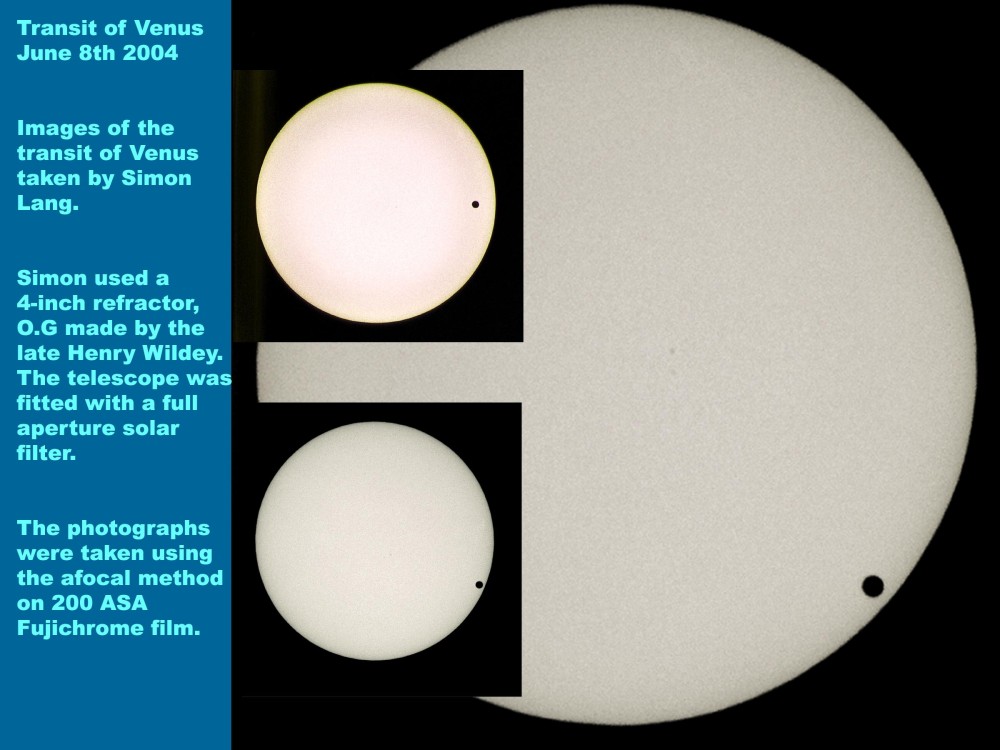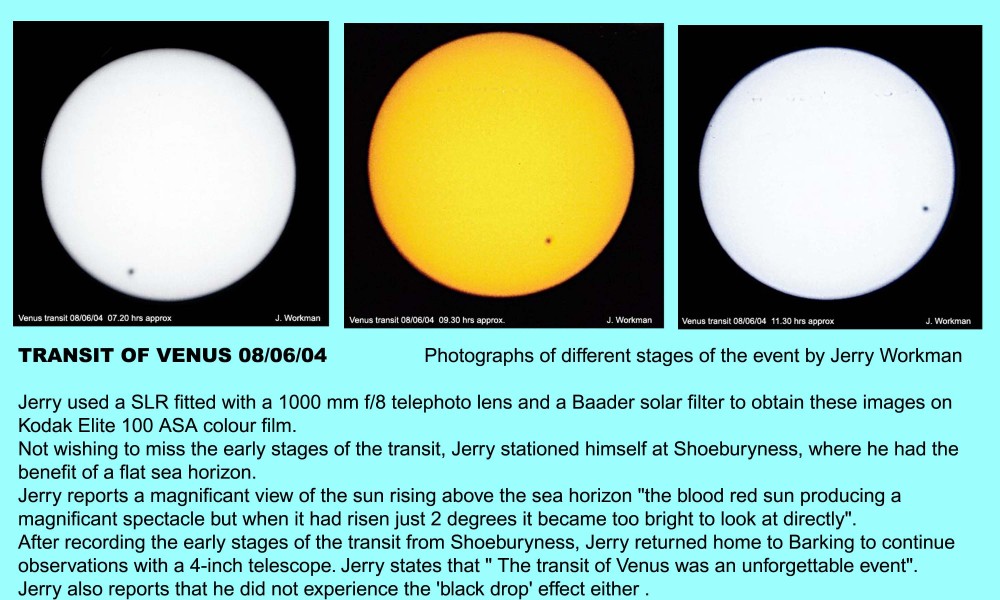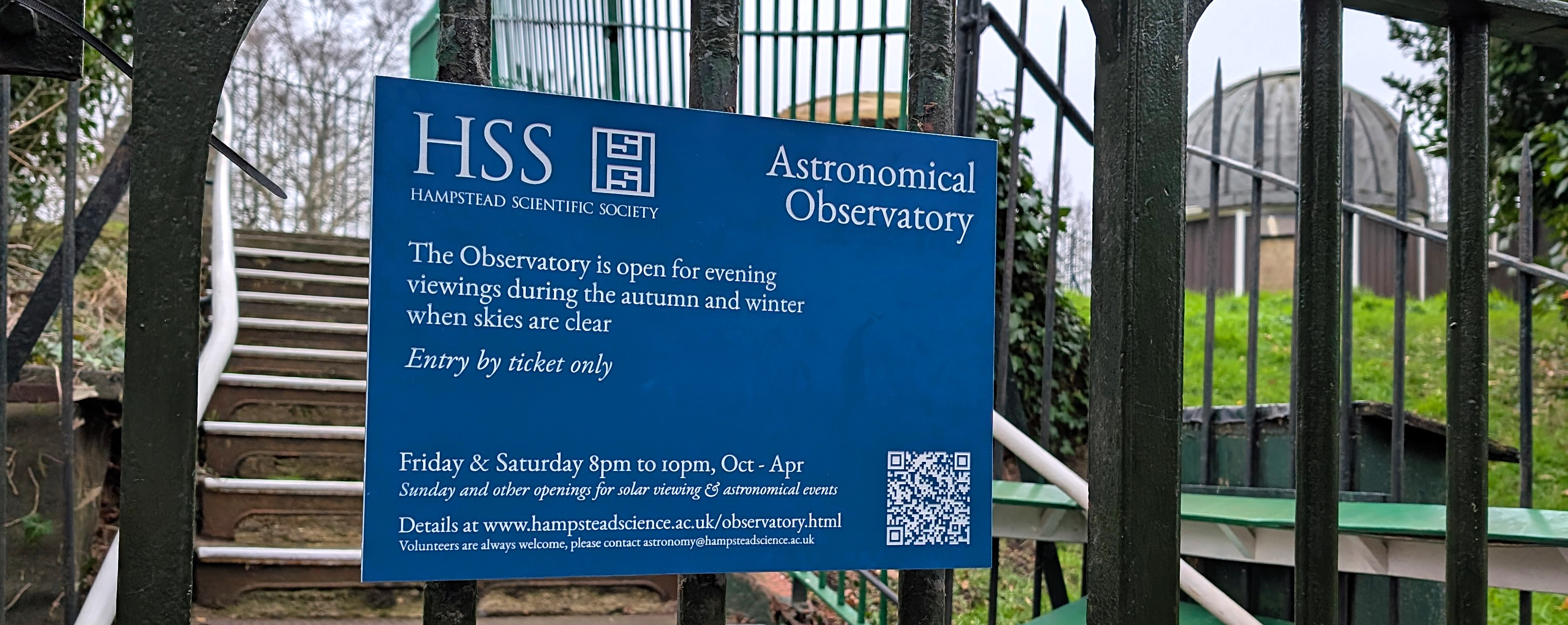
Observatory
Overview
The Hampstead Scientific Society observatory is one of the few places left in London that provides regular public viewings of the Moon, planets and other objects of interest in the night sky.
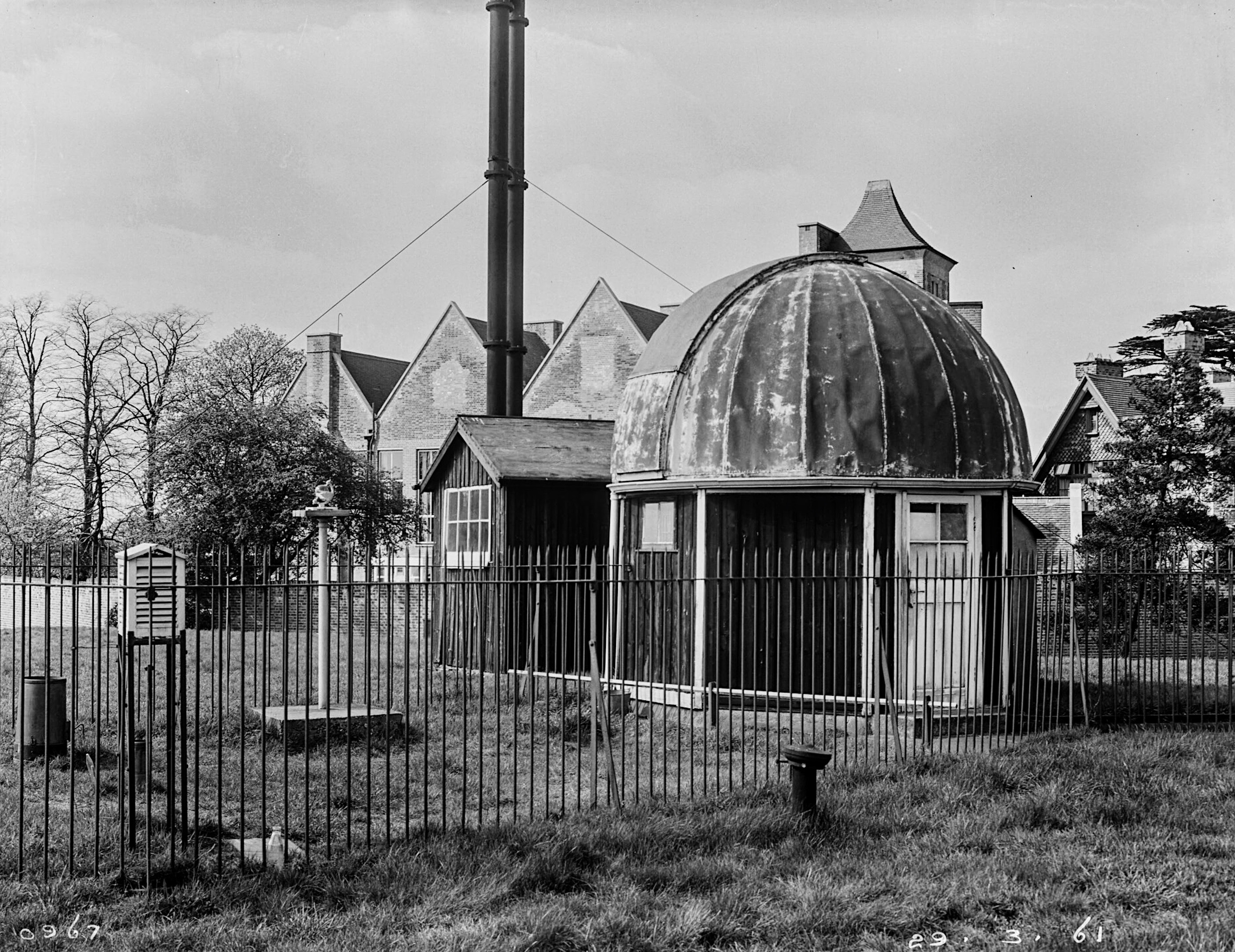
Opening times
The Observatory is generally open during the autumn and winter months, from October to April. During the summer, we close for maintenance, apart from occasional daytime sessions on Sundays to observe the Sun.
Though sessions are generally Friday and Saturday from 8pm to 10pm, please keep in mind this is dependent on the skies being clear. You can find updates on our facebook page and obtain tickets through eventbrite
How to find us
The Observatory sits atop a Victorian covered reservoir, just off Lower Terrace near Whitestone Pond in Hampstead. More details can be found here.
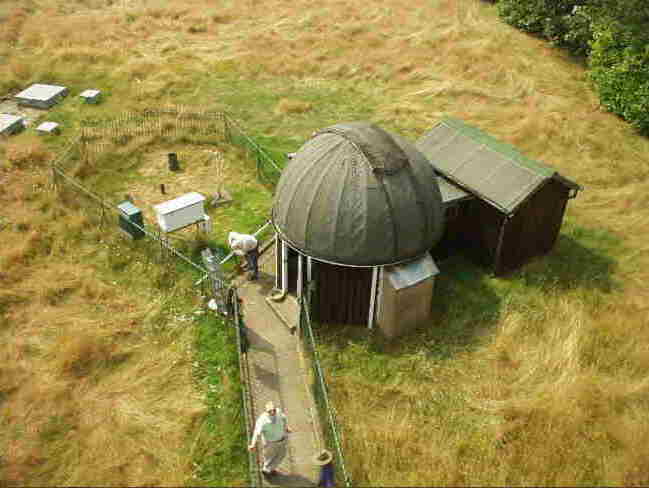
Telescopes
The main telescope at the observatory is the 6" Cooke refractor, a research instrument made by Thomas Cooke, a leading Victorian optical designer and constructor. The telescope dates back to the late 19th century and despite being so old it still delivers superb views of planets and double stars. It is a large telescope housed under a purpose-built rotating dome and represents both a rare historical artefact and a working, high quality optical instrument.
We also have a modern 16" Dobsonian which offers an interesting comparison to the Cooke as well as a chance to see fainter objects.
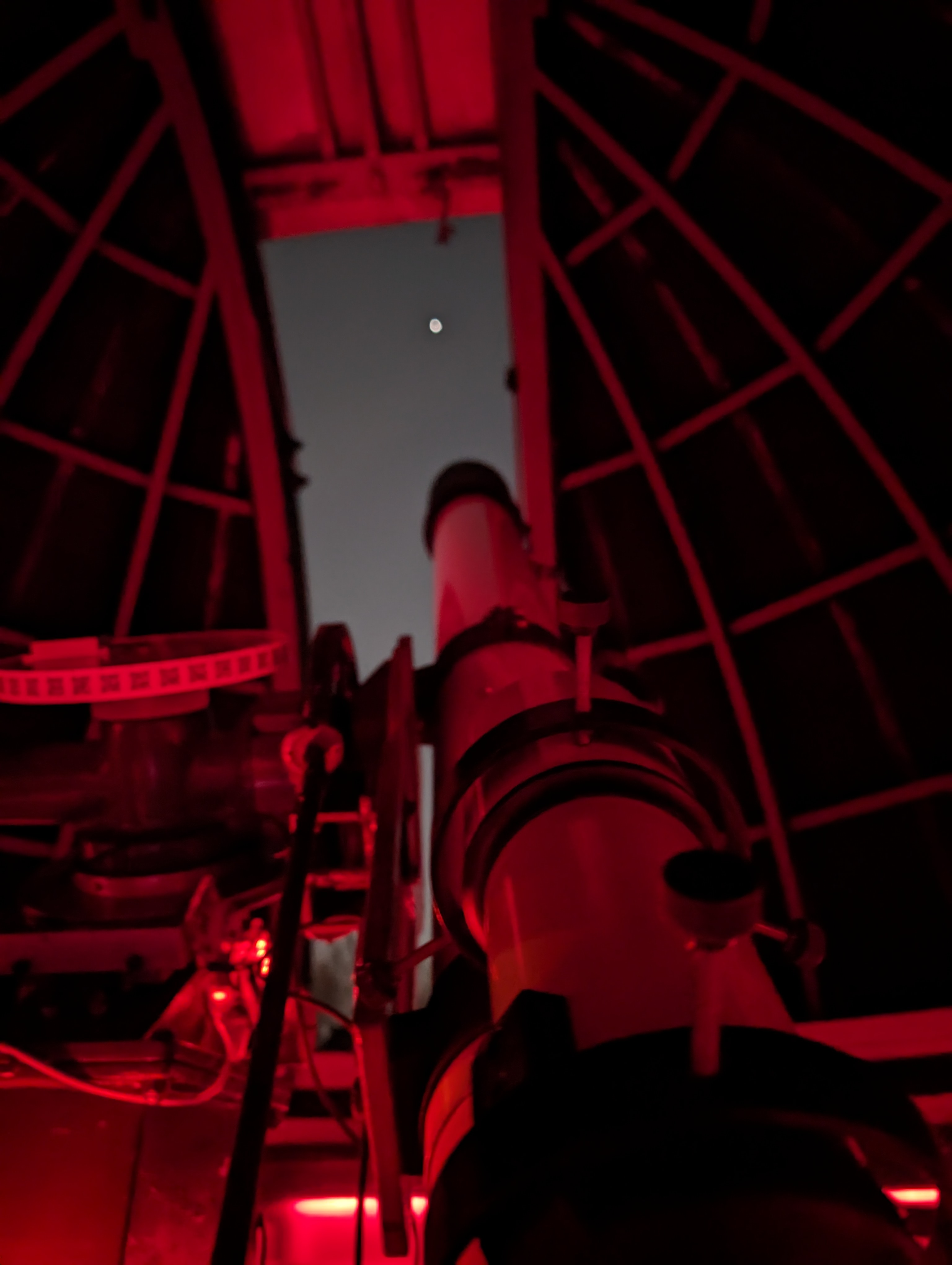
Telescope making
If you are considering purchasing your own telescope, remember, that our experienced telescope makers and users will be on hand to offer advice and can often point you in the right direction to save time and money. if you would like to try building your own telescope, then we can even help with this. The Society is affiliated to the Amateur Telescope Makers of London. They hold fortnightly meetings at Holly Lodge Community Centre where you can learn how to grind your own telescope mirrors and make your own instrument from scratch. Make enquiries to gritnglass@gmail.com
Reports
Doug Daniels (Joint Astronomy Secretary)
I have in the past, been criticised for the length of my Section reports. This year is totally different.
Last year we were informed by Thames Water that they were renovating the reservoir and that the site would be closed from 17th July 2016 until about the end of March 2017. In the event, their estimate regarding completion was way out. In fact they are still working on it now and are expecting to complete by the end of July. It has taken a full year to do the work and when we are allowed back on the site it will take us some time to re-site the Met. Instruments and restore the electricity supply and re-fit the telescope object glass currently in the care of Terry Pearce. It is our hope that we will be ready for the next session beginning in September. In conclusion: there were no public open nights during the 2016- 2017 session and no astronomical observations were made from the Observatory.
Doug Daniels (Joint Astro. Sec.)
Doug Daniels (Joint Astronomy Secretary)
New Session began Sept 18th
The new session of open nights began on September 18th but there were no bright planets to show as all the action was in the pre-dawn sky. In early October a brilliant Venus was in conjunction with Jupiter and Mars, and if you had a low clear horizon, you could also see Mercury joining in. At some stage the scene was accentuated by the star Regulus and a thin last crescent moon. With all that going on just before dawn, it was not surprising that the evening sky was positively dull in comparison – we had to show visitors double stars.
More photography at the Observatory
Towards the end of October, Doug was approached by the Daily Telegraph, seeking permission for a photographic session at the Observatory for one of their articles. The subject was to be an interview with Jon Culshaw the TV impressionist who, coincidently is on the Sky at Night team and a frequent visitor to the Observatory.
The group arrived at 3:00 pm and the session went on until 6:00 when due to darkness falling, the action continued at the Holly Bush.
Grim weather and special openings
The weather this session was/is the worst that I can remember. Since opening in mid September, there have only been 4 clear weekend nights until February 16th. Not surprising, people are becoming frustrated so Simon & John Tennant decided to open the observatory when a clear night was predicted. As luck would have it we managed two nights in succession on 13th and 14th of Feb. The sky remained clear and we had a good Moon a few days before first quarter. A small contingent of visitors turned up but given the short notice this was to be expected, but it allowed time to look at the moon and some of the other interesting objects in the winter sky in an unhurried manner, which is as it should be.
Because of the poor weather it was decided to extend the open nights the Observatory until May 22nd as Jupiter is now well placed for observation. Opening times changed to 9:00 pm until 11:00 pm as the sky is still light at 8:00pm. Apart from Jupiter we also have Mars in opposition on May 22nd and Saturn on June 3rd, but both planets will be very low in the south.
Transit of Mercury May 9th 2016
The last transit of Mercury took place on May 7th 2003. On that date the weather was fine and the whole transit was observed. Having endured the cloudiest session of open nights in memory, we didn’t hold out many hopes of getting a good view this time. The day before – Sunday 8th was the warmest day this year (so far) with cloudless skies but the Met. Office was predicting total cloud cover for the 9th with rain by mid afternoon. In the event, the Met. Office got it wrong again and Monday 9th dawned fairly clear with patchy cloud. As the transit lasted from 11:12:23 until 18:40:33 – fully a little over 7 hours, we expected to see at least some of it. We opened the Observatory to visitors and during the course of the day about 80 or so availed themselves with the opportunity to observe this uncommon event. By late afternoon, the Met. Predictions were realised and by 5:00pm it was raining. But we did see most of the transit.
Quite a few Members, Demonstrators and Assistants turned up during the course of the day and all who attended were rewarded with the sight of the diminutive disk of Mercury slowly progressing across the solar disk, reinforcing the comparison between the vast size of the Sun and the tiny planet orbiting it.
Many visitors came equipped with digital cameras and smart phones and they all went away with images of the event; how things have changed in the last few years!
End of session
The current session of open nights/days ended on Sunday May 22nd with a last look at the Sun. Without doubt this session has experienced the fewest clear nights (at weekends) that I can remember and consequently low visitor numbers. Is it the fault of ‘el-nino’? All being well we will re-open to visitors in mid September. My attendance has also been poor this session since I managed to crack my left humorous in two places when I slipped on wet leaves on December 10th following an HSS lecture meeting. Coincidently, our solar expert Brian Bond suffered a similar fate falling and hitting his face on the pavement. These accidents meant that other demonstrators had their workload increased as Brian and I were effectively out of action for much of the session. My sincere thanks to Simon and all our team for stepping in to provide cover. As usual thanks to all Demonstrators and Assistants for their continued help and to Julia for looking after the roster and the section’s finances.
Doug Daniels (Joint Astro. Sec.)
Doug Daniels (Joint Astronomy Secretary)
Comet Lovejoy (2014 Q2)
Discovered by Terry Lovejoy in Australia on August 16th and is currently travelling northwards. By early January 2015, the comet will be moving upwards, passing 10 degrees or so west of Rigel on Jan. 6th and then west of the Pleiades on Jan. 20th. At its brightest around Jan. 10th, Lovejoy should attain about Mag. 4.2. It will appear as a large diffuse Coma with a brighter centre condensation with perhaps a short tail. On the evening of January 10, the Astro Sec. (Doug) found it using 7x50 binoculars at 21:15 hrs. It appeared as a small dim circular patch with a not very bright condensation and no evidence of a tail. It did not appear to be much brighter than about Mag.6 so it does not appear to have brightened to the predicted value
Observing from the darker skies of Weston Coleville (Cambs.), but still with a moon in the sky, Terry Pearce managed to get images of Lovejoy on January 6th at 20:30 hrs. He described it as a pale disk with a distinct greenish hue resembling an out of focus globular cluster.
Venus/Mercury Conjunction & Comet Lovejoy.
On the evening of January 14th, Venus and Mercury were in conjunction in the low south-western sky after sunset. Simon took his portable telescope into the road at Hampstead but a low cloud bank prevented observation.
The Astro Sec. (Doug) had better luck on the following evening. A very clear sky just after sunset presented a clear view of the conjunction, with Venus and Mercury in the same binocular field of view. Simon also had better luck on the 15th, as did Kevin McNulty and John Culshaw, who watched the event from Parliament Hill and later got a view of Comet Lovejoy.
On Sunday Jan. 18th, Terry Pearce, observing from Weston Colville took 2 images of Lovejoy as it passed close to the Pleiades. The one using a 4-inch lens at f/6, managed to show a double tail.
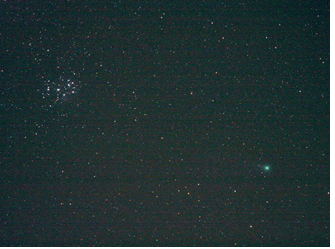
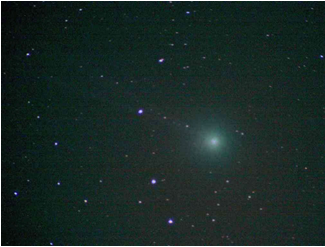
On the 24th- 25th of January, it was possible to view all the major planets, provided that you had the stamina! Mercury & Venus were visible at sunset, followed by Mars, Neptune and Uranus. Jupiter was visible for most of the night and Saturn was rising low down in Scorpio before dawn. There was also a 4 day old crescent Moon to add to the occasion and Comet Lovejoy was passing close to beta Arietis. The evening turned out to be particularly clear resulting in a deluge of visitors to the Observatory, some 100 plus visitors turned up to see some of these wonders and kept Doug, Jim Brightwell and John Tennant busy until well after closing time.
The problem with such large crowds is that it severely limits the number of objects that can be shown. All we could show them was the Moon until it set then M42 Orionis and finally Jupiter exhibiting all 4 moons. Although they had to queue for a long time in the freezing night, they all seemed to enjoy the experience evidenced by the very positive comments and £370+ donations to the fund box.
Total Solar Eclipse March 20th.
On March 20 2015, there was a total Solar Eclipse – 87% partial from Hampstead. The Eclipse began at 8:25 am and ended at 10:41.am. Mid eclipse was at 9:31 am, when 87% of the Sun was obscured. Unfortunately for us the entire event was obscured by relentless cloud. The BBC made the eclipse the main feature of Stargazing Live so public interest was high and despite the early time about 100 visitors turned up at the observatory but their only view of the eclipse was from many ipads and tablets. But all was not lost as Julia managed to recruit three possible assistants.
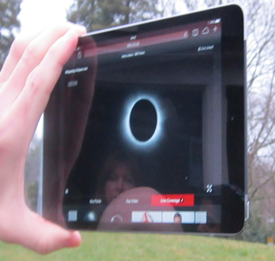
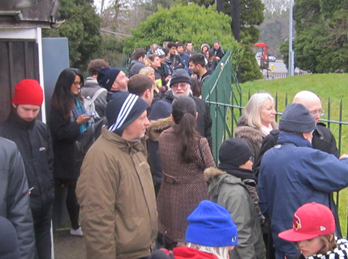
And as I confidently predicted at mid day the Sun came bursting through the cloud cover heralding a nice spring-like afternoon – typical!
But not all our members missed the main event. Kevin McNulty took to the ocean waves north of the Faroe isles on the good ship ‘Boudicca’ together with Paul Abel, Pete Lawrence and Jon Culshaw, They saw the total eclipse in its entirety and Kevin produced a report.
Member’s observing session
Kevin McNulty organized a member’s observing session on April 14th. The weather forecast indicated good observing conditions and with both Venus and Jupiter well placed for observation, it was decided to ‘go for it’. Kevin, Simon, Paul Abel, Jon Culshaw and Martin Fahey came along.
Paul Abel produced a series of excellent drawings of Venus, using various filters and later some nice views of Jupiter showing a transit of Ganymede.
Having tasted success on the 14th, Kevin organized another member’s observing session on April 21st. Quite a few members turned up to view Venus, close to a crescent Moon and Jupiter. However, the seeing conditions were not as good as on the 14th, numerous aircraft contrails caused a thin haze across the western sky.
Observatory Notice Board
During April, Alexander Menegas proposed the construction of an illuminated notice board. The idea was to construct a weather proof notice board that could be attached to the outside observatory wall. It could be a removeable board or it could be made as a fixture. The contents could be varied to provide information on the moon and planets and updated frequently. Alexander (aged 14) wanted to construct and finance the board himself and by the beginning of May, the work was almost complete. Simon fitted an external plug point to power the red light source which would also be useful to power portable instruments. Well done Alexander we like to see our younger members getting involved in this way.
End of Session
The current session of public open nights ended on 10th of May. Because the sky was still light at 8:00 pm, we opened from 9 pm - 11 pm. The 9th was partially clear for a last look at Venus, bright in the western sky, and Jupiter still well placed for observation.
Although the weather was not particularly favourable during the ‘open season’, we still managed to attract close to 1000 visitors during the session, indicating that the Observatory remains as popular as ever. Thanks to all Demonstrators and Assistants for their continued support and thanks to Julia for taking care of the duty roster and looking after the section’s finances. Also many thanks to Kevin for keeping the FaceBook link interesting and lively.
Doug Daniels (Joint Astro. Sec.)
Doug Daniels (Joint Astronomy Secretary)
NEW SESSION STARTING SEPTEMBER 2013
Just prior to the new session start, Terry Pearce and I (Doug), made our annual visit to the Festival of Astronomy at the old R.O.G at Herstmonceux. This year the weather was fine and on the Saturday night (7th Sept.) we managed a look at Neptune through the old 10-inch refractor. Then we went into the camping field and found one of the visitors who had a 16-inch Dobsonian in operation. We managed a look at the ‘Witches Broom’ – part of the Veil Nebula in Cygnus, M27, M57, M11 and M13. Glorious views of these deep sky objects which we never get in Hampstead.
FIRST OPEN NIGHT Friday13th Sept 2013
Not an auspicious beginning to the new session – persistent rain and drizzle ensured that the Observatory remained closed on Friday but the weather improved a bit on Saturday and visitors were treated to some good views of the Moon – just a couple of days after first quarter. The weather remained unsettled for the following week-end, open on Friday and clouded out for the rest.
BBC FILMING AT THE OBSERVATORY Friday Sept. 27th
Once again the BBC requested the use of our Observatory as a venue for filming an item for the HORIZON programme. The programme featured the forthcoming approach of comet ISON and the BBC kindly paid £150 as a location fee. The programme aired on November 23rd and the interior of the Observatory was seen for approx 5 seconds – that works out at a location fee rate of £30/sec.
SKY at NIGHT AWARD to DGD & JVD
A full report of the Sky at Night Magazine award made to Doug & Julia Daniels was published in the October edition of the magazine. It was in recognition of their combined total of 104 years as volunteers at the Observatory.
Comet ISON
By mid November we had hoped to be observing the ‘comet of the century’ a magnificent bright comet visible in daylight. Will we never learn? – comets are not to be trusted! Early predictions indicated that ISON would reach magnitudes of minus11 to minus16 – ten times the brightness of the Moon. The latest BAA Circular issued in November indicated a maximum magnitude on +3.3, in other words a dismal failure. But worst still, ISON did not survive its perihelion passage and just fizzled out so we saw nothing of it.
Other Comets
Apart from ISON during November/December, there were 3 other comets gracing our skies – Encke, Linear and Lovejoy. Of the three, Lovejoy was the most easily observed as it was at higher declination. On November 25 it passed a few degrees west of Cor Caroli (Alpha Canes Ven,) at a magnitude of +5.8
New H alpha Solar Telescope
In November we placed our order for a Coronado Hydrogen Alpha telescope and a HEQ5 computer controlled mount. These were delivered on December 3rd
2014. Coronado Telescope Training Day Jan. 5th
On Sunday January 5th, we held our first training session for Demonstrators and Assistants so that they could familiarize themselves with the setting up and operation of the new Coronado Hydrogen Alpha Solar Telescope. There is much to learn concerning the adjustments to tune the instrument into the different aspects of Solar observation and more to learn concerning setting up the new computer controlled mount. The meeting was reasonably well attended and we did manage to see a large sunspot group and one or two prominences before the low Sun was overwhelmed by thickening cloud. But at least the Coronado is installed and fully operational and will add another dimension to our Sunday morning solar observation sessions. In the event, we had to wait until March 9th for a nice sunny Sunday to show visitors what the Sun really looks like! The Sun, however, was a bit quiet with a few small sunspots and a couple of small prominences and dark filaments visible. Doug also managed to get a picture with a hand-held Canon A2200 compact digital camera that just about shows one or two small prominences.
Stargazing Live
Once again the BBC produced another two Stargazing Live programmes in early January. Once again the weather was appalling but we managed one clear night on Saturday 11th Jan. Despite not advertizing our participation in the event because of last year’s problems with crowd control, around 200 visitors still turned up and were treated to views of the Moon, Jupiter and M42 and the Pleiades.
Well done all those who turned up to assist on the night.
Supernova in M82
Well done to Dr. Steve Fossey and his students at Mill Hill Observatory for their discovery of a Supernova in the galaxy M82 Ursae Majoris. The discovery was made on Jan. 21st during a training session with the Observatory’s Celestron 14 and was the first time that the students had used the telescope. The image was identified in a 10 second CCD exposure taken through a gap in the clouds. “You lucky blighters”.
Bad weather & Bad News
Towards the end of January and the early part of February, we experienced the worst weather for almost a century. Persistent rain and high winds blew in from the Atlantic carried by the jet stream that had positioned itself to the south of the country. High tides and monstrous waves battered the coasts and rivers burst their banks flooding vast areas. In north London, we were spared much of the devastation, but the high winds managed to dislodge the Observatory shutter.
The bad news came on February 18th when we heard of the sad passing of Gordon Harding (age 85).
Gordon had been an Assistant demonstrator at the Observatory for many years. He was an enthusiastic amateur astronomer and was a Fellow of the RAS, a member of C.A.T.S and of the Harringay Astronomical Society. He will be greatly missed by his many friends.
Aurora - strong activity
Reports came in of strong auroral activity on the night of February 27th, the display was visible as far south as Jersey. I looked out shortly before midnight from Finchley, but saw nothing. Not surprising with the current level of light pollution. Needless to say, it was totally overcast on 28th.
Scouts visit on March 7th.
The Christchurch Scouts at last managed to visit the Observatory on the evening of March 7th. Their visit postponed from last month due to bad weather. This time we were lucky and were able to view a near first quarter Moon and Jupiter under clear skies.
Extended opening season
We decided to extend our opening season up until 18th of May. This was because Jupiter was still on view and Mars was well placed for observation after opposition in April, and we could get a brief glimpse of Saturn before it is lost to view in the low declination Summer constellations. Because ‘summer time’ was by then in force and consequently not dark at 8:00 pm, from April 25th we opened at 9:00 pm - 11:00pm. The last weekend opening sessions were blessed with clear skies and about 150 visitors turned up on 16th for a final glimpse of Jupiter, Mars and Saturn.
Member’s Mars Observation nights
Responding to some midweek clear nights, we decided to open for members to observe Mars. Two sessions were arranged on April 24th and again on May 14th. Those attending were shown how to work out the Longitude of the Central Meridian (LCM), by Julia using the BAA Handbook and Doug brought his globe of Mars. Despite not being a close opposition, considerable surface detail could be seen together with a small northern polar cap.
End of session
The session ended on Sunday May 18th. I should like to take this opportunity to thank all Demonstrators and Assistants for their continued support. The Observatory is becoming ever more popular with visitors as can be seen from the numbers attending when we actually get a clear night. I should also like to thank Kevin McNulty, Cara Christie and Simon who keep our Face Book entries up to date – we have over 800 regular readers, some from abroad and well out of our ‘catchment’ area.
Finally, I thank Julia for organizing the roster and looking after the section’s finances which thanks to our anonymous benefactor has ensured that they remain in a very healthy state.
Doug Daniels (Joint Astro. Sec.)
Doug Daniels (Astronomy Secretary)
The new session of public open nights began on October 19th. Although the Observatory was still a trifle unfinished, it did not prevent visitors from observing Jupiter. However, the weather was not particularly helpful for the first few weeks, except for the Sunday session on November 18th which featured a cloudless sky for Solar observation.
The weather deteriorated further in December, it hardly stopped raining for 3 weeks and produced few clear nights. But when skies did clear, visitors were able to observe Jupiter now at a good altitude just north of Aldebaran and the Hyades and presenting much fine detail in the cloud belts.
A LEGEND PASSES AWAY
On Sunday December 9th 2012 we received the sad news that at the age of 89, Sir Patrick Moore had passed away. Patrick had a long standing association with our Society. During the 1950's, our Observatory was visited by Patrick and the Sky at Night team who tried to image the moon through our telescope. Unfortunately the weather failed to co-operate on that occasion. Patrick returned to our Observatory in 1976 to dedicate our new telescope mount built by Terry Pearce, to the memory of Herbert Stark, who was General Secretary of the Society. The Sky at Night team returned again in October 2011 to interview Doug Daniels on the subject of Mars observations made during the last century and on this occasion the weather did co-operate and we were able to image Jupiter live on television. Unfortunately, Patrick was not well enough to attend on this occasion.
TELESCOPE PROBLEMS
Just before Christmas, the telescope drive packed up. This presented us with a problem as its designer/builder Paul Clements, is now domiciled in the Philippines. However our own Jim Brightwell took up the challenge of diagnosing the fault. Fortunately, we have a copy of the circuit diagram and Jim was soon able to discover that the stepper motor itself was faulty. Paul Clements' drive system was installed in 1992, so it has given very good service but has become troublesome over the last couple of years. Replacement stepper motors are becoming difficult to locate and increasingly expensive. Jim has volunteered to build a simplified version using easily obtainable and inexpensive components. As we will be designing the motor and gearbox from scratch, we will endeavour to arrange for it to be mounted inboard on the telescope mount where it will no longer be vulnerable to accidental damage caused by the telescope hitting it when it is being used close to the eastern side of the pier. In the meantime, Jim has built a stand-by unit using a stepper motor salvaged form an old printer and a gearbox using Mecanno gears to give us a sidereal rate drive which is controllable by the old modified 'Paul Clements' infra red controller.
On Sunday morning January 6th, Jim, Simon and Doug fitted the 'new' drive unit to the telescope – it worked beautifully – Well done Jim! And many thanks for donating it to the Society.
Stargazing Live 3 (SG3)
Following the success of the two previous years programmes, the BBC decided to 'keep the ball rolling' with yet another session of Stargazing Live in January. Due to the fact that we were somewhat overwhelmed by visitors on the two previous sessions, we decided to keep a low profile this year. As it transpired, the weather was again appalling during the session but visitor numbers were still high when we did get a clear night. On February 3rd 2013, 75 visitors arrived and were treated to views of Jupiter and some of the brighter winter sky objects. We had two additional telescopes outside manned by Slim and Simon whilst Kevin (McNulty), wielded the Cooke.
Russian Fireball Feb 15th
11:25 AM GMT . A massive fireball was reported over the Ural Mountains in Russia close to the city of Yekaterinburg. The meteor caused a damaging sonic boom which blew out windows over a large area causing injury to approx. 1,000 people, mostly from falling glass. Images of the event were posted on U Tube.
NEA 2012 DA 14 Close Approach Feb. 15 2013
On 15th of February, Near Earth Asteroid 2012 DA 14 made a close approach to Earth at 19:26 hrs. UT. The asteroid is about 140 metres across and weighs in at about 125,000 Tonnes, and it approached Earth to within a distance of just 35,000 Km. which is far closer than the Moon and is within the orbits of geostationary satellites.
Visually it would have appeared as a 6th – 7th magnitude object slowly moving from south to north on a path roughly between Arcturus and Denebola. The best time to identify it would have been at 21: 45 hrs when it passed between Megrez and Alioth in Ursa Major. As the event took place on an open night, we expected a large crowd, hopeful of actually seeing it, but as so often happens with rare events, after a sunny almost spring like day, the skies clouded up shortly after sunset and remained overcast for the entire evening.
FOJ (Friends Of John Hayden) Remembrance Walk & Visit Feb. 24th
Braving a viciously cold day, some 25 former friends of the late John Hayden gathered for a remembrance walk on the Heath on Saturday February 24th, John's birthday. After partaking of lunch in the Spaniards, the group walked to the Observatory, where John had been a demonstrator for some 30 years. Doug & Julia were there to meet them and tell them a little of the history of the Society and the Observatory, after which we all went down to Burgh House for tea and more remembrances of John.
Observing pan-STARRS
Braving freezing temperatures and wintry snow showers, Simon organized a session to observe comet pan-STARRS. Severn hardy souls turned up not expecting to see much in view of the weather.
As the comet is low in the western sky just after sunset, the session took place in the 'old sand pit' field at the end of Judge's Walk, where there is a low western horizon; trees now obscure the western horizon at the Observatory. After a brief snow shower, the sky cleared and the comet was picked up by Jon Culshaw using a pair of Patrick Moore's binoculars
Pan-STARRS has unfortunately not lived up to the early predictions and it was difficult to see in the twilight sky. It was estimated to be about first magnitude, but spread over a diffuse area, it was certainly not a bright naked eye object. The comet appeared as a diffuse shuttle shaped blob with a bright coma and a very faint tail. Attempts were made to photograph it by Simon and Anthony but the results were disappointing. However Doug managed to tease one image of the comet from one of Simon's jpegs.
Ennio Tabone, now living under the darker skies of Dorset, had better luck and managed to get a decent image through his 4-inch refractor on March 31st. He took an exposure of one minute duration at ISO 800 with an anti pollution filter. I did a little mild image processing and posted it on the web-site. I doubt that we will get a better image, certainly not from Hampstead.
A rare clear night on the 7th of April, attracted quite a crowd at both the Observatory and the 'sand pit' site in Judge's Walk, where several instruments were set up to view the comet. Well over 40 visitors just managed to make it out as it has faded considerably. Comet pan-STARRS has not lived up to early predictions and we are left wondering about ISON that is reported as not brightening as it should.
BBC Celebration of the life & work of Sir Patrick Moore May 1st 2013
During April, we were invited by Lord Hall of Birkenhead, the Director General of the BBC, to attend a special reception to celebrate the life and work of the late Sir Patrick Moore on Wednesday 1st May at Broadcasting House. The initial invitation was to Doug & Julia, but Doug managed to obtain tickets for Terry Pearce and Simon Lang, so our Society was well represented. An estimated audience of some 300 people attended. During the celebrations, Jane Fletcher, the last producer of the Sky at Night programme, The Astronomer Royal Martin Rees – Lord Rees of Ludlow, Jon Culshaw, Pieter Morpurgo, Chris Lintott and Professor Brian Cox spoke at length about Patrick's passion for astronomy and his record of 50 years in broadcasting. Jon Culshaw kept the audience amused by reading some of Patrick's letters to the BBC. Jon's impersonation of Patrick is now so good, that if you closed your eyes you could believe that he was still with us! During the event tributes to Patrick's musical talent was highlighted by two Xylophone performances by Owen Gunnell. After the formal part of the celebration we gathered in the Media Café for refreshments. In all it was a great tribute to a unique personality, thoroughly enjoyed by all who attended.
Extended opening season at the Observatory
Due to the fact that Saturn is now descending into the low declination Summer constellations, we decided to extend our opening season until May 12th. As it is not dark at 8:00 pm, we changed the opening hours to 9:00pm – 11:00 pm. This gave visitors the chance to take a last look at Saturn with its rings well displayed before it finally descends to low altitude where it will remain for the next few years.
The Observatory finally closed for this session on May 12th and is scheduled to re-open on September 13th.
Massive donation to the Observatory fund
During mid May, Doug Daniels received a telephone call from a gentleman who had visited our Observatory together with his wife and children. He was so impressed by what he had seen that he told Doug that he was the director of a finance company that made donations to deserving causes and that as we were a registered charity, we might benefit from this scheme. If our application was successful the donation must be described as "an anonymous donation" and it would be in the region of £15,000.
I am delighted to report that we were indeed successful and that we received a cheque for that amount on May 24th.
This is the largest donation ever made to the Society and I have written to thank the donor expressing our gratitude for their great generosity and I am sure that you will also join me in saying a big "Thank You" to our anonymous benefactor. This sum will allow us to purchase some new equipment that has long been on our "wish list".
Observatory on FaceBook
At the beginning of the session the Observatory joined FaceBook. This has enabled us to post 'up to the minute' news about the Observatory's opening status and to post other articles of astronomical interest. It also provides feed back from visitors, much of which is very positive. It also shows that we have a following that greatly exceeds our 'catchment area', some coming from other countries.
We must thank Kevin McNulty for initiating this and for the work that he puts into uploading items of interest and to Simon and all those members of the section who do the same.
And Finally
As usual I would like to thank Simon and our team of Demonstrators & Assistants for their continued support. The Observatory is very important to the Society, greatly appreciated by all visitors and particularly by one anonymous and supremely generous individual. I must also thank Julia for managing the roster and looking after the section's finances which are now once more at a very healthy level.
Doug Daniels (Astro. Sec.)
Doug Daniels (Astronomy Secretary)
Total Lunar Eclipse June 15th 2011
There was a total lunar eclipse on the night of June 15th at moonrise. From London the moon rose already totally eclipsed but in a light sky. Totality was a long event as the moon crossed the centre of the Earth's shadow. However, as usual cloud and rain did its best to ruin the event from London, but Simon and Ennio decided to go to Parliament Hill where they were rewarded with a brief view of the eclipsed moon through gaps in the cloud cover. Jim Brightwell, continuing his eclipse chasing, made a flying visit to Rhodes (Greece) to view the eclipse at a greater altitude and in perfect weather.
Visit by Friends of the Royal Astronomical Society – Saturday June 18th 2011
By arrangement with Peter Hingley and Marcus Hope, 18 members of the 'Friends of the R.A.S.' visited the Observatory on Saturday June 18th. Despite overcast skies with occasional showers, the Sun broke through occasionally and allowed the visitors to view the Sun with Brian Bond's Coronado H-alpha kit. One reasonably large sunspot was seen together with at least one large prominence on view. Doug Daniels gave the visitors a short talk on the history of the Society and the Observatory and then led the visitors down to the Holly Bush pub to partake of lunch.
Sussex weekend Astro Camp July 8/9th 2011
Thirteen members attended a weekend astrocamp organized by Simon Lang. The location was at Simon's brother's cottage near Lewes Sussex. The site has a good dark sky and was chosen to give members the opportunity of observing some of the fainter deep sky objects now denied to us by the light pollution in London. In the event the weather once again failed to cooperate and restricted the viewing to a few of the brighter objects. Simon took his 12-inch Newtonian and this provided a stunning view of M13. Other objects viewed were Saturn and just before dawn, Neptune and Jupiter, with the South Equatorial Belt now once more in evidence.
Observatory working party Sunday August 21st 2011
Seven members joined Doug & Julia Daniels for a few hours to prepare the Observatory prior to the start of the new session, planned to begin on 16th of September. After last year's exertions we were content to limit our activities to clearing the path and steps of weeds and generally tidying up, dusting and cleaning the building. Despite a poor weather forecast, the day proved to be dry and warm and ideal for the planned tasks. Before the work began, 30 visitors from the Hampstead Walks turned up and were given a short talk by Doug on the history of the HSS and the Observatory.
Herstmonceux Festival of Astronomy September 2011
On Saturday Sept. 3rd. Doug Daniels and Terry Pearce traveled down to Sussex to the Annual Festival of Astronomy held at Herstmonceux Castle the old home of the Royal Greenwich Observatory. The journey down on a warm sunny day promised a fine night to come, but as is so often the case this turned out to be a false promise. The very moment that we arrived coincided with a change in the weather and by nightfall the cloud cover was total. We spent the night in Terry's flat in St. Leonard's and returned to London later on Sunday evening disappointed not to have had a look at Jupiter through the many telescopes in the camp field or through any of the old Greenwich instruments that still function, albeit to a limited extent, but we were informed that renovation will soon begin,
New Session 16th Sept. 2011
The new session of public open nights began on September 16th 2011. When Julia and I (DGD) left home, the sky was reasonably clear but the cloud reached the Observatory at the same time that we did, and remained throughout the session. About 20 visitors turned up and we spent a couple of hours discussing things astronomical. All agreed that it was a pleasant evening despite the poor weather preventing any actual observations.
The main object of interest this session was Jupiter, now attaining better altitude in Aries. On the night of Sept 29th Doug Daniels obtained an image with a 150 mm Mak Cass. The image showed that the SEB, missing last session, had returned. The NEB appeared quite dark with a particularly dark notch visible in the image. The belt is also quite red in colour. The GRS was also seen visually looking pink. at the moment. Conditions were far from perfect with quite high temperatures and slight haze after an unseasonably hot day reaching 28 degrees! The clear warm weather continued and on the evenings of 31st Sept & 1st of October, the Observatory open nights were both well attended, Over 50 visitors on Oct. 1st were able to see the GRS and considerable detail in the cloud belts – all in pleasant warm conditions as the day time temperatures registered 29.4 degrees – a record high temperature for early October!
Visit to Observatory by R.A.D.A. students
Following a request by Sebastian Harcombe, 10 students from the Royal Academy of Dramatic Arts, visited the Observatory of the evening of October 4th. Unfortunately, as is so often the case with arranged visits, the sky was totally overcast so no observations were possible. However, DGD managed to entertain the students for an hour or so by talking about the history of the Society and Astronomy with particular attention to some of the astronomical references in the works of Shakespeare et al. It is a pity that the poor weather precluded any telescopic observations, but the students seemed to enjoy the experience which we hope helped to widen their horizons and we thank R.A.D.A. for their kind donation of £25 towards the Observatory Fund.
Some unseasonable fine weather meant that the Observatory was in great demand on the weekend of 14th, 15th and 16th of October – rare to be clear on all 3 public open sessions. On the 14th over 45 visitors were able to see Jupiter and the Moon close to full. A similar number of visitors observing Jupiter witnessed a nice shadow transit of IO on the 15th and on the Sunday morning the 16th there was a fine crop of sunspots to be seen. However, cloud soon built up to spoil the view.
After a couple of years at low declination, Jupiter is at last attaining greater altitude in Aries. Last year the SEB was noticeable by its absence, but this year it has returned to prominence. The NEB is distinctly brown in colour with a very dark elliptical 'barge' on its northern edge. The GRS is also very prominent and distinctly pink followed by a light oval and the whole SEB is double and there is much detail in the north polar region. The planet came to opposition on December 3rd and it gave some of the section's imagers plenty of opportunity to record the details of its changeable turbulent atmosphere.
Sky at Night team visit to Observatory Oct. 19th 2011
On the 19th of October, the BBC Sky at Night team visited the Observatory to film material for the November screening of the popular television programme. The programme featured the planet Mars which came to opposition in March 2012. The presenters, Paul Abel and Peter Lawrence interviewed Doug Daniels who showed them the Society's archive of Mars observations which span a century. They then interviewed John Culshaw (the TV impressionist) about his experiences visiting the Observatory. Fortunately we had a clear night and later when darkness fell we were able to observe Jupiter and to record it live using an Astrovid video camera attached to the Cooke. Several members of the section and some members of C.A.T.S. came along as well, and John Durham brought his 6-inch Dobsonian built by him at CATS. The whole session lasted from 4:30 pm until 10:30 pm. The programme was transmitted on November 6th on BBC1 and there is a link to a 'clip' featuring the Observatory on the Sky at Night website and also on YouTube.
STARGAZING LIVE (SG2) January 16th – 18th 2012
Following last years success (partial!), the BBC decided to go for another series of Stargazing Live and we once again agreed to participate in the venture. The first hurdle to overcome was getting our opening times on to the BBC's wretched 'user unfriendly' Web Site which refused to accept our Observatory location. It took the best part of a week to get things sorted out requiring the assistance of the BBC's IT department, who at times seemed equally baffled by it. Nevertheless, once up and running it provided excellent publicity for our events and this year, thanks to the guidance by Anna Barlow, we managed to get some local publicity in the Camden New Journal, which featured an interview with Doug Daniels.
The television programmes again featured the comedian Dara O'Briain and Professor Brian Cox and went to air on January 16th, 17th and 18th. Our involvement consisted of opening the Observatory from Jan, 13th through to Jan. 22nd and sending several representatives to the BBC's major local event at Charlton House Greenwich on Jan. 17th. Accordingly, Simon Lang, Ennio Tabone and Kevin McNulty ventured south of the river armed with a variety of activities to involve children, from mirror grinding, making a Sun pin hole projector box and a simple spectroscope to a "make your own crater" activity.
The first open weekend at the Observatory was blessed with crystal clear skies and very low temperatures which did not deter huge numbers of visitors from turning up – 50 plus on Friday and over 100 on Saturday and a similar number on Sunday, taking advantage of Brian Bond's H-alpha telescope to view solar prominences and sunspots. The evening session mainly consisted of observing Jupiter with the Cooke telescope and other winter sky objects with instruments brought up by other members Ennio, Simon and Slim. Once again the BBC provided us with the very useful little star guide booklets to hand out to visitors, particularly to children. And there were sets of 'activity cards' which were equally appreciated.
February 2012
February began with a spell of very cold weather and quite heavy snowfall. We had to close the Observatory at the weekend of Feb. 10th – 12th as the dome and shutter were frozen solid and it was judged that ice on the steps rendered them hazardous for visitors. The cold weather did not last very long and we had some very clear nights during the month. Visitor attendance remained high – too high at times, thanks to all the publicity that we received in January. Jupiter, Venus and Mars were well placed for observation with Mars soon to be in opposition in early March. Despite the small disk size of 14 arc/sec, some detail could be discerned.
More filming at the Observatory March 8th 2012
On March 8th, a BBC2 film crew came to the Observatory to film footage for a forthcoming edition of 'The Culture Show', due to go to air on 16th March. The programme discussed the implications of the Voyager Space Mission as Voyager 1 is about to leave the Solar System and is headed for deep space. It was a fine night so we were able to show the visitors, Venus and Jupiter, approaching conjunction on 13th also Mars and a Full Moon. They donated £50 to the Observatory fund, for which much thanks.
During March 2012, Venus and Jupiter dominated the western sky after sunset, coming to conjunction on March 15th. There was an unexpected clear night on March 15th and I was able to obtain an image through my bathroom window using a Canon compact A2200 camera. A few days earlier there was an alert concerning enhanced solar activity which raised expectations of possible Auroral activity. There were many fine images of auroral displays posted on the Sky at Night Flickr site by northern observers, but no activity was seen from our latitude.
Towards the end of March we were fortunate to experience a spell of settled fine weather with record temperatures for the time of year. This, together with the proximity of Venus to Jupiter in the western sky and the publicity we had received earlier in the session, resulted in large crowds gathering at the observatory. On Saturday 24th March, over 100 people turned up to observe Venus, Jupiter and Mars, the latter just past opposition on March 3rd.
The high atmospheric pressure resulted in fairly good 'seeing' (about 3) and despite the small disk size of 31.2 arc/secs, some detail was seen under high magnification. Mare Acidalium was prominent and to the south, Margaritifer Sinus, Mare Erythraeum and Aurorae Sinus were evident. The northern polar cap was small and bright contrasting with a dark Mare Boreum.
End of current session
Towards the end of the current session, the number of visitors began to fall towards 'normal' levels. The last open weekend was on the 20th, 21st and 22nd of April. Without doubt, this session has seen a dramatic rise in visitor numbers and to cope with this, demonstrators and assistants have had to cover more duties. Sadly, at the end of the session, we had to say farewell to Ennio Tabone who is moving to a new job and life in Dorchester where he will also enjoy darker skies. We thank Ennio for all his good work and wish him and his family all the best for the future. We also take this opportunity to thank all our Demonstrators and Assistants who volunteered for extra duties giving their time to ensure that visitors enjoyed their experience at our Observatory which is still our main interface with the public.
Last year I reported that the section experienced its busiest session ever recorded, but this year exceeded that. Over 1000 visitors took advantage of our unique facility and they contributed a record amount to the Observatory maintenance fund. This demonstrates the power of publicity afforded by the mass media – the press and television. However, there were times when we were almost overwhelmed by this attention and it is fortunate that we have so many enthusiastic amateur astronomers willing to share their knowledge and experience with the visiting public, for which we thank them. We also take this opportunity to thank Julia for keeping the Section's accounts in order and Leo for auditing them. We also thank Julia for organizing the Observatory roster this year when unforeseen circumstances prevented Simon from doing it.
Finally the Transit of Venus (2)
On June 6th 2012 Venus again transited the Sun. This was the second of the pair of transits separated by eight years; the last one was on June 8th 2004. In 2004 we had ideal conditions when the entire transit event was seen from the Observatory under cloudless skies. The recent transit was never going to be as good because from our latitude only the last hour of the transit would be visible at sunrise. This meant that the event was not observable from the Observatory as an unobstructed north eastern zero horizon was required. Weather conditions were also far from ideal, the days leading up to the transit, featuring the Queens' Diamond Jubilee bank holiday weekend, were overcast and raining and the forecast for the early morning of 6th was not very hopeful. Simon had considered taking a group to the north Kent coast if it looked as though it might clear up but in the event decided to try to observe it from Alexandra Palace. Unfortunately the cloud persisted and only a brief view of Venus at the last stage of the transit was glimpsed.
Doug Daniels (Astro. Sec.)
Doug Daniels (Astronomy Secretary)
The 2010 session ended on May 16th. We had extended the session in order to continue observation of Saturn and give visitors the opportunity to view the exhibition celebrating our centenary.
On Monday May 17th, in collaboration with Chris Hatherill of 'Super–Collider', the section put on an observing evening in Shoreditch, east London. The event took place on the roof terrace of the 'Queen of Hoxton' bar in Curtain Road, high up amid the City office blocks. The Astro. Secretariat, Doug, Simon and Julia arrived before sunset to set up two of Simon's portable telescopes – a 5-inch refractor and a 6-inch Maksutov Cassegrain. We were afforded a clear night and after a colourful sunset, the telescopes were trained on Venus, a slim crescent moon and later Saturn. Over 100 visitors took advantage of this event which continued until 11 pm. All things considered, it was a very successful 'outreach' event for the HSS and the donation to our funds was much appreciated.
New impact on Jupiter
Anthony Wesley (Australia) reported a bright flash lasting 2 seconds in Jupiter's south equatorial belt (SEB) on June 3rd. The event was also independently videoed by Chris Go. The impact does not seem to have left any lasting 'scar'. Unfortunately, the planet was too low for observations from Hampstead.
Observatory working party (1) July 4th 2010
A dozen or so members and friends gathered at the observatory on Sunday July 4th to begin the summer programme of site maintenance. Our first target was the preparation and de-rusting of the iron railings that surround the observatory enclosure. The railings have not seen paint for more than two decades and were in a poor state of repair. Simon managed to recruit a large task force of volunteers to chip off the rust and loose paint prior to re-painting. Once again we managed to select a fine day for the work. The grass and weeds along the path were also cleared. The work continued until late in the afternoon. Our thanks to all who took part in this mind numbing interminable but nevertheless essential work. At least three more working sessions will be required to complete this task.
During the day we had quite a few visitors as well, including 50 from the Hampstead Walks. We were able to show them a projected image of the Sun featuring one tiny sunspot. The Sun, it seems, is still loath to quit its lengthy minimum.
Cezary Ludwik Kamieniecki - Caesar K (1950-2010) - Obituary
In July 2010 we received the sad news that Caesar Kamieniecki had died aged 60 following a long illness. See the August Newsletter for an obituary.
Observatory maintenance (2) July 24th 2010
The programme of observatory maintenance continued with another session on Sunday July 24th. Five members turned up to continue de-rusting the railings and begin to apply primer. Work was again interrupted by the 50 or so members of the Hampstead Walks, who were given a short talk on the history of the Society by DGD.
Planet Picnic July 31st 2010
On the evening of July 31st, the planets, Venus, Mars and Saturn were aligned in triangular formation in the western sky after sunset. Simon arranged a viewing session in the guise of a picnic to be held in the field on Judges Walk, which has a low western horizon. There was also the faint possibility of glimpsing Mercury. The Ham & High advertised the event with a 1/3 page feature article. During the late afternoon, cloud started to build and Simon decided to postpone the event until the following Friday the 6th of August. However, at 6:00pm the sky cleared and by the time that the sun set conditions were good. Simon and Jim Brightwell stayed at the location and many people who hadn't heard of the postponement turned up. However, conditions proved good enough for around 30 visitors to see the conjunction. The proposed second try on Friday 6th didn't materialize as the sky was totally cloudy with the threat of rain.
Observatory maintenance (3) August 8th 2010
Six members turned up to continue the seemingly interminable task of de-rusting and priming the railings. Before work started, over 50 members of the Hampstead walks turned up and were shown two medium sized sunspots. A few days earlier, one of the spots had been large enough to be seen with the naked eye, but had now reduced in size by 2/3rds. Perhaps the Sun's extended minimum is at last ending. During the previous week, there were reports of a large coronal mass ejection followed by increased auroral activity in Earth's polar regions.
Perseid Meteor watch 11th-12th August 2010
The Assistant Astro. Sec. Simon Lang, organized a trip to view the Perseids from a dark location. Here is his report:
A group of 9 members watched the Perseid Meteor Shower from Paul Clements's place in Hertfordshire. We arrived at around 22:15, just in time for some to witness a bright fireball. The sky was clear with a little haze initially, but after about 2 hours became increasingly cloudy, with occasional gaps until about 03:30, when the sky became totally obscured. As well as looking for Perseid's, we looked for other things using a variety of instruments including:
A 150mm Maksukov on an Eq3-2 goto mount, A 120mm Short Focal Length Refractor OTA on a sturdy photographic tripod, Two 4" Refractors on German Equatorial Mounts (GEMs), a 70mm Maksukov on a photographic monopod and 110mm Binoculars.
Due to poor clarity we only saw about 8 Perseid's each, although that included a couple of bright fireballs. One Perseid went across the field of view of the 120mm Refractor – stunning. We also checked out the following;
Jupiter, with its Southern Equatorial Belt still absent, and all the Galilean Satellites to the west of the planet, and close together enough to view at 200x. Using the same power we looked at Uranus (and some people managed to see its moon Miranda, occasionally springing into view, on the very edge of visibility). We looked at M31, the Andromeda Galaxy and its companion M30, and then M81 and M82, the spiral and irregular galaxies in Ursa Major. In both cases we used an ex-surplus NATO wide field 40mm eyepiece to include M30/31, then M81/82 in the same field of view – gorgeous. The Double Cluster in Perseus was knockout in the 150mm and 120mm, on a low power. M57 the planetary Ring Nebula was brightened using a High Contrast Filter. M11 the Wild Duck Cluster low in Scutum, was picked out despite the sky glow of Harlow creeping up from the horizon, M13 the Great Globular Cluster in Hercules was a treat in the 150mm (especially after removing the contrast filter – huh,hmm).
We all had a great time and despite the haze and later cloud and dew, we managed to see a lot, and we all agreed we will be organising future outings. Back in December several members saw the Geminid meteor shower from a dark site in Laughton, East Sussex on a night of good clarity and although many meteors were seen that night, (a calculated peak Zenithal Hourly Rate of 120) the lack of Perseid's this time, was still made up for with the other sights, and good humoured company.
Observatory maintenance (4) Sunday 15th August 2010
Six members of the Astro Section took part in another maintenance day on 15th of August and continued with the priming and painting the railings. Before work started at 11 am. The Astro Sec. delivered as short talk on the history of the Observatory to about 50 members of the Hampstead Walks (again!). By the end of the day, most of the de-rusting and priming was completed and the top coat had been applied to about 30% of the railings. A further maintenance day was planned for the following Sunday.
Observatory maintenance (5) Sunday 22nd August 2010
Six members and two guests attended on 22nd of August to continue with the restoration of the railings. Due to fears of imminent rain, applying the final top coat was halted and work to de-rust and prime was continued. At the same time consultations were made with the Hon. Meteorology Sec. concerning our intention to move the rail that divides off the Met. Station. Moving this back by a couple of feet will make more space for portable telescopes to be used outside the dome. Work on this project was begun by cutting off the vertical supports and peeling off the turf, ready for the removal of the concrete footing. Once the rail is moved back, the area will be re-turfed.
Observatory maintenance (6) Sunday 29th August 2010
Eight members and friends gathered at the observatory to continue applying the top coat of paint to the seemingly endless railings. Work began at 11:00 am and continued until after 5:00 pm. By this time most of the work was done, despite having to dodge one heavy but short lived shower. Another session was arranged for the next day – Bank Holiday Monday to finish off the painting as the weather forecast was more favourable. Once the railings are finished, we can turn our attention to patching some holes in the dome covering and re-positioning the Met. Station barrier.
Observatory maintenance (7) Monday 30th August 2010
Just two members of the Society and one member of ASH turned up; well it was a Bank Holiday. Fortunately, the weather was fine and after a couple of hours the painting of the railing was at long last complete. Another session was planned for the following Sunday to patch the dome and continue with the alterations to the Met. Station barrier.
Observatory maintenance (8) Sunday September 5th 2010
Observatory maintenance continued on Sunday September 5th. Work to move the Met. Station railing and patching some holes in the dome was continued. Unfortunately, the Astro Sec. was not in attendance as he and Terry Pearce again journeyed to Herstmonceux Castle in Sussex for the annual Astronomy Festival. Unfortunately, the weather was not so fine this year, but some observations with the old Greenwich telescopes was possible. Jupiter was observed with the 10-inch refractor through holes in the cloud cover and the absence of the SEB was noted. The NEB was very prominent and had a distinct reddish hue. It was a shame that the 10-inch OG appeared to be out of square. The other instruments are in an equally poor state of optical repair, particularly the 30-inch Cassegrain. The owners/organizers of the event exhibit a fear bordering on paranoia, of anyone cleaning re-coating and adjusting the optics of these historic instruments. This is a great pity as they are bound to deteriorate more each year. Due to the poor weather, there were fewer telescopes working in the camp site. But we managed to view M27, M57, M15, Jupiter and Uranus with a 6-inch Dobsonian reflector owned by one of the visitors. By midnight, cloud cover was total and observations ceased.
Observatory maintenance (9) Sunday September 12th 2010
The last working party attracted just 4 members who spent the day finishing off the painting and generally tidying up the observatory ready for the new session of open nights due to begin on Friday 17th of September. All the jobs scheduled for this Summer had been completed, the railings were painted, the building was painted, the Met Station barrier was moved to provide extra room for additional tripod mounted telescopes and a proper side gate was built to give easy access outside the enclosure for maintenance. The path and steps were given their final de-weeding and the whole observatory compound looked very smart for our centenary year. Thanks to Simon and to all members who gave up their Sundays to complete this work.
New session and Hampstead & Highgate Festival
The new session at the observatory began on Friday September 17th and shortly afterwards we opened the Observatory for three extra nights as part of the Hampstead & Highgate Festival. In previous years the Festival was held in May, but this year the organizers moved it to September and the nights chosen were Sept. 26th, Sept. 28th and Sept. 30th. Moving the Festival to September seemed a good idea, as the sky would be darker but unfortunately this year the weather was very poor. Sunday 26th was totally cloudy with rain at times. We had a little more success on Tuesday 28th when the cloud cover broke briefly and visitors managed to glimpse Jupiter and Uranus, and on the 30th the sky was clear for over an hour allowing a longer look at the two planets in the same low power field. As always, the visits were fully booked and it is a pity that the weather was unkind to us – but this is something over which we have no control yet despite this, visitors said that they had enjoyed the experience.
Filming at the Observatory
In early December, we were asked by Pioneer Productions if they could use the Observatory as a location for a filmed interview for a programme they were making for the National Geographic Channel. Accordingly on Thursday 9th December a film crew descended at 4:00 pm to interview Ian Ridpath on the subject of UFO's. Yours truly and Simon spent the next three hours on a freezing cold day while Ian made the case against UFO's being of extra terrestrial origin. Pioneer made a donation of £60 to the Observatory fund.
Total Lunar Eclipse
There was a total Lunar Eclipse on December 21st. Unfortunately from London totality occurred at moonset between 07:40 – 08:53 am. In any event at Hampstead the sky was totally clouded over and no part of the eclipse was observed.
2011
_________________________________________________________________
Stargazing Live
2011 began with a major astronomical event. Between the 3rd and 5th of January 2011 when the BBC put on a special series of programmes aimed at increasing the public's awareness of astronomy. The dates chosen were to include the annual Quadrantid meteor shower, the partial Solar Eclipse at sunrise on Jan. 4th and also the close conjunction of Jupiter and Uranus. We were asked to participate in this event and to help with the publicity the President was interviewed for an article that appeared on the BBC London website. The BBC also gave us a banner to put up at the Observatory, some posters and a huge quantity of Star Guides to be handed out to visitors. We also had several entries detailing our events on the BBC website which was linked to our own site.
Simon Lang managed to recruit a good number of volunteers and decided to open the Observatory on Monday 3rd until 04:00 hrs – the peak time for the Quadrantid meteors. In the event the night remained relentlessly cloudy.
As the Solar eclipse occurred at sunrise on the 4th of January, it was decided to observe from Parliament Hill as the horizon at the Observatory is obstructed by trees. Simon and his band of helpers including Jim Brightwell, Brian Bond and Ennio Tabone, were up and about by 06:00 hrs hauling equipment up to the Hill, under a cloud filled sky. They were joined by about 40 members of the public. The BBC sent an outside broadcast crew and both Simon and Jim were interviewed and made it to the midday News with a repeat on the six o'clock news. Although the sky was cloud ridden, a tiny part of the eclipse was glimpsed for about 5 seconds through a hole in the cloud cover. We even had the Society's name attached to the header board on the BBC1 weather forecast and the Observatory open night was advertised by Peter Cockroft in the weather report. This resulted in about 30 people turning up at the observatory on a cloudy night, but we managed to entertain them for an hour or so.
In order to observe the conjunction of Jupiter and Uranus, we opened the Observatory from 6:00 pm – 8:00 pm from Monday to Thursday i.e. Jan 3rd – 6th. Unfortunately the weather did not co-operate but visitors still turned up. We had to wait until Saturday 8th for a clear night and then about 100 visitors arrived to see the Jupiter/Uranus conjunction, and by then we also had a crescent moon on view. The following Sunday morning was also clear and about 50 visitors came to view the Sun through Brian Bond's hydrogen alpha telescope. Frustrated by the lack of clear skies during the 'Stargazing' event we decided to open the observatory from 6 pm – 8 pm on Monday – Thursday during the following week as well, but again we were frustrated by poor weather and had to cancel the sessions.
The whole 'Stargazing Live' event can be judged as a limited success and the publicity certainly raised the Society's profile. It is a pity that the weather was so poor but nevertheless many visitors managed to see something. Our participation in this event meant that many members of the section worked long and hard to man the observatory and entertain visitors – mostly on bleak cold, cloudy nights. Our thanks to Simon and all demonstrators and assistants who gave up their time to make the most of this rare opportunity to publicize the Society to a wider audience.
Visit to the R.A.S. Library
By kind arrangement with Peter Hingley, 8 members of the Society visited the library of the Royal Astronomical Society at Burlington House at 3:00 pm on Saturday January 8th. Peter treated us to a two hour tour of the library and showed us many of its treasures including rare first editions by such luminaries as Copernicus, William Herschel and Isaac Newton. We were amazed and delighted to be able to actually handle some of these treasures. We also got to see Captain Cooke's sextant and many of the library's rare paintings, maps and charts. Throughout the tour, Peter entertained us all with humorous anecdotes concerning some of the famous astronomical personalities who contributed so much to the history of the science. Our thanks to Peter Hingley and the R.A.S. for arranging this fascinating tour.
The bad weather continued throughout January and people were still clamouring to get a last look at Jupiter and Uranus before they descended into the horizon murk. Simon opened the observatory on Friday Jan. 21st in the early evening – the first really clear night since the 8th and around 100 visitors turned up for a last look at the conjunction. The publicity gained from the BBC exposure was still having a pronounced effect and we estimate that about 400 visitors came to the observatory during January. Due to this demand, many extra open sessions were planned during the early evening up to the end of the month, but due to persistent cloud cover, most had to be cancelled.
Visit by Christchurch (Cricklewood) Cub-Scouts Friday Feb. 11th 2011
Twenty five children and their group leaders turned up at the Observatory as part of their studies for the 'Astronomer' badge. The night was specially chosen as the Moon would have been available. Unfortunately, the bad weather continued unabated and the sky remained totally cloud covered. Nevertheless, they stayed for an hour and a half, asking many questions and listening eagerly to Doug and Simon who did their best to keep them entertained. On leaving they were given copies of the BBC 'Stargazing Live' star guide to help them to identify a few constellations when and if the weather ever improved. This just emphasises the fact that it is almost impossible to pre-book a visit to the Observatory and expect it to coincide with a clear night! To add insult to injury, the following night was, of course clear!
March 19th Mercury, Jupiter and the 'Supermoon'.
At last a clear night and so Simon organized a special session at the old gravel pit off Judge's Walk to view Mercury and Jupiter. Accordingly just before sunset about 20 people gathered and were rewarded with a good view of the elusive Mercury. Simon brought his 100 mm refractor along and with powers of up to x300 was able to see the phase as a thick crescent. Later on at the Observatory, it was pandemonium, when over 100 plus visitors turned up to view the Full Moon at perigee. Once again the media managed to stir up misguided enthusiasm for an unspectacular astronomical event. To the untrained eye, the Full Moon at perigee looks much the same as any full moon but it was described by the media as a 'Supermoon' and this apparently made all the difference. In any event, Ennio Tabone, Jim Brightwell and two Assistants Cara Christie and John Durham coped manfully with the crowd that queued cheerfully all the way down to the gate and beyond to witness this 'rare' event. Those arriving later also got a look at Saturn. The ring system is just beginning to open up again and presents a very attractive aspect.
Saturn is now gradually descending into the low declination summer constellations and will be inaccessible to the public for a few years as it will only be visible during the summer months when the observatory is closed. Accordingly, we decided to open the observatory for extra viewing nights over the Easter weekend and also the following Bank Holiday weekend. Fortunately, the extra openings over Easter coincided with a spell of fine weather and were very well attended. Unfortunately, it was at this point that the drive system began to give trouble. The stepper motor and gearbox had suffered damage over the years and needed replacement. Paul Clements supplied new parts and Simon and Doug stripped down the main worm, cleaned everything up and replaced a couple of missing/damaged bolts and adjusted the main counterweights to achieve better balance. On Sunday May 1st, the drive was working well, the Sun exhibited a couple of small spot groups and there were many prominences visible through Brian Bond's hydrogen alpha telescope. Paul Clements made a further visit on Sunday May 8th to make some adjustments to the drive's electronic unit, replacing a failing capacitor, and Simon constructed a protective cage for the drive motor to prevent it being struck by the telescope when on the east side of the pier. Hopefully this should cure the problems with the drive which until recently has served us well for the last 18 years!
Astro Sub-Committee meeting Sunday May 15th.
Eight members attended the section sub-committee meeting at the Observatory at 1:00 pm on Sunday May 15th to discuss further maintenance work . The repair to the drive was not entirely successful and Paul Clements will have to attend again to hopefully fix it. Other subjects discussed were the necessary repair to the dome rotation pulley and the re-covering of the dome, possibly using thin aluminium sheeting. But this will not be attempted this year. It was agreed that when the pulley is removed, the dome will be supported by wooden blocks to see if we can correct the warping of the bottom dome rail. Otherwise the only maintenance will be the removal of the weeds along the path just before our re-opening in September.
Donation
The Secretariat was contacted by Sourav Sen who had been a visitor to the Observatory and wished to donate his telescope to the Observatory. The instrument is a Celestron 114 mm reflector on a portable equatorial mount. We thank Sourav for his generous donation. The instrument will join the other portables for use by visitors.
The session continued with normal weekend openings until May 22nd when we closed for the Summer break. This has been one of the most active sessions on record at the Observatory thanks to the publicity gained from the BBC 'Stargazing Live' programmes and all the extra open nights. This extra activity was reflected in the contributions made to the observatory fund box which totalled in excess of £870 for the session – this is by far a record. Our thanks to Simon and all Demonstrators and Assistants for their willing involvement and hard work to keep the Observatory and the Society in high profile with the public. So after the final open day of the session we organized the following:
End of session & Demonstrators' and Assistants' Picnic.
On Friday May 21st 60+ visitors took a last chance to observe Saturn before the observatory closed for the summer break. The night was fine and clear and many stayed until past 11:00.
The last public opening of the session took place on Sunday morning May 22nd. 35 visitors came with the 'Hampstead Walks' group and later about ordinary 10 visitors. The day was partially cloudy but all visitors managed to see one sunspot and later some large prominences with Brian Bond's H alpha kit.
After 1:00 pm a dozen or so Demonstrators and assistants arrived for an end of session picnic at the Observatory. Although quite windy it turned into a pleasant and relaxing afternoon, a fitting end to one of the most prolonged and active sessions on record – again thanks to all who took part.
Doug Daniels (Astro. Sec.)
Doug Daniels (Astronomy Secretary)
During the Summer break, before the resumption of the new session, we were contacted by Jane Bendall the Secretary of the Flamsteed Society, based at the ROG, requesting a visit to our Observatory on Sunday June 28th. Their members planned a picnic on the Heath, a visit to our Observatory and then a short pilgrimage to St. John's Church to look at the Harrison tomb. Accordingly on the day, over 40 visitors turned up for the event, the weather was hot and humid but the promised rain held off and all agreed that it was a grand day out.
Total solar eclipse 22nd July 2009
On 22nd of July there was a total eclipse of the Sun. Totality was confined to eastern Asia and the total phase lasted for close to 6 minutes. No part of this eclipse was visible from Hampstead, but Jim Brightwell, David Brown and Trevor Law journeyed to China to observe it. Unfortunately weather conditions were bad in south east Asia and the entire eclipse was clouded out.
Possible comet impact on Jupiter
Towards the end of July, it was reported that a possible comet/asteroid impact had occurred in the south polar region of Jupiter. Anthony Wesley, an Australian amateur discovered an elliptical dark marking in the SP region of Jupiter at about LCM (3) 315. on 19th July 2009 using a 14-inch Newtonian telescope. Simon opened the observatory on three nights, the 17th, 18th and 22nd of August and several members turned up. I wasn't sure that I could see the impact site on the 17th, the atmosphere was unsteady, but Simon reports that it was plainly visible on the 18 th. Plans were made to image the impact site on the 22nd but it clouded up around midnight before the site was visible. We tried again on the 25th but again the sky was murky. The site was on the CM at 22: 27 BST but it was not at all prominent, very difficult to see, it had probably faded since its discovery. But there was a nice shadow transit of Callisto and earlier a good view of the GRS.
Observatory working party Sept. 6th
Eight members of the section turned up for the annual working party on Sunday September 6th. A generally fine mild day contrasted with the last few years' sessions that took place on the hottest days of the years. The steps and path were cleared of weeds, which had grown prolifically during the warm wet summer, and the exterior of the whole building was given a much-needed coat of wood preservative. This also improved the appearance of the building, which celebrates its centenary in 2010. Simon also took the opportunity to bend up some aluminium strip for mounting brackets for the new finder that he has generously donated to the Observatory. Many thanks Simon! Thanks to all who took part and to Julia, who as usual, turned up with an assortment of sandwiches for lunch.
New session resumed
We are pleased to report that both Roger O'Brien and Ennio Tabone have been made demonstrators for the new session and we welcome new assistants Abigale Frost and Nik Beric. The new session of open nights was intended to resume on Friday September 11th. However, the weather conspired to delay the opening for 24 hours. The first clear Saturday evening of the session was well attended and apart from Jupiter, visitors were treated to views of the International Space Station passing overhead and some meteor activity xe2x80x93 Piscids?
At the same time, Terry Pearce and the Astro. Sec. attended the astronomical exhibition and weekend camp at Herstmonceux. Castle Sussex, once the home of the Royal Observatory. A couple of the big telescopes were operational and we viewed M13 with the 10-inch guide scope on the Thompson refractor and Jupiter with the 30-inch Cass. It was sad to see the condition of the optics on the latter instrument. The mirrors had not been re-coated since the RGO moved out and were in a parlous state. It is also a shame that the other instruments including the Yapp Reflector are not operational but are just there as static exhibits. After visiting the domes we then walked to the camp field and were treated to some superb views through an 18-inch Dobsonian, of M81 & M82, M31, M33, M57 & the Double Cluster in Perseus and we had superb views of Jupiter through 4-inch and 5-inch apochromat refractors. We were most fortunate that the event coincided with a very clear night.
Visit to the Hanwell Community Observatory
On September 18th the Astro Sec. and the Assistant Astro Sec. accompanied Terry Pearce to a meeting of the Hanwell Astronomical Society in Oxfordshire. Terry had recently completed the 30-inch mirror for their telescope and the meeting was organized to celebrate this and to show the progress on the huge new telescope. The telescope is a very strange design. The square tube is an open framework construction mounted as an altazimuth on a huge rotating platform on which the observer stands. When completed it will have a Nasmyth focus, with the eyepiece in the altitude pivot. Although we were favoured with a clear night, observations with the new telescope were not possible as there was still much work to be done to make it operational. Members of the Society and guests were addressed by the Chairman Chris Taylor and by Professor Alex Boksengberg who thanked all those who had contributed to the design, construction and funding of the telescope.
Visit by the London Appreciation Society Sept. 25th
On September 25th our observatory was visited by members of The London Appreciation Society. Over 20 members of the LAS turned up plus a dozen or so members of the public. We were fortunate to have a totally clear night and visitors were treated to views of a near first quarter moon, Jupiter and several Messier objects. The latter were viewed through Simon's newly acquired 12-inch Newtonian on a computerized Go-To mount. Once set up the telescope was able to find a number of interesting objects such as M13, M27, M57, M31, M33, M34. simply by typing the Messier number into the handset xe2x80x93 very impressive. Thanks to Simon, Ennio Tabone, John Tennant, Slim Loghmari and Dan Pooley who came to help and entertain the visitors, all of whom expressed their thanks for an enjoyable and interesting visit and subsequently made a generous donation of £375 to Observatory funds.
It was decided to open the observatory on New Year's Eve Thursday 31st of December to observe several interesting events. The session was planned to begin at 4:30 pm to observe a shadow transit of Io. Then from 6:52 pm attention would be switched to the moon for a partial lunar eclipse. Not a large partial eclipse, only 13% immersed in earth's shadow and ending at 7:52 pm. Later. Mars would be well placed for observation although showing only a small disk and still a month before opposition. In the event, the weather prevented any observations.
As we entered the Observatory centenary year it was decided to open on New Year's Day, weather permitting. Unfortunately, the weather did not permit, and shortly afterwards snow began to fall. The heavy snowfall prevented any observations at the beginning of January 2010 and then it was discovered that the lock on the outer gate had jammed preventing our access to the site. The Astro. Sec. contacted Thames Water as the gate and lock are technically their property and I was told that they 'had no budget' for carrying out such repairs and gave us permission to do whatever we deemed necessary to solve the problem. This effectively caused the observatory to be closed for the whole of January xe2x80x93 not a good start to our centenary year. Once the snow had melted, the Astro. Sec. managed to sort out the problem with the gate lock and open nights resumed. Mars, in opposition on January 29th was well placed for observation in Cancer. Although not a close opposition and presenting a disk just 14 arcsec in diameter, some surface detail was well seen. The northern polar cap was tilted towards us resulting in good views of northern hemisphere features.
Because this was our centenary year it was decided to extend our session until mid May in order to give visitors a chance to see Saturn, the retreating Mars, Mercury, Venus and our exhibition set up for the centenary party on April 25th. On April 15th all aircraft were grounded due to a volcanic eruption in Iceland. The volcano caused a plume of volcanic ash to spread across the country driven by a northerly wind. The air travel ban lasted for six days and it was a treat to experience clear skies free from aircraft contrails. The seeing at the observatory on the night of 16th April was superb. There was no evidence of volcanic ash at Hampstead and Venus was seen below a slim crescent Moon just after sunset, but Mercury was obscured by trees and buildings. Later Mars was observed. Although its gibbous disk was quite small, it bore high magnification well in the calm air and the polar cap and some ill defined detail was seen. Saturn with its rings at a very narrow angle was very crisp and certainly impressed the visitors. The absence of aircraft pollution certainly made a difference.
Observatory centenary celebration
On Sunday April 25th 2010, the Hampstead Observatory and Meteorological Station celebrated its centenary. This occasion had been on our event horizon for some time and the Astro, sub Committee planned a full day celebration at the Observatory. This consisted of a party and exhibition for members and guests from 12:30 pm until 3:00 pm after which time it was opened to members of the public.
The week preceding the event saw many section members labouring long and hard to tidy up and redecorate the Observatory, transporting exhibition materials and erecting a marquee, in case the weather deteriorated, while others prepared copious quantities of food for the party. The day before the party was fine and sunny but the 25th dawned dull and showery, but this soon cleared up to allow some observations of the Sun to be made through hydrogen alpha telescopes brought by Brian Bond and Jerry Workman and a solar spectrometer set up by Jack Martin. Once again the Sun was devoid of sunspots, apparently loath to quit its last minimum, the deepest for over a century, but visitors were able to see a prominence or two.
Our guests included Peter Hingley from the RAS, Richard McKim and Bob Marriott from the BAA and members of ASH, WOLAS and Loughton Astronomical Societies.
The President made a short speech detailing the early history of the Observatory and thanking all those members of the section who had helped to make this a memorable occasion in particular Simon Lang who had worked late into the night to make sure everything was ready. The President then handed over to the Meteorological Secretary, Philip Eden, who described how the Meteorological Section now boasted a century of daily readings from the same site. Philip was then presented with two commemorative plaques by Steve Haynes from the Meteorological Office, one for himself and the other to hang in the Observatory. All present then drank a toast to the Observatory's centenary with the hope that it would continue its contribution to astronomy and meteorology for at least another 100 years.
Upwards of 80 people, comprising members, guests and visitors enjoyed the exhibition and party which carried on into the late afternoon. All who attended agreed that it was an unqualified success.The President wishes to thank all those members who worked so hard to prepare the Observatory, and all those who donated food, and brought instruments, making this a very special, enjoyable and memorable occasion.
Public open nights continued until May 16th in order to give visitors the chance to see the exhibition and take a last look at Saturn with the ring system almost edge-on. During this session over 1000 visitors came to the Observatory xe2x80x93 a great result in our centenary year.
Doug Daniels (Astro. Sec.)
Solar eclipse August 1st 2008
The Observatory was opened on the morning of August 1st. 2008 for the partial solar eclipse. The eclipse was total in a narrow band stretching from Greenland, through Siberia, Mongolia and northern China, but was partial for observers at lower latitudes.
From our location in London about 20% of the Sun was obscured at maximum eclipse. The eclipse began at 08:32 UT in fairly clear skies but a stiff breeze soon brought cloud to interrupt the event. Mid eclipse was at 09:30 UT and shortly after that, the cloud turned to rain. The eclipse had received very little publicity but despite this about 12 visitors turned up to view the event.
Meanwhile, member Jerry Workman had travelled to western Siberia where he was able to view the total eclipse under ideal conditions. From his location near Novosibirsk, totality lasted a little over 2 minutes. Jerry sent in some excellent images that were posted on the website.
During early August, the Astro. Sec. was approached by a public relations organization that was promoting the "Star Gate" science fiction films. They wanted us to entertain a reporter from the Evening Standard and to talk to him generally about astronomy and weather permitting, show him something of interest through the telescope. For this service they made a donation of £100. Although it was mostly cloudy on the appointed night, we did manage a brief look at Jupiter and the event resulted in a full column report in the Evening Standard on August 12. This was excellent publicity for the Society and helped to publicize the forthcoming lunar eclipse on August 16th, for which event, the observatory was to be opened.
Partial Lunar eclipes Aug. 16th 2008.
There was a large (80%) partial eclipse of the moon on the evening of August 16th 2008. The penumbral phase began before moonrise. First contact of the umbra was at 19:36 hrs. UT and maximum eclipse was at 21:10 hrs. UT. Despite doubtful weather, the observatory was opened and about 10 visitors turned up, at least two had seen the article in the Evening Standard. Unfortunately, the cloud thickened and by mideclipse it had started to rain, so we saw nothing of this eclipse.
NEW SESSION
The new session of open nights began on Friday 12th September. We resumed open nights early this year in order to observe Jupiter before it finally sank into the murk. Both the Friday and Saturday nights were clear and on Saturday 62 visitors turned up, swelled by 45 people on the Hampstead Walks. Sunday morning was also clear and again the Hampstead walks turned up. The Sun, however, remains stubbornly inactive and there was not a single sunspot to be seen.
By the end of October, Jupiter had set by 20:00 hrs. and major bright planets were absent from the night sky. With the constant increase in light pollution, it is ever more difficult to find suitable objects to entertain visitors. Despite the fact that we were assured that the next Solar cycle had begun, the Sun still seemed remarkably inactive on the few occasions that it was observed throughout a very overcast and dismal November.
The cloud persisted to ruin our chances to observe the occultation of Venus on December the 1st. Not that it would have been easy to see as it was scheduled to begin very low in a sky with the Sun still above the horizon. Observing from Hastings, with a sea horizon, Theon Pearce managed to secure an image shortly after the planet's reappearance with a Canon DSLR and a 90mm lens.
We had more luck on December 3rd for the planned visit to the Observatory by the 8th Hampstead cub Scouts. A bitterly cold clear evening with Jupiter, Venus and a crescent moon on view, but the planets had set by 18:30 hrs when over 30 cub scouts, parents and leaders descended on the Observatory. Although low in the sky, the telescopic view of the moon was greatly appreciated by all. Simon Lang introduced them to some of the brighter stars and constellations and the questions came thick and fast. The event was proclaimed a great success by all concerned.
The full moon of December 12th was the closest and brightest for 15 years, however its increased radiance was totally obscured by unyielding cloud that persisted for the following week. Weather conditions at the beginning of 2009 were unsettled but we were fortunate to have a few clear weekends. Venus, which had been climbing steadily above the SW horizon, attained greatest eastern elongation on January 14th and was just 1.5 degrees north of Uranus on January 24th. As this coincided with a clear Saturday evening, Simon opened the Observatory early at 18:00 hrs. to give visitors the opportunity to see our nearest and most distant major planetary neighbours close together in the twilight sky.
On Saturday 31st of January, the Astro Sec. & Assistant Astro. Sec. accompanied Terry Pearce to the Museum of the History of Science in Oxford, where in association with the Hanwell Astronomical Society, Terry gave a demonstration of telescope mirror making. This formed part of the celebrations for the 400th anniversary of the invention of the telescope. The demonstration, which lasted 2 hours was well attended and afterwards we were able to view the Museum's exhibition of historic telescopes and the books on optics by Newton and Herschel. Later, under a clear sky, there was a public observing session arranged by the Hanwell group. Members brought along some modern portable instruments and set them up in the Museum's grounds to observe a 5 day old Moon and Venus just past dichotomy.
Comet Lulin (C/2007 N3)
Comet Lulin was discovered in July 2007 at the Lulin Observatory in Taiwan. During January 2009, Lulin moved into the morning sky passing through Libra and Virgo. By February 2009, it had moved to the late night sky passing beneath Leo. On 24th Feb, Lulin passed about 2 degrees south of Saturn and was at its closest approach to Earth at some 38 million miles. On Feb. 28th it was a short distance west of Regulus.
Early reports described Lulin as a green coloured comet and predicted magnitude at perigee was 4 or 5, requiring binoculars to reveal it. In the event, persistent cloud prevented observation until a small break occurred around midnight on Feb. 25th. The Astro.Sec. searched the area with binoculars but could not find the comet. We tried again of Feb. 28th without success but later at 23:00 hrs, Terry Pearce 'phoned to say that he had observed the comet from clear skies in Cambs. Terry described Lulin as a faint greenish smudge with no obvious nucleus and a hint of a short tail following.
Venus
Towards the end of March, Venus, which had been for several months a bright object in the western sky, was finally lost to view when it passed between us and the Sun. Shortly before this, the Astro Sec. managed to image the slim crescent with a 75 mm. apo refractor- through his bathroom window!
Saturn
During the latter part of the session, Saturn was well placed for observation, situated midway between Regulus and Denebola below Leo, coming to opposition on March 8th. The ring system was displayed almost edge-on and although looking less impressive than usual, it focused attention on Saturn's satellites, five of which could be seen on several occasions. In order to give visitors the opportunity to view Saturn, the observatory remained open until mid May.
The Sun
Despite the fact that the new cycle was expected to begin last year (Cycle 24), and one or two very small sunspots were seen, the Sun has remained quite inactive during this session. Reports from professional sources indicate low solar activity is still continuing with reduced solar wind pressure, radio emissions, flares and sunspots. Could we be heading for a "Maunder minimum"?
Publicity
During mid April, we received a request from the Observer Fashion supplement magazine "Tank O" to use the observatory as a location for a fashion photography session. Accordingly on the evening of 22nd April, a team of glamorous young ladies including fashion photographer Julia Kennedy, stylist Pandora Lennard and a top fashion model turned up. Many photographs were taken of their scantily clad model caressing the 6inch Cooke refractor. It was an unusual way of celebrating the 400th anniversary of the invention of the telescope but reinforces my view that science can be fun and free mass media publicity should be welcomed. We look forward to seeing the magazine, which is due for publication in August.
The present session of public open nights ended on May 3rd and during the session, slightly extended this year to observe Saturn, well over 500 visitors attended, this is reflected by the donations received in the fund box. The Observatory was reopened on the nights of May 7th, 8th and 9th for the annual Hampstead and Highgate Festival. All three sessions were fully booked. Cloud prevented any observations on the 7th, but we had partially clear skies on the 8th and 9th so at least the visitors were treated to a good view of Saturn - this year with the ring system almost edge on. During this session we welcomed several new assistants to our ranks. Ennio Tabone, Slim Loghmari, Agnieszka Fraszczka, Charlie Groome and Roger O'Brien. We are hoping to upgrade two or three of our new assistants as demonstrators early in the next session. This should ease the strain on our dwindling number of demonstrators. This year we decided to acquire some new equipment for the Observatory. We have purchased a 150mm. Schmidt/Newtonian reflector on a semiportable equatorial mount. This instrument can be used outside the observatory. It will provide a wide field view of extended objects and give members and visitors the opportunity to use a modern compact telescope. To introduce demonstrators and assistants to the new equipment and thank them for their continued support, Simon Lang organized an informal picknick lunch at the Observatory on May 31st. Once again we selected the hottest day of the year but a good time was had by all. During the event Doug Daniels presented a certificate for long service to John Hayden. John, who had been a demonstrator for over 30 years, was forced to retire 4 years ago when it was discovered that he was suffering from vascular dementia and he now lives in a care home in Burnt Oak. He was bought to the observatory by his carer and longterm friend Isobel.
The Observatory remains the Society's most important interface with the public and next year we will be celebrating the centenary of its establishment. In order to keep it up and running, it requires a lot of people giving up a lot of their time and effort for no reward other than the acquisition of knowledge and the satisfaction gained by passing it on freely to others. That is after all what this Society is all about.
I take this opportunity to thank the Assistant Secretary, Simon Lang for all his help during the year, the section Treasurer, Julia Daniels for keeping us solvent, Dan Pooley for keeping me up to the mark editing the section's website and all demonstrators and assistants for their continued enthusiasm for the section's activities.
Doug Daniels
(Astro. Secretary) June 2009
Doug Daniels (Astronomy Secretary)
During the early part of the 2007 session, Saturn was still reasonably placed for observations, but its altitude is declining and like Jupiter it will soon be absent from the winter skies and only available towards the end of the session. The ring system is now beginning to close and the planet's prominent south equatorial belt had a distinct reddish tint, well seen in a webcam image taken by the Astro.Sec. with a 16.5-inch Cass.
After a gestation period lasting a full year, the section's new web pages were finally connected to the Society's web-site in late July. Our thanks to Dan Pooley for the enormous amount of work that he has put into this project which proved to be an instant success. Just 24 hours after going on-line I was contacted by Time-Out Magazine who had browsed it and were inspired to feature the Observatory in an article published on 15th August. Similarly, the Magazine Super-Collider sought permission to reproduce one of the Astro.Sec's photographs in their publication. Then, the Astro Sec. was interviewed by the magazine Limited Editions for a feature article that was published in November. All excellent publicity for the Society.
Whilst on the subject of the website we must not forget the contributions made by Martin Williams, for financing the site and providing unlimited space, and all the work put in to it over the years by Julie Atkinson to keep it up to date. The web-site has become an increasingly important publicity organ for the Society.
Despite the fact that the 2007 Perseid meteor shower took place under favourable conditions, with no moon and largely clear skies, we decided not to open the Observatory. The observatory site is not the ideal location for a meteor watch due to the light pollution and as the shower maximum was not due until 03.00 hrs. BST, it would have made it effectively an all-night session, for which I received no requests. However, Simon Lang decided to seek out a dark location in Sussex and was rewarded with fine views of the shower. He even managed to capture two Perseids on the same frame of a short exposure guided photograph reproduced on the web-site.
The observatory working party took place on Sunday 9th of September, deliberately arranged late to avoid the high temperatures that normally bedevil this event. After a cool wet summer, September featured some fine warm days, including the 9th but it was not so hot as to be uncomfortable. The volunteers consisted of the Astro Sec., the Assistant Astro. Sec., Nayna Kumari and John Tennant. The path and steps were cleared of weeds, the telescope was cleaned, the observatory and annexe, cleaned and tidied up. Simon fitted the refurbished illuminated 'Open' sign and replaced the step lights with low energy consumption bulbs. Despite the low attendance this year, the volunteers put in a good day's work and we thank them for their support.
David St.George. 1920-2007
During the last week in September, we received the sad news of the death of David St.George at the age of 87. David was a long-standing member of the Society, having joined in 1959. He served on the Society's Council and was an assistant demonstrator at the Observatory for many years where his technical expertise with electronics was put to good use maintaining the Observatory electrical installation. A full obituary appears on the Society's website.
New Session
The winter session of public open nights resumed on Friday October 12th, predictably a cloudy night. The weather improved slightly on the 13th but thin hazy cloud and high light pollution levels resulted in a limiting magnitude of +3. With no bright planets or moon on view, the 25 visitors who turned up had to be content observing a few double stars.
Comet C/2007 F1 (LONEOS)
During early October, we were alerted to the discovery of Comet 2007 F1 (LONEOS).
On the evenings of 19th and 20th of October it passed close to the star eta Bootis at which point it was predicted to attain a magnitude of 6.3. Despite clear skies, neither Terry Pearce, observing from CAMBS. nor the Astro.Sec. could detect it in the twilight sky. Perhaps the predicted magnitude was not achieved.
Comet 17/P 2007 HOLMES
During October we received news that Comet Holmes had suffered a sudden outburst. The comet, first discovered in 1892 is one of the Jupiter family of comets with a perihelion of 2.2AU and it has experienced similar outbursts before. Between 23-24th of October, it was reported to have increased in magnitude from 17th to approx +2 rendering it visible to the naked eye. That is a million fold increase in brightness! At the time of the outburst, the comet was situated in the constellation of Perseus, roughly between alpha (Mirfak) and Capella, placing it near to the zenith at midnight. Unfortunately, cloud cover was total on the 25th and 26th. We had high hopes that the sky would be clear for the occultation of the Pleiades on the following night when we could have seen the comet as well; but the sky remained totally overcast.
After two days of relentless cloud and rain, the sky finally cleared late on Sunday 28th. Comet Holmes was an obvious naked eye object not far from alpha Persei (Mirfak) despite the presence of a moon two days after full and close by. To the naked eye it appeared to be about 2nd magnitude, at least as bright as Algol.(mag. 2.3). Through the Astro. Sec's 16.5-inch Cassegrain it appeared as a huge pale circular disk with a brighter central area with an off-centre nucleus, and two field stars could be clearly seen shining through the comet. The overall angular diameter of the dust disk was about 15 arc/minutes and as it was at a distance of approx 2.2 AU, this equates to a physical diameter as large as the Sun! It was the strangest comet that I have ever seen. I managed to take many images with the DSLR. The comet continued to loop in Perseus throughout November/December 2007. By January 2008 it had faded and expanded to such an extent xc3xa2xe2x82xacxe2x80x9c over xc3x82xc2xbe degree, that it was difficult to detect in binoculars. Holmes has been continually monitored by members of the section and a full illustrated report was prepared and observations sent to the BAA and SPA comet sections.
Comet 8/P Tuttle
Comet Holmes was not alone traversing northern skies. During November and December, Comet Tuttle was slowly moving south through Cepheus, Cassiopeia and Andromeda, passing Earth at .25 AU and reaching perihelion in Jan. 2008. This was its closest approach to Earth since its discovery in1790. It was predicted to just about attain naked eye visibility. In the event it was only visible in binoculars with great difficulty.
Mars
Throughout November and December, Mars was steadily climbing away from the eastern horizon, coming to opposition on Christmas Eve when it presented a disk diameter of just 16 arc/minutes but well situated on the Gemini-Taurus borders. In December we received news of a possible impact on Mars by asteroid 2007 WD/5. Had the impact occurred, it would have been in the region of the Martian equator. The event, predicted for January 30th 2008, initially had a probability of a 1 in 135. This was later refined to 1 in 75. Such an impact would have been equivalent to an explosion of 15 megatons of TNT and would have produced a crater ½ mile across. In the event, the impact did not take place.
Mercury
Mercury's greatest eastern elongation occurred on 22 January when it was some 19° from the Sun. A bright, clear sunset on Jan. 21st allowed the Astro. Sec. to find it with binoculars.
Total Lunar Eclipse Feb. 21 2008
There was a total lunar eclipse in the early hours of February 21st. Prior to this date we had enjoyed several fine clear evenings, but not on the night of the eclipse. Totality was due to begin at about 03:30 hrs. No plans were made to open the observatory at this early time, but in the event the weather prevented any observations.
The Sun
During the early part of the session, the Sun was observed on several occasions and it continued to present a totally blank disk. However, towards the end of the session one or two small sunspots were seen perhaps heralding the start of the new solar cycle.
The session ended on April 27th, a wet Sunday morning, continuing the record of poor weather conditions that have been a feature of this session. Despite this, the public open nights that were clear attracted a total of around 500 visitors during the session, indicating that the Observatory continues to provide a valuable interface between the Society and the general public.
Hampstead & Highgate Festival
As usual, the Society participated in the annual Hampstead & Highgate Festival with three sessions at the Observatory on the evenings of May 12th, 16th and 17th. All three sessions were fully booked but unfortunately only the 12th was partially clear. However, all those who attended seemed to enjoy the experience.
I would like to take this opportunity to thank the Assistant Secretary, Simon, for organizing the roster, the section Treasurer, Julia, for keeping us solvent, Dan Pooley, for the huge task designing the section web-site and putting up with my panic e-mails while learning how to edit it, and to all Demonstrators and Assistants for their continued support providing what may still be regarded as a unique service to the public.
Doug Daniels (Astro. Secretary)
Doug Daniels (Astronomy Secretary)
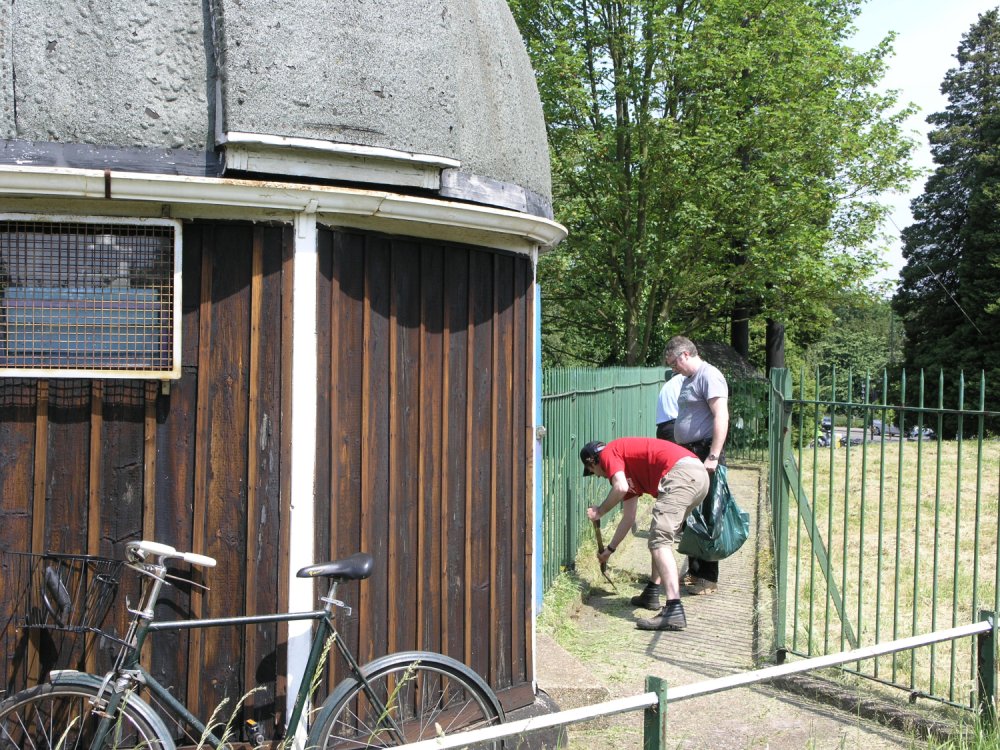
It is now a firmly established tradition that the Observatory working party takes place on the hottest day of the year. We saw no reason to break with tradition this time and true to form, the date chosen, Sunday June 11th 2006, saw temperatures soar to the 30 deg.C mark!
After last year's exertions we decided to take things a bit easier this year and confined our activities to general tidying up and repairs.
This year the crew consisted of the Astro. Sec. and assistant Sec. Simon Lang, John Tennant, Jerry Workman, Jim Brightwell, Daniel Pooley and Gary Marriott. This was Gary's final duty as he is off to Canada in the autumn. We thank him for all his past help and wish him luck on his travels. Julia Daniels provided refreshments and after a good few hours in the blazing sun we managed to clear the path and steps of weeds, repaired a hole in the dome covering and replaced one of the broken step lights. The Observatory was swept and dusted and the telescope was given a good clean ready for the new session in September.
The Assistant Astro. Sec., Simon Lang arranged a special 'planet watch' on the evening of Saturday June 17th as Mercury was at its greatest eastern elongation. Additionally, Mars and Saturn were just ¾ of a degree apart, low in the north west. The strip of heath at the end of Judge's Walk at the top of Windmill Hill was chosen as a viewpoint as this location has a good north-western horizon. A few members and about a dozen visitors attended at sunset. Brian Bond brought his portable 150mm refractor, but unfortunately, horizon murk prevented any observation of the elusive Mercury. We did, however, manage to see the Mars/Saturn conjunction and then returned to the observatory to observe Jupiter. The planet's low declination and unsteady atmosphere made observation difficult but the S.E.B was seen to be very broad with much complex detail and a thin belt at the centre of the E.Z.
During early July 2006, Near Earth Object (NEO) 2004 XP14 passed earth at a distance of just 430,000 km. The 400 metre diameter rock moved rapidly through the constellation of Draco, which was almost on the zenith, at about a degree/hour. Its closest approach was on July 3rd, a day on which temperatures had reached 31 C! Hazy sky conditions and a near first quarter moon prevented observation of the 12th magnitude asteroid.
On the morning of August 9th under a cloudless blue sky, I took a look at the Sun at 11.20 B.S.T. with the 150mm Helios refractor. The solar disk was totally blank, not even the smallest sunspot was visible. We must be getting close to or at solar minimum.
No special arrangements were made to observe the annual Perseid Meteor shower this year as maximum, on August 12th , coincided with a nearly full moon. It is no longer feasible to observe such events from the Observatory due to atmospheric and light pollution.
On the 7th of September there was a partial lunar eclipse but it was not favourable from our location. The moon rose at about 18.45 UT with the northern limb just clipped by the Earth's shadow and by the time the moon was just a few degrees above the horizon the umbral phase was over. In any event cloud prevented any observation.
Cloud also prevented any observation of the lunar occultation of the Pleiades on the night of September 12th. Again, this event took place before moonrise from our location and by the time the moon had attained any altitude the event was over, but Terry Pearce reported seeing the tail end of it from the clearer skies of Cambs.
In mid-September we were alerted to a new comet- Comet 2006 M4 (SWAN) due to reach perihelion in late-September. It was predicted to reach mag. 6 in October, when on the 9th , it would be located midway between the star 14 Canum Venaticorum and alpha C.V. (Cor Carolli).
This year we had to delay the resumption of public open nights until the last weekend in September. This was due to shortages of demonstrators. We are sorry to lose the services of Garry Marriott who is 'globe trotting' in Canada and China and Simon Lang had been experiencing a bout of ill health. We hope Garry will return one day and wish Simon a speedy recovery. The first weekend of the session was accompanied by very unsettled showery weather and no observations were made.
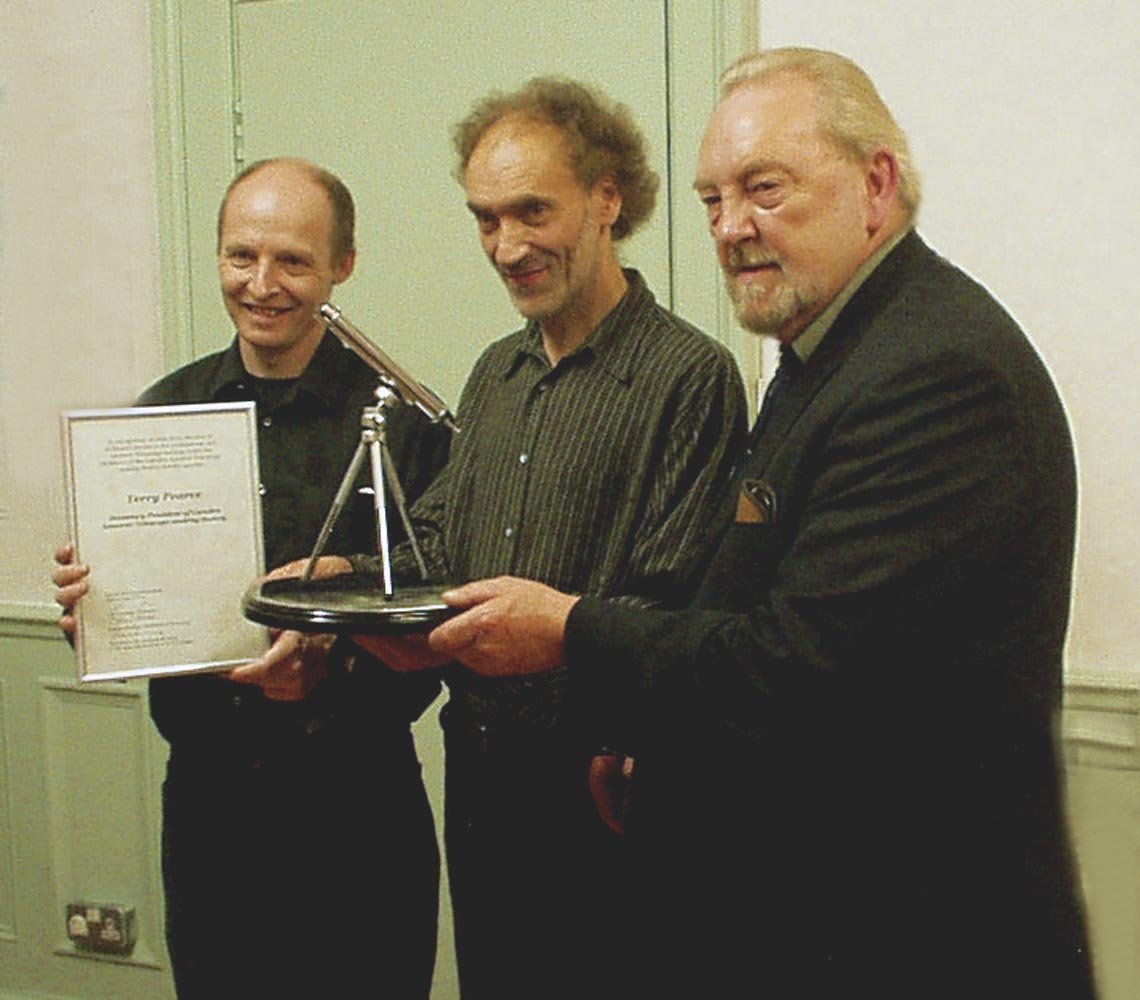
On the evening of October 11th, members of the astronomy section joined past and present members of Terry Pearce's telescope making class, now affiliated to the HSS as C.A.T.S (Camden Amateur Telescope-making Society), to present Terry with a certificate and trophy, designed by Simon Lang. The presentation was made by the Astro.Sec. to thank Terry for running the class for a period in excess of 30 years and for teaching and encouraging many amateur astronomers to make their own mirrors and telescopes.
The Observatory received some more publicity this session when the makers of the television programme 'Disappearing London', decided to feature it in the series. The programme was shown on ITV on January 16th 2007. After two abortive attempts to film, cancelled at the last moment due to bad weather, a television crew finally descended on the Observatory on October 16th. The Astro. Sec. was interviewed by their presenter 'Suggs' xe2x80x93 the ex lead singer from the pop group 'Madness' to film a short report of the history and activities of the Society and the Observatory.
Poor weather conditions and bright moonlight had prevented observation of Comet 2006 M4 (SWAN) until the evening of November 9th, when the Astro. Sec. managed to find it with 20x80 binoculars at 18.25 hrs. from Finchley. The Comet, positioned just north east of the star 102 Herculis, appeared as a small diffuse patch, looking slightly brighter, estimated at Mag. 6, than the predicted Mag. 9.2. It was later reported that the comet had indeed undergone a flare up increasing to Mag. 4 on one occasion. Terry Pearce, observing from Weston Colville CAMBS. Reported seeing the comet in the early evening of the 18th Nov. It was then close to the star zeta Aquilae and appeared then to be at about Mag.8.
Following a report that there might be a late maximum for the Leonid meteors in the early hours of November 19th, the Assistant Astro. Sec. Simon Lang and a couple of hardy members descended on Paul Clements to observe from a dark location. Early cloud eventually gave way to clearer but misty conditions. John Tennant managed to see about twenty or so meteors, one almost bright enough to be regarded as a fireball, but overall it was not the spectacle hoped for. But with 4 telescopes in use and a limiting magnitude of +6, it presented an opportunity to observe a few of the deep-sky objects now denied to us from light polluted Hampstead. Later on the19th, the sky cleared in London and the Sunday morning session at the observatory was well attended by visitors. There was a fairly prominent sunspot close to the eastern limb and quite a number of solar prominences to be seen through Brian Bond's Coronado H alpha telescope. Solar minimum may now have passed and we could be seeing the beginning of the next Solar Cycle.
There were several clear nights at the Observatory in early December, but not unfortunately on the evening of Wednesday the 13th when the Assistant Astro. Sec. had planned to open the Observatory between 10 pm and midnight to observe the Geminid meteors.
2007
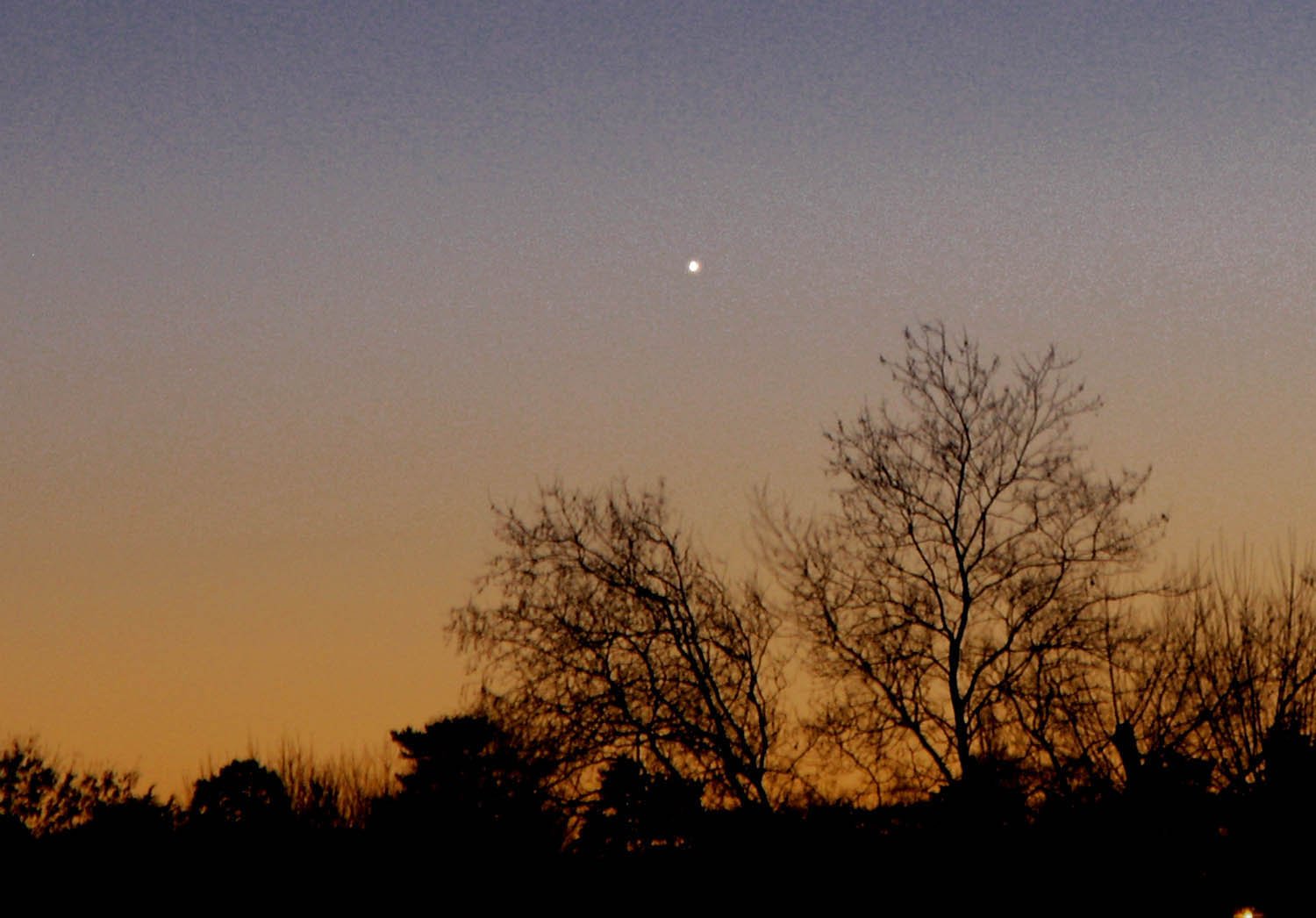
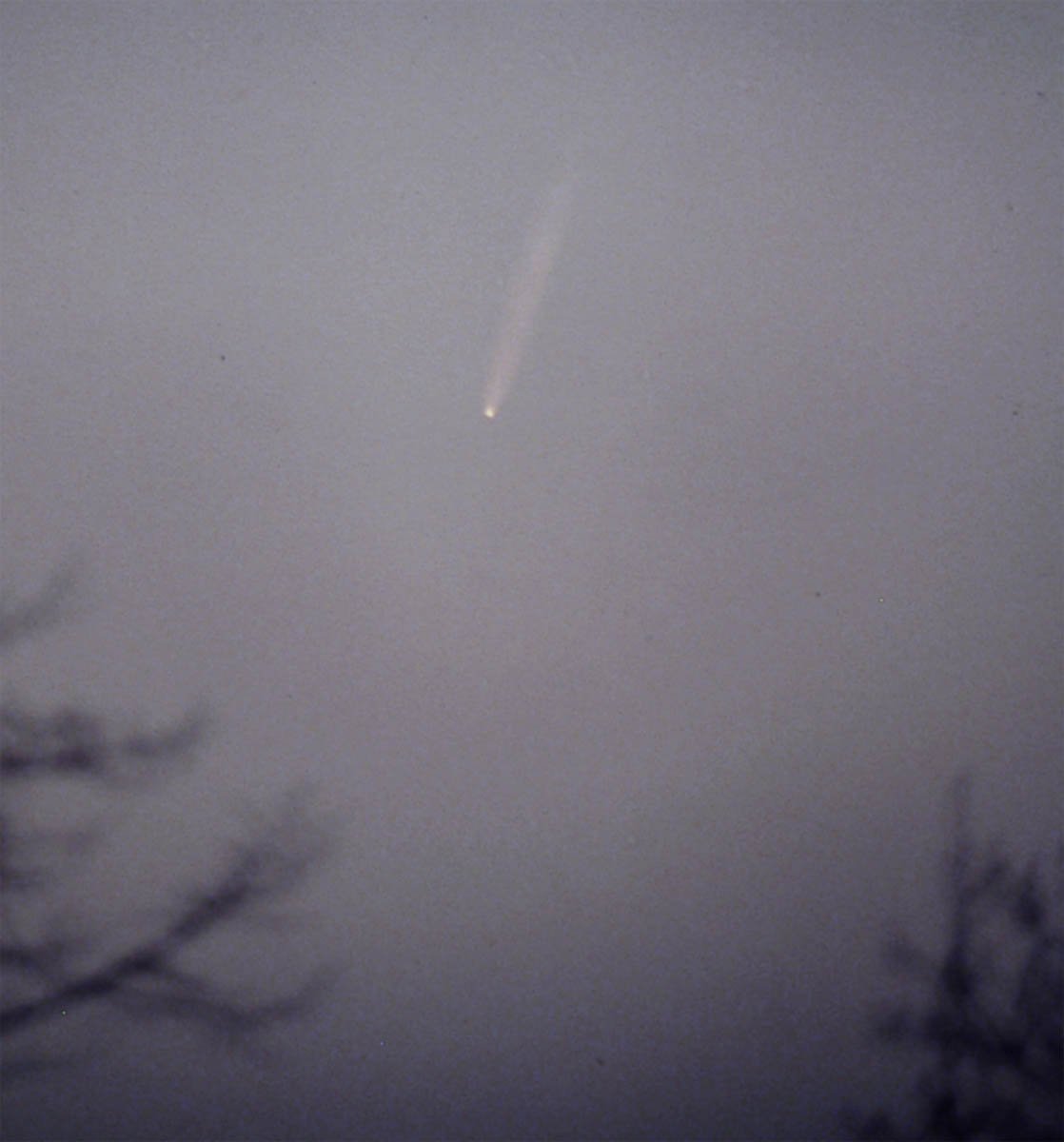
2007 began with news of a new and possibly bright comet; Comet McNaught. The comet (C/2006 P1) was discovered by R.H.McNaught at Siding Spring in August. Its perihelion passage took place in January, within the orbit of Mercury. Early in that month it moved into the evening twilight sky where it was reported at about mag. +3. The Astro. Sec. looked for it in a rare clear sky after sunset on Jan 10th but failed to see it; it was probably below the horizon but Venus was well seen. On Thursday Jan 11, Simon Lang reported seeing and imaging the comet from the roof of a tall building close to his home in Hampstead and Daniel Pooley observed it from Parliament Hill. They described it as having a bright nucleus, about as bright as Jupiter (mag.-2), and a long broad tail extending for at least 5 degrees. It is evident that the comet must have experienced a flare-up as it attained a magnitude far greater than that predicted. It was unfortunate that from this latitude, the comet was only visible for a few days, close to the south-western horizon in a twilight sky. The sudden flare-up caught us all napping. It just goes to show that comets are unpredictable beasts.
On Wednesday 7th February there was a rare conjunction of Mercury and Uranus. With Venus just a few degrees eastward, it promised to be an attractive event. Simon Lang organized a special session on Parliament Hill, which has a less obstructed S.E.horizon. Several members and visitors turned up but the weather let us down again with cloud masking Uranus. However, Venus and Mercury were well seen in the gathering dusk
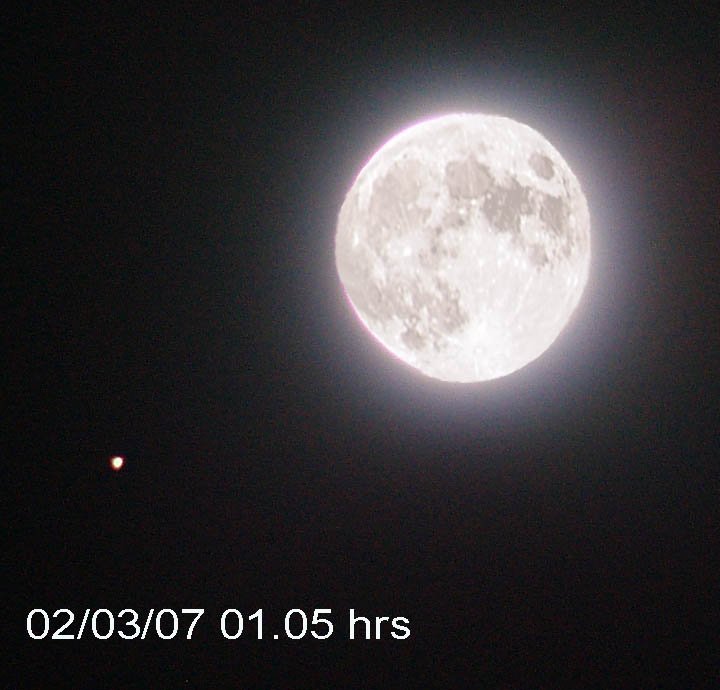
Amazingly, the occultation of Saturn, in the early hours of the 2nd of March, coincided with a clear night! As the occultation took place at 02.43.1 hrs UT, we did not open the observatory for the event, particularly as we were anticipating a long session just one day later for the total lunar eclipse.
After a cloudy showery day, on March 3rd, the skies cleared at sunset to allow us to enjoy the full splendour of the total lunar eclipse. Fortunately occurring on a Saturday night and at a reasonable time, the event was enjoyed by over 100 visitors to the observatory. Totality began at 22.44 hrs and lasted until 23.57 hrs. This gave everyone the opportunity to observe it through the several telescopes and large binoculars set up for the occasion. The Astro. Sec. set up his eclipse camera, now digitised and obtained many images of the event. Special thanks to Simon Lang, John Tennant, Daniel Pooley, Jim Brightwell for their assistance on a long session that extended until past 001.00 hrs on the 4th.
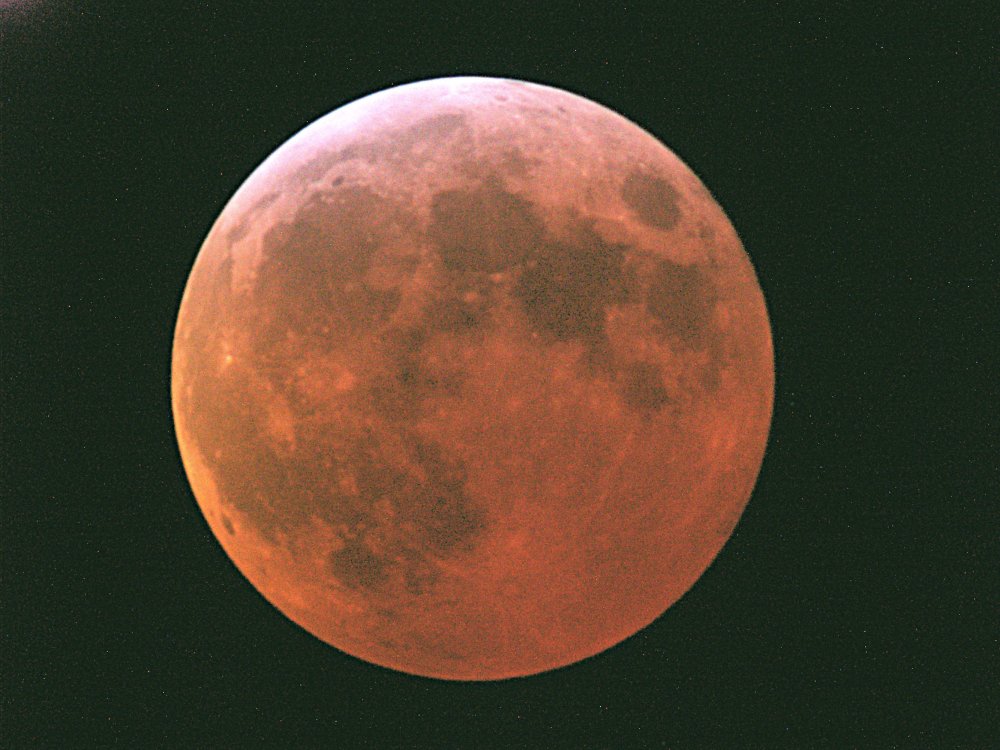
Once again the Observatory was opened throughout Science Week: 9th-18th of March. The advanced publicity ensured that over 60 visitors turned up for the Sunday morning session on the 11th, a beautiful mild Spring morning. It was unfortunate that the Sun presented us with a totally blank disk xe2x80x93 not a single sunspot to be seen but one or two prominences were observed with Brian Bond's H alpha telescope.
The weather co-operated partially during Science Week and visitors were treated to some splendid views of Venus and Saturn. The session on Saturday 17th saw upwards of 50 visitors at the Observatory, but was marred by poor weather, with only occasional glimpses of the ringed planet through thin hazy cloud. The ring system was open to its greatest extent in 2003- 2004 and is now beginning to close up, presenting a very attractive aspect of the planet. The south equatorial belt had a distinct reddish tint which can be seen in the picture taken on 21/04/07 at 22.34hrs. by the Astro. Sec.
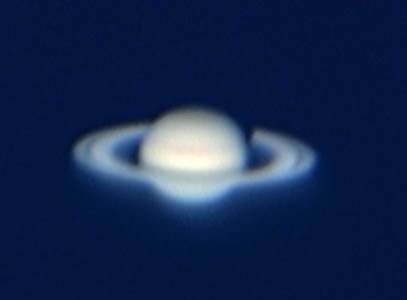
Towards the end of March we were alerted to the close approach of Asteroid 2006 VV2 discovered by the LINEAR programme in November last year. Its closest approach at 0.0226AU or 8.8 lunar distances, was on March 31st. On March 29th it passed within 25 arcmins. of the galaxies M81 & M82 in Ursa Major at which point it was a 10th magnitude object but unfortunately, as I all too frequently have to report, cloud and rain prevented observation. Observation was further prevented on the following three days due to an almost full moon and dreadful atmospheric pollution. On the 1st of April, in Finchley the limiting magnitude was 2 and on the 2nd it was 1.
We decided to extend the observatory open evenings past the normal mid-April closing date, into early May. This was to give visitors the opportunity to observe Venus and Saturn. Venus was particularly favourable this year, its greatest eastern elongation occurring on June 9th, heading for inferior conjunction on August 18th. We opened over the Easter weekend and were blessed with unusually fine weather but cursed by high levels of atmospheric pollution.
As has now become the custom, the Society participated in the annual Hampstead and Highgate Festival by arranging three late night sessions at the Observatory on the evenings of May 12th, 13th and 17th. Despite continual rainfall during the daytime, the clouds parted briefly on all three nights to provide visitors excellent views of Venus, at a phase close to dichotomy and Saturn, always a favourite subject.
On Sunday May 27th, despite heavy rain, upwards of 30 members attended the visit to the Planetary Imaging Facility at University College, organized by Julia Daniels. Our host, Dr. Peter Grindrod, allowed visitors to explore the many images of Solar System objects, planets, satellites, asteroids, comets etc, many at remarkable resolutions, on file within the facility. He also gave three hour long illustrated presentations to accommodate visitors arriving at staggered times. Our thanks to Julia for arranging this fascinating visit and to Peter Grindrod for giving up his Sunday to entertain us.
Unfortunately, the poor weather over the Spring Bank Holiday weekend prevented the proposed astronomical picnic from taking place. The picnic, arranged by Simon Lang, was to have taken place on the first clear night on either 27th, 28th or 29th of May, to coincide with favourable observation of Mercury, Venus, Saturn, the Moon and later Jupiter. Unfortunately, all three nights suffered from cloud, rain and unseasonable cold winds.
Once again the Astronomy Section has had a very busy and eventful year. To maintain this level of activity requires the participation of many members who give so much of their time to the Society. This year we were sorry to lose the services of two demonstrators and one assistant. Garry Marriott has left the country and John Hayden who has demonstrated for 30 years felt it time to retire as did Gordon Harding. We thank Garry, John and Gordon for all their help in the past and on your behalf, I thank all members of the section for their continued interest and help.
Doug Daniels (Astro. Secretary)
Doug / Julia Daniels (Astronomy Secretaries)
It was decided at the end of the session, that the annual Observatory working party, which has for the last several years, taken place in August, would be moved forward by a couple of months. Having endured uncomfortably high temperatures for this event in the past, we thought it fairly safe to choose June as the weather is usually cooler and unsettled around this time of year. Not this year! The weekend of the 18th and 19th of June saw the temperature soar up to a level in excess of 30 degs. C! On Sunday afternoon, I looked at the air temperature thermometer in the Stevenson screen and it read 30.75 degrees C!
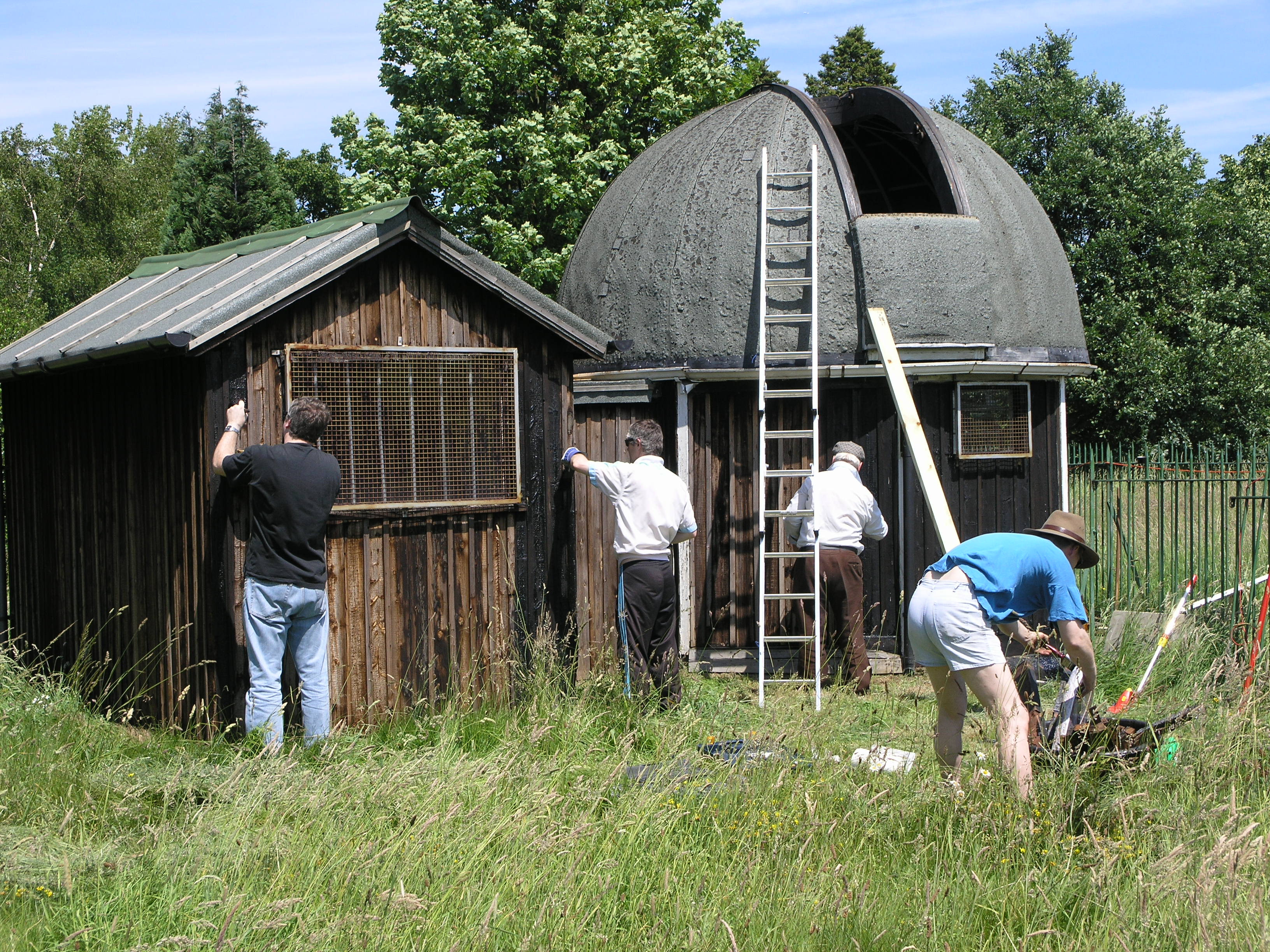
We decided to work over two days this year, as during the last session we were experiencing considerable difficulties opening the dome shutter. On occasions, it would resist all attempts to get it open. Clearly, something was amiss. Simon Lang and I went up on the Saturday and decided to strip off the roofing felt covering to examine the structure. We were soon able to examine the structure very closely indeed as it collapsed in to a pile of 24 wooden strips. All the joints had rotted and it was only the felt covering that was holding it together!
Our first task was to mark each piece with a number and draw a diagram to indicate where each piece fitted. Every piece of wood was curved in two directions and we had to admire the craft of the original dome maker. Some parts were too far-gone to restore and Simon was then able to demonstrate his skill at woodwork by making replacements.
We decided to totally restore the shutter frame and then re-cover it in 1.5mm aluminium sheet. The frame itself was to be strengthened with strips of stainless steel and the roller bearings, some of which had seized and worn to flats, were to be restored. This would result in a shutter lighter in weight that should make it easier to open. In a year or so it is our intention to totally re-cover the entire dome with sheet aluminium. This should result in a permanent repair and the lighter weight will take some of the stress out of the structure and out of the demonstrators who have to haul it around!
We had a very good response to the appeal for volunteers for the working party this session, despite the uncomfortable temperature. Braving the heat were: Simon Lang, John Hayden, Jerry Workman, Garry Marriot and Ron Smith. Ron spent the entire day applying Creosote to the building, a filthy job at the best of times. John, Jerry and Garry cleared the stairs and path of weeds and helped Ron with the creosoting and later Garry climbed to the top of the dome to cover the slit with polythene sheeting as a temporary cover. Julia made sure that we were all well fed and watered with sandwiches and tea. Our thanks to all the volunteers who laboured long and hard under a blazing sun.
Although the annual display of Perseid meteors was due to take
place under favourable conditions of moonlight, no special
arrangements were made this year. Our main focus was set on getting
the observatory shutter repaired so that the observatory would be 'up
and running' for the forthcoming opposition of Mars in the autumn. The
restoration of the shutter frame was proving to be a much bigger and
more time consuming job than we had anticipated.
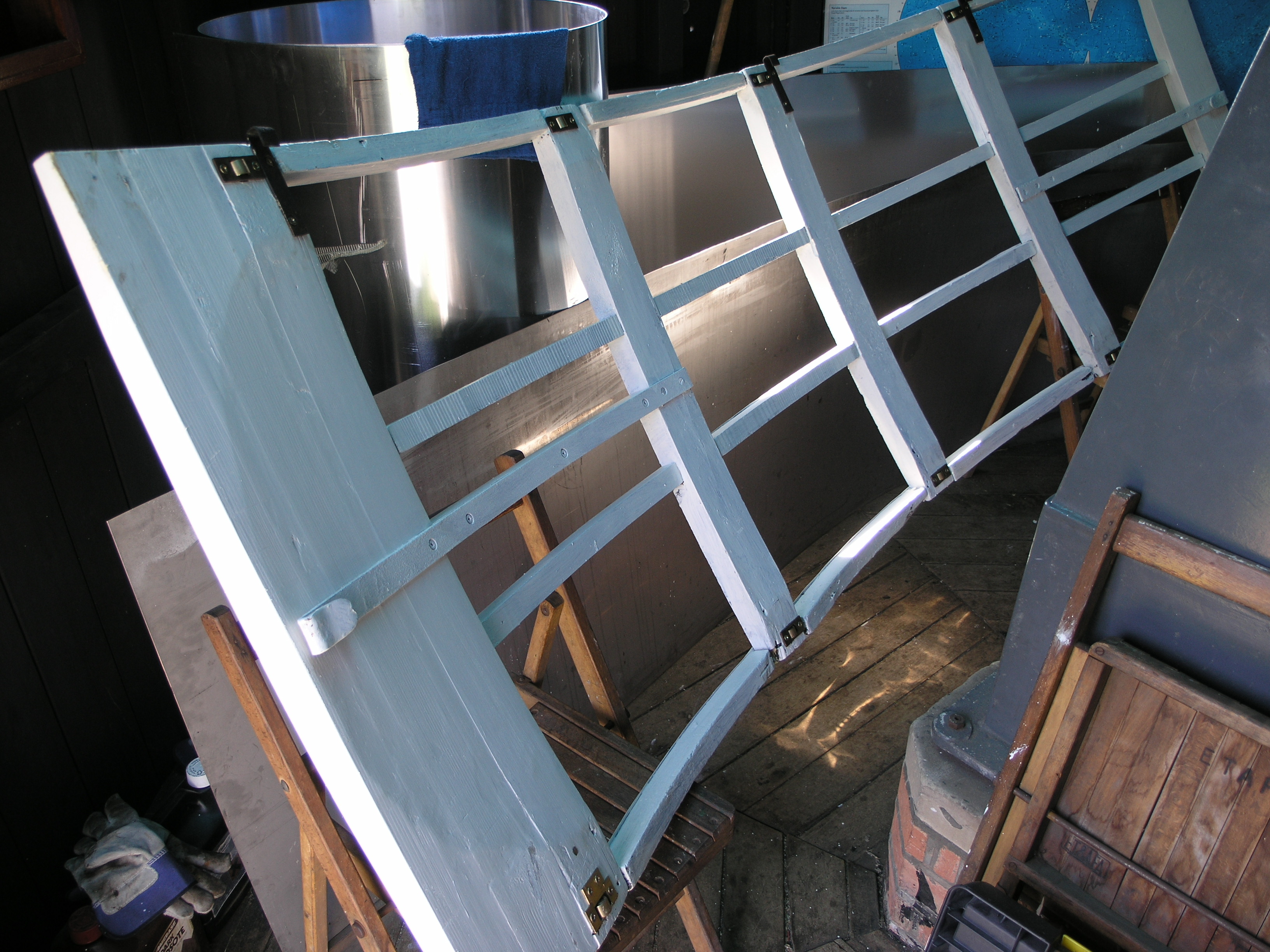
On August 31st. Simon Lang and myself spent a full day working to re-assemble the shutter frame, and yes we again managed to choose a day when the temperature soared up to 30 degrees C! The four stainless steel strips had to be drilled with innumerable holes, a trying process that resulted in breaking many drill bits, showering us with hot painful swarf and turning the air blue with curses! We then had to face a three dimensional jig saw puzzle and screw all the wooden components on to the steel strips, Nevertheless, by the end of another hot tiring day, the main framework was totally re-built. On the following day, I went back and painted it with primer.
Simon and I continued the work on Sunday Sept. 4th and of course, the temperature reached 29 degrees C! Simon had done a grand job of restoring the rollers, having had to fabricate one missing roller from scratch, and these were refitted to the frame along with the six retaining clips that hold the frame on to the rails. We selected three of the best originals and made three new ones from stainless steel. All we had to do then was to cover the whole thing with 1.5mm sheet aluminium and, of course, put it back in position.
This is where we encountered the first snag. It soon became apparent that covering the frame with one continuous sheet was impossible. This was because the frame was crafted as a true section of a dome and was curved in two directions. The job was made all the more difficult because the frame was also designed to be flexible. We finally decided to fabricate the aluminium covering in four separate sections. By the end of another hot tiring day we had one section roughly in place.
Work continued on the following day and with the help of Simon's friend Mat, the three of us were able to haul the restored shutter frame with the loosely tacked covering, back into place on the dome rails. We were then able to begin to apply the aluminium sheeting. We had to do this with the frame in-situ to ensure that the frame did not become distorted. By the end of the day we had half of the covering in place.
After yet another day's work, the shutter was totally re-covered and the cords and counterweight re-fitted. It was with a sense of enormous relief and not a little self-satisfaction, that when we pulled on the rope, the shutter opened smoothly and without too much effort. The restoration of the shutter has taken a lot of time and effort, and there were times when I wished that we had never started it! The section is greatly indebted to Simon Lang for all the work he has put into this project.
New session September 2005
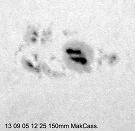
Public demonstration nights resumed on time on the weekend of 16th 17th and 18th of September. The weather was kind but there were no bright planets to observe and the Moon, full on Sept 18th did not help with observing faint objects. Despite the approaching solar minimum, there was a large sunspot group visible and I managed to obtain a digital image of it on Sept. 13th with my 150mm Maksutov Cassegrain despite the presence of some thin diffuse cloud.
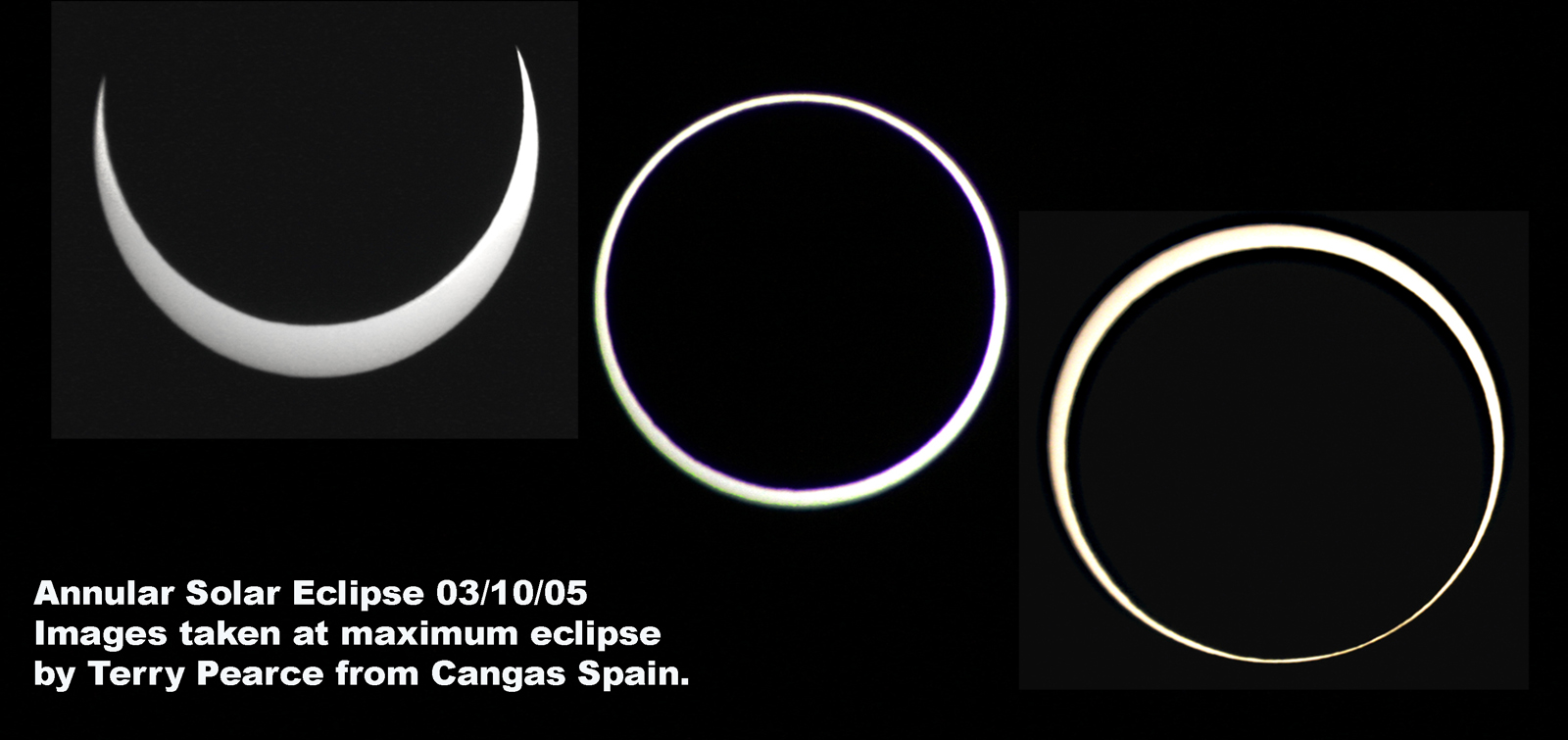
On Monday 3rd of October there was an annular eclipse of the Sun, visible as a partial eclipse from Hampstead. The eclipse was due to commence at about 8.50 B.S.T and to continue until about 11.15 B.S.T. Simon and I opened up the Observatory but total cloud cover prevented any sight of the Sun. It remained totally overcast until about 1.30 pm when the cloud cleared for about a couple of hours. Five of our members journeyed to foreign parts to observe the annular eclipse. Terry Pearce, Jim Brightwell and Jerry Workman went to Spain and Jacquey and Alfred Oppenheimer went to North Africa.
By the middle of October, Mars was beginning to become available for observation. Situated on the borders of Aries and Taurus, it was well placed for northern hemisphere observers. Although the opposition was not as close as that of two years ago, it still presented a disk some 20 seconds of arc in diameter, large enough to reveal considerable surface detail. However by October 18th we were informed that a dust storm was in progress. It had started on the south border of Chryse on October 13th and was spreading along the Valles Marineris. A similar dust storm occurred during the 2003 opposition.
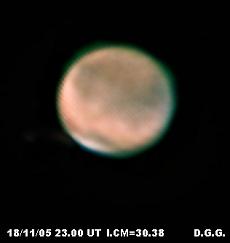
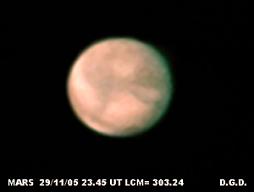
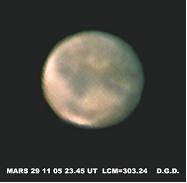
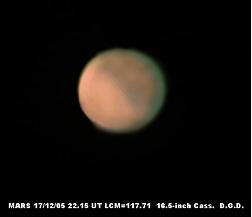
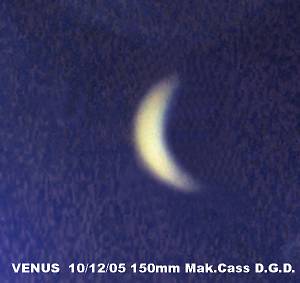
By the time of opposition on the 7th of November, I was receiving numerous requests from members of the public who wished to come to the observatory to observe Mars and on the occasions when the weather allowed, attendance at the observatory was good. However, it was nothing like the volume experienced during the close opposition of 2003. This is due to the media largely ignoring this opposition despite it being better than that of 2003 for northern hemisphere observers.
In early November the weather was kind to us with many clear nights but the atmosphere was rarely calm. However, on the night of Nov.20th high atmospheric pressure (30.75ins Hg) provided reasonable image quality and I secured a decent image with Sinus Meridiani approaching the central meridian (CM) and a haze on the western limb which was evidence of the dust storm in progress along the Valles Marineris. By Nov.29th Syrtis Major was close to the CM coinciding with another clear frosty night on which I managed another reasonable image. By early December Mars' disk was already becoming noticeably smaller. Its diameter was down to 16.1 secs. of arc on Dec 6th when I secured an image showing Mare Cimmerium with Trivium Charontis seen as a small dark spot in the Amazonis desert.
During November and December 2005, Venus was making its presence felt in the south-western twilight, achieving its greatest eastern elongation on November 3rd. By Christmas it had attained a reasonable altitude and was visible in a dark sky, rapidly heading for inferior conjunction on January 13th 2006. I obtained an image of the planet on Dec.10 with a 150mm Maksutov Cassegrain telescope.
2006
2006 began with a period of bad weather with few clear nights. The
Earth was rapidly moving away from Mars, whose diameter was a mere 9
arc secs when the clouds parted on the weekend of 20th-21st. The tiny
gibbous disk revealed little surface detail.
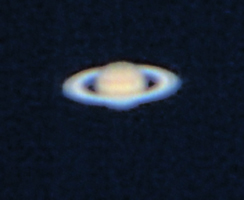
As Mars receded, our attention switched to Saturn, situated close to M44 Praesepe the beehive cluster in Cancer and coming to opposition on Jan. 27th. The rings, still well displayed, were just beginning to close so that the pole of the planet could be seen above them. This is one of the nicest aspects of the planet, and the view was much appreciated by a good crowd of visitors who gathered at the Observatory on the evening of Jan. 21st. The north equatorial belt was quite prominent and appeared double. Later that night, I obtained an image using a webcam. on my 150mm Maksutov Cassegrain, processed with RegiStax.
The weather throughout February was generally poor with few clear nights at the Observatory, but on the rare occasions when the clouds parted, attendance was good. Sunday morning sessions were poorly attended and there were few sunspots to observe as we are now approaching sunspot minimum. On several occasions, Brian Bond set up his Coronado H alpha telescope, through which some small prominences were observed.
Once again, the Society participated in Science Week, March 10th - 17th 2006. The astronomy section arranged an illustrated talk, given by the Astro. Sec. to both University College School and South Hampstead High School. The talk, entitled Welcome to the Universe, was very well attended at both sessions. Apart from the normal weekend opening sessions, the section also arranged for the Observatory to be open every night between 13th and 16th irrespective of weather conditions. When clear, observations were made but when cloudy Simon Lang kindly volunteered to talk to visitors about telescopes and their design. The weather was not kind and only two of the possible 9 nights allowed any observations. The bad weather persisted on the 18th when some 22 members of the Hampstead Women's Club visited the Observatory. Our thanks to Simon and all members of the section who turned up to add their support during a busy week.
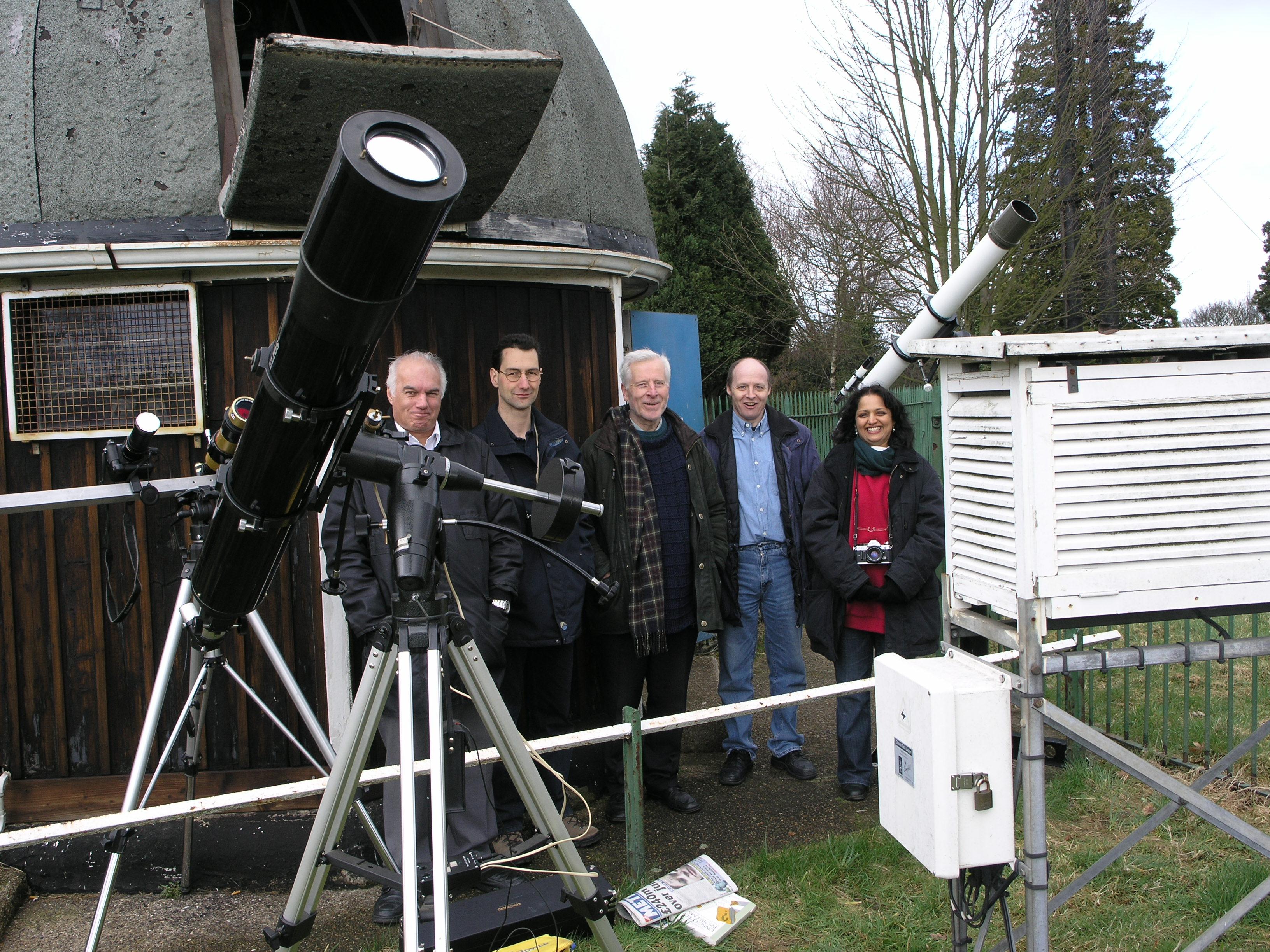
On 29th of March 2006 there was a total eclipse of the Sun. The track of totality crossed parts of northern Africa and southern Turkey. In London, the eclipse was partial, about one third of the Sun obscured. On the morning of the 29th several members attended the Observatory, bringing an assortment of portable equipment with which to observe the eclipse. Brian Bond set up his Coronado solar telescope, Simon Lang brought a 4.5-inch refractor, complete with binocular eyepiece and the Astro.Sec. set up his 6-inch Helios refractor.
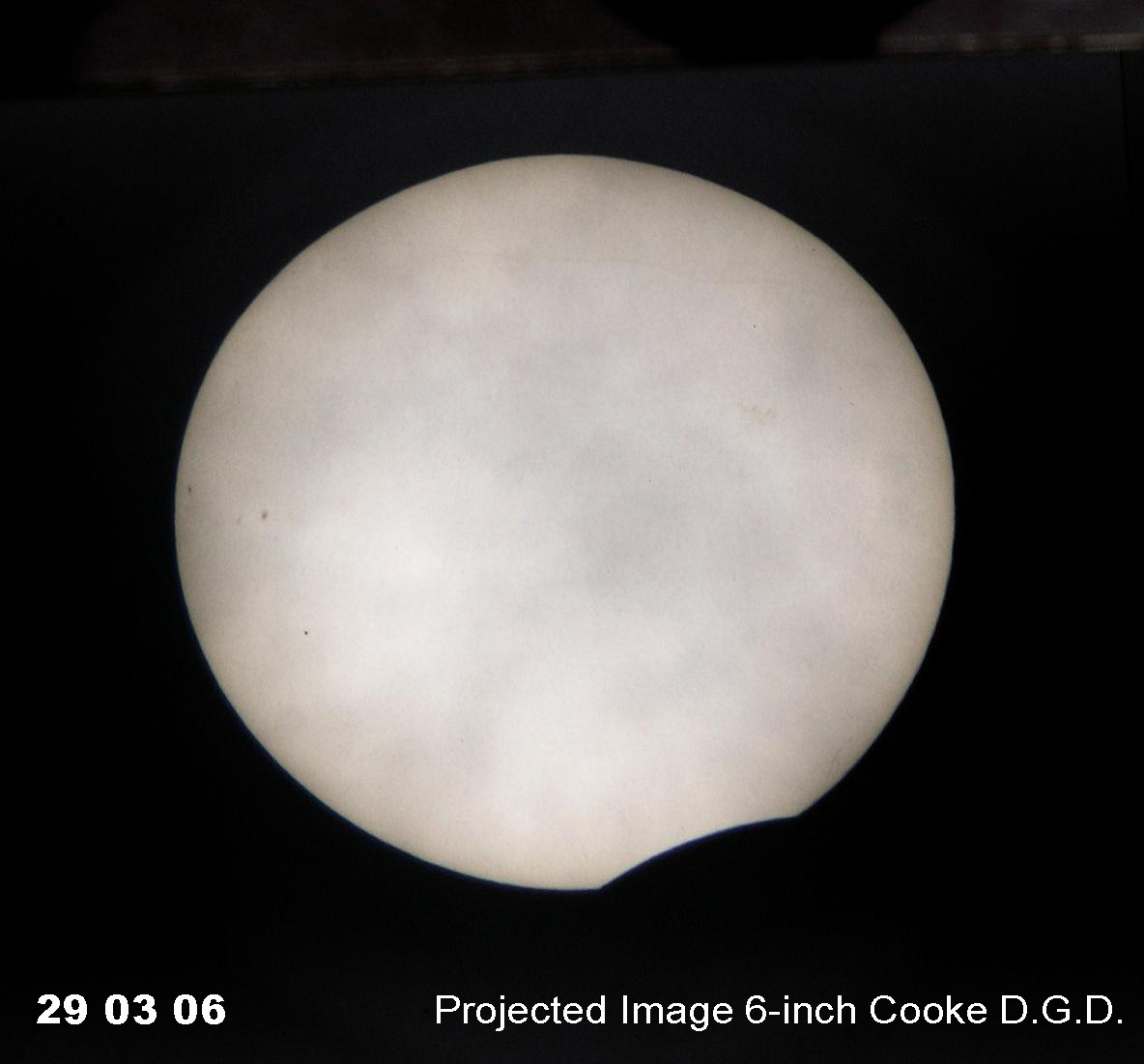
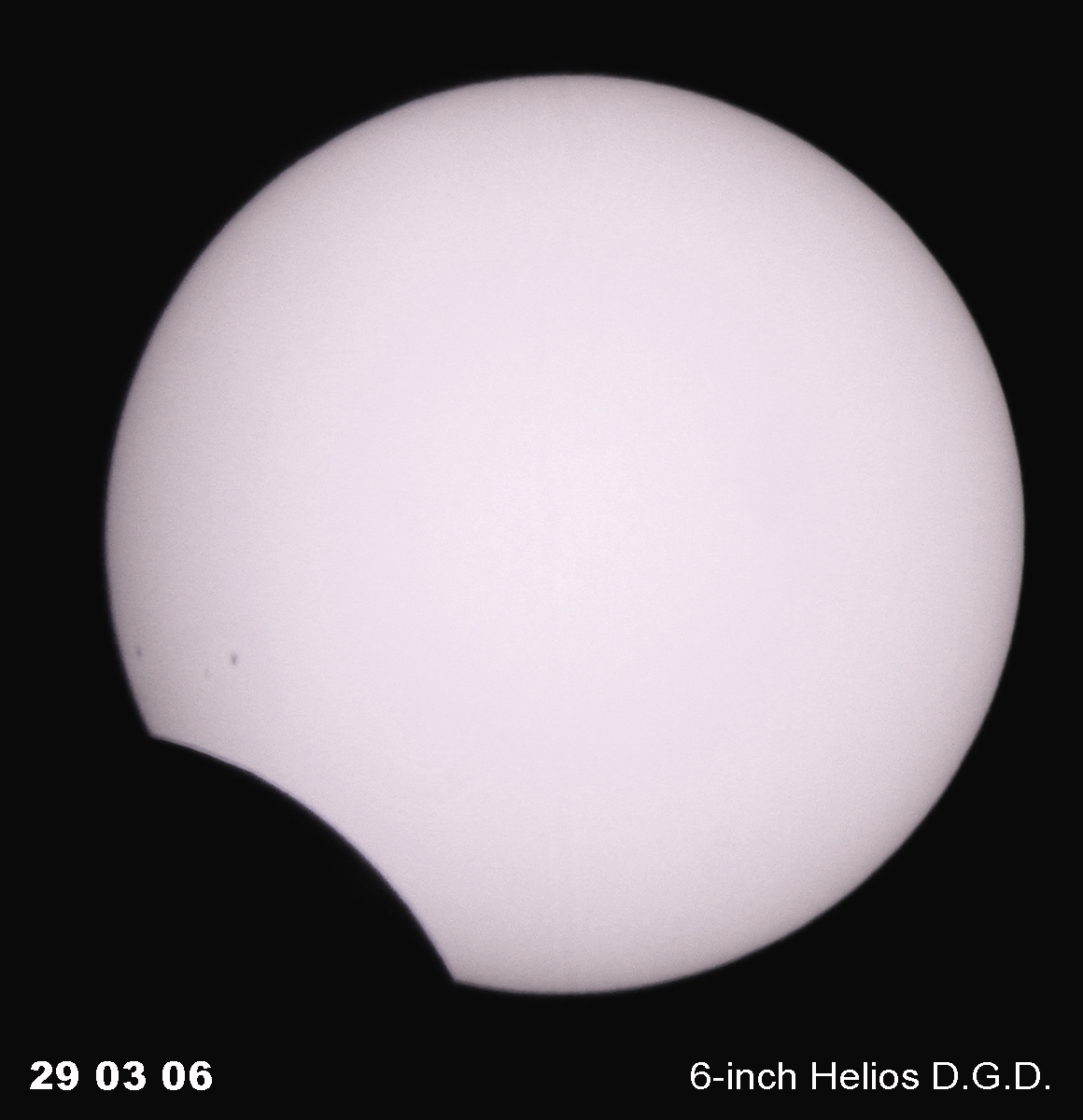
The 29th had dawned brightly but by the time of first contact 09-45.1 hrs U.T. (Greenwich). the skies were totally overcast. However, a few minutes later, a small clear patch allowed a brief glimpse of the start of the eclipse. From then on we had to wait for the clouds to part to allow us brief tantalizing glimpses of the advancing Moon. There was a small group of sunspots close to the Moon's limb and the view through Brian Bond's Coronado hydrogen alpha telescope revealed a number of short-lived prominences adding greater interest to the event. The Astro. Sec. managed to take a few digital images through his 6-inch Helios refractor, equipped with an objective filter, making the most of a few clear moments but the skies remained relentlessly overcast at maximum eclipse.
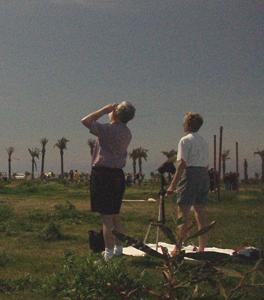
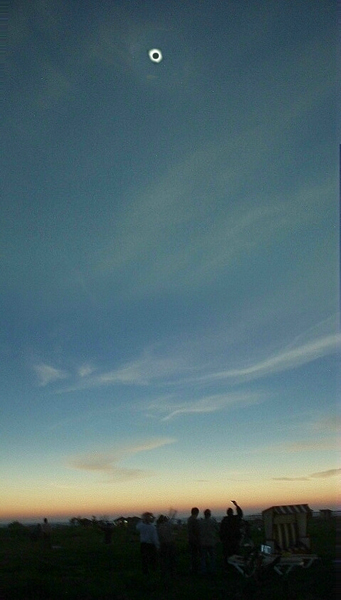
The classes of schoolchildren, who were due to come,
failed to turn up, but about 40 or so members of the public attended,
some with the organized Hampstead Walks. The eclipse ended at 11-22.3
UT (Greenwich). It was an interesting event spoiled once again by bad
weather. We were pleased to hear that our colleagues who traveled to
Africa and Turkey to witness totality, faired better. According to our
own 'eclipse chaser', Jim Brightwell, it was amongst the best total
eclipses that he had witnessed.
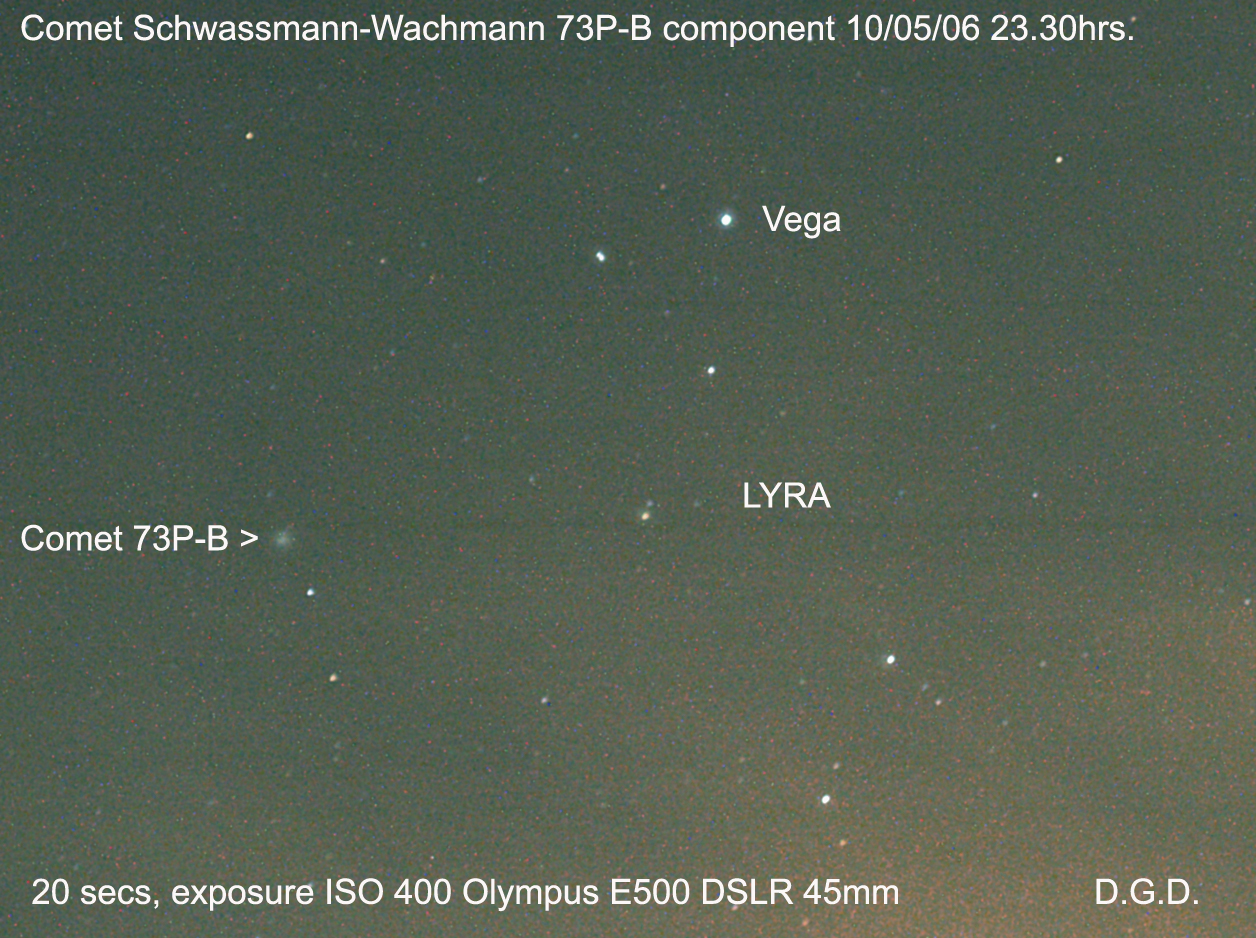
Public open nights at the Observatory ended on Saturday April 15th, but the work of the Section continued. On the nights of May 8th and 10th there was an opportunity to pick up Comet Schwassmann-Wachmann. This comet is breaking up and there are two main components. On May 8th the southern component, 73P-C, was due to be in the same field of view as M57 Lyrae and on May 10th, the northern component, 73P-B, was close to epsilon Lyrae. Both components were predicted to be at about 5th magnitude. On May 8th it rained during the day and there was total cloud cover at night. Had it been clear, observation would have been hampered by the presence of an 11 day old Moon. On the night of the 10th, Terry Pearce, observing from the darker skies of Weston Colville in CAMBS, reported seeing the 73P-B (northern) component in 15x70 binoculars as a small diffuse shuttle shaped smudge. Seeing conditions were poor with a 3/4 moon and haze. I searched but conditions were even worse in Finchley and I saw nothing. I had more success on the following night when despite the presence of a bright Moon, I just managed to see it with 20x80 binoculars and even managed to record it in a 20 second exposure with an Olympus E500 DSLR camera. Terry Pearce managed to see both components in the early hours of the 16th May, on a particularly clear night in Weston Colville, at which time both components were heading for Pegasus. Terry reported that the northern component was by far the brighter, shuttle shaped with one or possibly two short tails, seen in 15x70 binoculars.
Following a protracted bout of ill-health, Julia Daniels felt it was at last time to lessen her work-load and has resigned as joint Astronomical Secretary. Simon Lang was appointed Assistant Astronomical Secretary at the Council meeting of April 12th. Julia will still look after the section's finances but Simon will gradually take over her other responsibilities. Julia has worked tirelessly for the Society since the 1950's and the Astronomical Section owes her an enormous debt of gratitude for the hours spent arranging the roster year on year and ensuring that the section always remains solvent. We thank Julia for her devotion to the section and welcome Simon to his new position.
We were also sad to loose the services of Ron Smith from our band of Assistants. Ron felt that age was at last beginning to take its toll and that considering the distance that he had to travel, duties in the winter were becoming a burden. We thank Ron for all his help in the past and wish him well in the future.
The Observatory re-opened for three sessions on 13th, 14th and 19th of May as part of the Hampstead and Highgate Festival. Unfortunately, the weather was bad, overcast and raining on all three occasions and visitors had to put up with talks from the Astro. Sec.
Following an enquiry concerning the Observatory, by a member of the public on the Robert Elms 'phone-in' show on BBC radio London, the Astro. Sec. was invited to the studio and interviewed 'on-air' on Monday 22 May. This was a totally unexpected but welcome opportunity to publicize the Society and the forthcoming Jupiter watch to a London-wide audience.
On the nights between May 24th and 28th, Simon Lang organized a
special session at the Observatory to give visitors an opportunity to
observe Jupiter before the planet is enveloped in the horizon murk for
the next several years. Unfortunately, once again the weather refused
to co-operate and it remained cloudy throughout the entire five
nights, but this did not deter quite a few visitors some of whom
managed a momentary glimpse of the planet through scudding cloud. This
was a great pity, as at the moment there are changes taking place in
the cloud belts in the vicinity of the Great Red Spot (GRS). A number
of white ovals, which first appeared in 2000 have merged into one
large spot about half the size of the GRS. It is now reported to be
turning reddish-brown. Could this new feature develop into another
long-lived anti-cyclonic spot similar to the GRS? We will have to wait
and see.
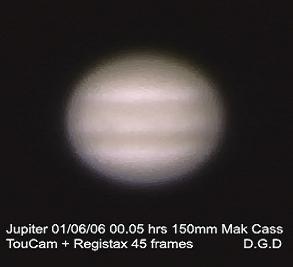
Because of the poor weather during the planned Jupiter watch, Simon decided to try again on the nights of June 2nd and 3rd . This time we met with greater success with both nights clear. On the 2nd of June the Great Red Spot was right on the central meridian but it was not red. It seems to have faded. Similarly, the new spot was not at all conspicuous. However, the north equatorial belt (NEB) has developed into a very broad feature, extending far into the equatorial Zone (EZ) The south equatorial belt (SEB) was also very prominent and distinctly red tinged. On June 3rd we noticed a thin dark belt in the center of the equatorial zone. There are obviously great changes occurring on Jupiter at the moment. Unfortunately, Jupiter is now below the tree line of my 16.5-inch telescope so I have to use the portable Mak Cass. I managed an image of the planet on the night of May 31st with a TouCam webcam processed with RegiStax.
Due to cutbacks by certain short-sighted local authorities, many adult education evening classes have been closed down. Terry Pearce's telescope making class, which has been running for over 30 years in Camden was unfortunately included in the cull. As a number of HSS members attend this class, it has now been loosely affiliated to the Society. It meets fortnightly in Highgate and anyone interested in joining the Camden Amateur Telescope Society (CATS) should contact Simon Lang. See the link on the website for details.
It is fair to say that this has been a very eventful and busy session with a lot of Observatory maintenance, a close opposition of Mars, extra openings and lectures for Science Week, two Solar Eclipses, a fragmenting comet and extra sessions to observe Jupiter. All this has meant more work for Demonstrators and Assistants. The Society is, as always, indebted to all those members of the section who gave their time so generously to keep the Observatory operational and at the forefront of the Society's activities.
Doug & Julia Daniels (Astro. Secretaries)
Doug / Julia Daniels (Astronomy Secretaries)
On 24th of July (2004) we were alerted to the fact that another burst of solar activity had taken place accompanied by a Coronal Mass Ejection. We kept a look out for any auroral activity but thin diffuse cloud hampered observation and I heard no reports of any being seen. The sky cleared on the evening of the 27th and I looked at around midnight. Towards the north, the sky appeared quite bright. This might have been air glow but was more likely light pollution and there was no discernible auroral structure.
After the last exceptionally busy session, the Observatory was in need of a good tidy up! It is becoming a tradition to choose the hottest day of the year for the annual observatory working party, and this year was no exception! Accordingly, on Sunday August 1st, the volunteers: Simon Lang, Ron Smith, Jim Brightwell, Julie Atkinson and myself, braved temperatures which soared into the high 20's. The path and stairway was cleared of the weeds and numerous sycamore tree seedlings that had grown rapidly since it was last cleared for the transit of Venus in June. Repairs to the observatory included refitting part of the circular guttering, refitting the fraying shutter cords and patching numerous holes in the dome fabric. Examination of the fabric revealed it to be in a poor state and will soon need to be renewed. This was last done over 20 years ago and it will be a major job and a major expense!
The acquisition of the Wildey telescope caused us a little concern over its security. As it is essentially a 'portable' instrument we had to ensure that it was stored safely. To this end, we purchased a metal locker, which was fortunately large enough to accommodate both the optical tube assembly and the tripod mounting. This locker was screwed to the floor and bolted to the existing cabinet. This will hopefully keep the instrument safe.
In early August we received a request from Dr. Stuart Clark that we host a meeting of the Association of British Science Writers. They wanted to come to the Observatory on the evening of August 12th to hopefully observe some Perseid Meteors. The observing conditions for the Perseids were predicted as favourable this year, there being little interference from a slim crescent waning moon rising in the early hours. In the event, the weather, as usual, determined the outcome and with heavy rain falling intermittently on the day of the intended visit, the ABSW decided to cancel their attempts to view the Perseids from the Observatory this year. I looked out around midnight on the 11th, but it was raining in Finchley and the heavy showery conditions continued into the 12th. The sky cleared at sunset giving some hope but by midnight the cloud had returned; thus the Perseids went unobserved for yet another year.
During September and October 2004, Comet NEAT (C/2001 Q4), continued its slow traverse of the sky passing through the constellations of Draco and Ursa Minor. Despite its high declination, its rapidly decreasing magnitude at around 9-10, made it a difficult object to locate from the light polluted London skies.
During this session we welcomed two 'new' assistants to our ranks: Tristan Oppenheimer and Daniel Pooley. Tristan was recruited at the Venus transit day and Daniel, who hails from New Zealand has a PhD in astronomy but will have to familiarise himself with our northern hemisphere constellations and get accustomed to our high levels of light pollution and poor weather. We wish them both a long and happy association with the Society.
The regular public open nights at the Observatory resumed on September 17th, but the sky was totally overcast. The clouds parted on the following night allowing some observations but there were no bright planets to observe at the beginning of the new session and the increasing sky glow, makes locating fainter interesting objects to show to visitors ever more difficult.
In the early morning hours of 28th of October, the Moon was again totally eclipsed. I did volunteer to open the Observatory if there was sufficient interest, however, nobody contacted me expressing an interest and despite the two previous nights being perfectly clear, the night of the 27th-28th was totally overcast with gusting wind and rain and no sight of the moon at all.
Despite the conditions being favourable by virtue of the absence of moonlight, once again the Leonid meteors remained unobserved due to poor weather. The display was expected between the 15th and 20th of November with maximum predicted on 17th. Most of these nights were overcast with occasional rain.
During the early part of December the skies remained overcast but the clouds parted on the evening of 17th. Simon Lang and Daniel Pooley, on observatory duty, were able to show visitors Comet Machholz (2004 Q2). This comet was discovered by Don Machholz in California at the end of August when it was well to the south. By December it had moved up passing through Eridanus and was close to gamma Eridani on the night of the 17th December. I managed to record images of the comet at 23.35 hrs. on the 17th with a Minitron ultra sensitive CCD video camera connected to my domestic television set. The comet appeared as a small diffuse patch of light with an unresolved nucleus at about 6th magnitude or less. I could detect no tail although there have been some reports of a tail 2 to 3 arc minutes in length. I observed it again in the early hours of the 21st. using 7x50 binoculars but conditions were unfavourable due to the presence of a near first quarter moon.
By 31st of December, comet Machholz had moved further up into Taurus and continued to brighten to about mag. 4.5. A brief gap in the clouds on New Year's eve allowed me to secure images using the Minitron CCD video camera. Examination of the images revealed a thin tail extending to the east at an angle of about 45 degrees. In the early evening of Jan. 1st 2005, comet Machholz was in close proximity to comet P/2004 V4. In fact P/2004 V4 was supposed to be within the coma of Machholz but at Mag. 17.1, P/2004 V4 was invisible on my images secured via the Minitron attached to an 8-inch Meade SCT. Machholz passed close to the Pleiades on the evening of Jan. 8th. But the sky was covered by thin diffuse cloud driven by high winds. Nevertheless, I managed to obtain one or two images using the Minitron camera and Terry Pearce observing from the less light polluted and cloud ridden skies at Weston Coleville CAMBS. obtained several fine views of the comet using conventional film. All theses images were posted on the society's website.
It is with great sadness, that in January we had to report the death of Angus McKenzie at the age of 71. Angus was a long-standing member of the Society and the astronomy section which he joined at the age of 14 in 1947. In his youth he was greatly encouraged in the study of astronomy by our late Astronomy Secretary, Henry Wildey. Angus always suffered from poor vision and despite the total loss of his eyesight in 1959, he remained passionately interested in astronomy throughout his life. He frequently attended meetings of the BAA and a full obituary appeared in the BAA Journal Vol.115 No.2, published in April 2005.
During January and February 2005, there were few clear Fridays and Saturdays nights so the Observatory attracted few visitors. The poor weather continued into early March and curtailed our intended opening during Science Week. However, on the very last day of Science Week, Friday March 18th, the weather changed completely. It suddenly became warm and sunny and provided us with a clear night on which to end the Science Week session. It was also during this week that the Observatory played host to two television companies, who wanted to use it as a location for interviews in connection with some pseudo scientific programmes that they were intending to make, one of them featuring Prof. Colin Pillinger and the 'comedian' Vic Reeves. This brought in donations to the section in excess of £3100. Our thanks to Radar Television and to Endemol Entertainment for their kind support.
Throughout the session, Saturn was the main object of interest, being well placed for observation just below Castor and Pollux in Gemini. The ring system is still well open and the public's interest in the Saturnian System, always high, was further raised by the successful landing of the Huygens space probe on Titan on 14th of January. For the first time we were allowed a glimpse beneath the opaque atmosphere of this enigmatic satellite. The wonderful images obtained revealed a landscape dominated by Methane ice with features resembling a vast lake, mountains and dark meandering 'river' like features.
We had to wait until late March before Jupiter, now lower down in Virgo, became accessible, but the weather remained poor and consequently there were few opportunities to observe it. Jupiter is now moving further eastwards into the low declination zodiacal constellations of the Summer sky. Sadly, Jupiter will be missing from the Winter sky for the next few years and consequently will be more difficult to observe from the northern hemisphere.
The session concluded on Sunday April 17th, a beautiful warm sunny day with one fair sized sunspot visible.
We are sad to record the death of Michael O'Gara. Michael was a long standing member of the Society and a frequent visitor to our Observatory. Despite being elderly, frail and suffering from Parkinson's disease; he would travel to Hampstead on public transport all the way from South Norwood. I shall miss him telephoning me on Friday or Saturday evenings enquiring, "Is there any star gazing tonight?"
Once again the Observatory took part in the Hampstead and Highgate Festival, opening on the evenings of the 14th, 15th, and 20th of May. This is now becoming an established event within the festival and due to popular demand, this year we were asked to extend the openings to 3 nights. This year, the weather was kind to us with clear nights on all three occasions and we were able to show visitors Jupiter, Saturn and a near 1st quarter moon. This event is a useful fundraiser for us, as the organisers charge visitors £36.00 entrance fee, 50% of which is donated to observatory funds.
As ever, we take this opportunity to thank all demonstrators and assistants for their support of the section, for their time and labour freely given and their continued enthusiasm for the Society and all that it stands for.
Doug & Julia Daniels (Astro. Secretariat)
June 2005
Once again the date chosen for the annual observatory working party was unfortunate as it coincided with the beginning of the hottest summer weather on record. Our thanks to those members of the astronomy section who braved the heat to help prepare the observatory for the new session and for National Astronomy Week.
Unfortunately, this year the maximum of the annual Perseid meteor shower on Aug. 13th, coincided with a full moon. It was decided not to organise a watch, especially as Astronomy week was looming and our attention was focussed firmly on Mars.
This year National Astronomy Week took place from 23rd - 30th August. It was organised to coincide with the close opposition of Mars. Mars was closer to the Earth than it had been during the last 60,000 years! At opposition on August 27th, the planet was just .37 AU (about 34.4 million miles) from Earth and attained a visual magnitude of -2.9 making it the brightest object in the sky apart from the Sun and Moon. At opposition it presented a disk of some 25 secs. of arc in diameter, just about as large as it can get and considerable surface detail could be seen despite the planet's low declination ( in Aquarius) for northern hemisphere observers.
We made arrangements for the Observatory to open to the public every clear night during the week, but as usual the weather limited our activities to just three cloud free nights - the 27th, 29th and 30th of August. The Observatory opened at 10 p.m. by which time Mars had just cleared the trees to the south east and observations continued until well after midnight.
The media, of course, had talked up the event to such an extent that my telephone rang constantly during the day and evening during the entire week! About 100 or so visitors turned up each night and the queue at times, stretched right back to the entrance steps. The average waiting time was about 45 mins! nevertheless, the visitors displayed great patience and good humour. Many expressed their gratitude to the volunteers on duty and to the Society in the more tangible form of donations in the fund box. It was particularly gratifying to see so many children excited by such a 'late night' adventure.
Despite the low declination of the planet, convection currents rising from the city gripped in a mini heat wave, a turbulent atmosphere and the vapour trails of numerous passing aircraft, the prominent wedge shaped feature the Syrtis Major was easily seen. The white southern polar cap was also very obvious as Mars' southern hemisphere was tilted towards us by about 19 degrees. On all three nights some visitors lingered to well after midnight by which time the planet has risen to its maximum height above the horizon and the definition improved. The view in the early hours of 31st. can only be described as 'stunning'.
By this time the Syrtis Major had just passed the central meridian and further south a dark Iapigia, contrasted with the pale ovoid of Hellas which was well seen bordered by the Mare Hadriacum and Trinacria to the east and Yaonis Regio and the Mare Serpentis to the west. Syrtis was followed by a dark Sinus Sabeus, above which the pale Deucalionis Regio stood out in contrast to the dusky streak of Pandorae Fretum to the south. Further to the south and west, Noachis paled into the planet's western limb. The northern tip of Syrtis was quite dark and to the east Moeris Lacus could be discerned below a pale Libya, above and to the east of which stretched the dark swathe of the Mare Tyrrhenum, but I could not trace Nepenthes. The southern polar cap was quite prominent with a dark collar, particularly dark on the eastern border of Depressio Hellespontica. The desert regions of Aeria and Arabia appeared quite featureless with no trace of either Phison or Euphrates. The brighter desert regions Meroe, Dioscuria and Cydonia, merged into a general limb brightening to the north and I saw no trace of Ismenius Lacus.
I think that I can safely say that National Astronomy Week was an unqualified success as far as our society is concerned. It netted over £150 in donations and raised the Society's profile to the general public. However, I am beginning to wonder if 'over hyping' of astronomical events by the mass media do much to encourage the public to take a genuine interest in astronomy. I think that many visitors expected to see Mars looking like the images from the Hubble Space Telescope as shown on television. Mars is a notoriously difficult subject even for experienced observers and a 'quick peep' will just not reveal any of the subtleties of its surface detail. We must take care not to disappoint. Arranging an extra event such as this makes considerable demands on members' time and on your behalf I would like to thank all those demonstrators and assistants who volunteered to help during the week and those members who turned up 'impromptu' to assist by engaging the visitors in interesting discussions, thus making the waiting time less irksome.
When the regular session of public open nights resumed on the 12th of September, public interest in Mars had not waned and a good crowd turned up. On the following Saturday night the crowd was even greater, swelled by about 45 people from the 'Hampstead walks'.
During October, Mars began to recede but public interest did not and attendance on public nights remained high making the most of the unusually clear conditions.
On the 19th of October Julia and I together with Peter Wallis, Elizabeth Fischer, Terry Pearce and Pat Fitzgerald, joined with other members, guests and relatives at Wansfell College in Epping, to celebrate Henry Wildey's 90th birthday. It therefore came as a tremendous shock to receive the news of his sudden death on October 21st. Henry had been a member of this Society for 69 years and was Astronomical Secretary from 1946-1988. A full obituary appeared on our website in November, In the SPA (Society for Popular Astronomy) magazine, in our January Newsletter and the Jan. 2004 Journal of the BAA. Henry's passing marks the end of an era in the Society's history. In his will, Henry made a generous bequest of £31000 to the Society. This sum is to be shared equally between the general fund and the Astronomy section fund. The astronomy section has used part of this bequest to obtain Henry's short focus 6-inch refractor, which was made by him and sold by his family after his death. It will be used at the observatory to show visitors low power wide field views of such star clusters and nebulae that are still visible from our badly light polluted site. It will serve as a permanent memorial to Henry and will be known as 'the Wildey Telescope'.
Towards the end of October, we were alerted to a huge naked eye sunspot group which had developed despite it being 3 years past solar maximum. Further surprises were to follow as an even larger more complex group appeared over the sun's limb. On October 26th the solar disk featured two large complex naked eye sunspot groups. Then on the 27th another group began to develop which achieved naked eye status within two days! It was clear that the Sun was undergoing an unusual and dramatic burst of activity. The three active regions, designated 484, 486 and 488 were accompanied by huge flares and that associated with 486, an X20 type flare, was the largest ever recorded! Strong magnetic disturbances were also reported which caused havoc with communication systems and temporarily closed down the GPS navigation system. Late October featured several consecutive days of good weather so I managed to secure a nice sequence of digital images showing the development of the sunspots over a period of a week and these were posted on the web site. Some changes were visible after just a few hours. Radiation reached the Earth during 29/30 October and Terry Pearce and Paul Clements reported strong Auroral activity on the night of 29th visible from Weston Coleville Cambs. The aurora was reported to be visible from the south coast, but it was totally cloudy in London. By 5th of November, the spots had rotated off the solar disk, leaving it totally blank again. We eagerly awaited their possible return one solar revolution later. Unfortunately, cloud and rain persisted until November 24th when the clouds parted briefly to reveal that one of the large groups had indeed survived and was almost at the centre of the solar disk. However a further period of bad weather prevented any observations of possible aurorae associated with its return.
A few members of the public joined Gary Marriot, Leo McLaughlin, Simon Lang and myself to observe the total lunar eclipse on the night of 8th-9th of November. This was a 'late event' as totality did not occur until after 01.06 hrs on the 9th. The sky was totally cloudy earlier in the evening, but cleared up by 23.00 hrs. We witnessed the first contact of the umbra at 23.32 hrs, looking quite dark and fairly well defined, then cloud began to move in again and totality was only glimpsed through very small gaps. The total phase took on a distinct red hue, remaining quite bright around the lunar southern pole. By the time totality ended at 03.40 hrs, cloud cover was complete, but we had given up long before that and dispersed to our various homes and beds!
November was also the month of the annual Leonid meteor shower. Activity was expected to be in decline after the storms of 1999-2001 and this year the event was also hampered by a waning moon. However, the weather put paid to any observations, total cloud cover persisted in London during the nights of the 17th, 18th, 19th, 20th and 21st. By December, the frequency of clear nights coinciding with weekends had declined significantly and the pattern was continued into the New Year.
There were a few clear 'open nights' in January 2004 but in general the weather was poor. This was a pity as there was much of interest to be seen. Venus, which had returned to the evening sky was attaining greater altitude heading for its greatest eastern elongation on March 29th. Venus was followed by a rapidly fading Mars, then Saturn and later, Jupiter.
Despite the fact that February featured the highest recorded temperatures for that month, clear nights, particularly at the weekends, were rare. On the few occasions when the clouds parted, public attendance at the observatory was good. On the evening of 7th of February over 50 visitors enjoyed fine views of Saturn and Jupiter and even the Orion Nebula, despite the presence of a nearly full Moon. I had, of course, no idea that this would be the last open night that I would enjoy for some time, as just one week later on the evening of 15th of February, I suffered a mild heart attack and was carted off to hospital!
My temporary incapacitation, unfortunately coincided with Science Week, which commenced on March 12th. It meant that the Observatory was undermanned and could not open on every clear night during the week, as intended. Arrangements were made to cover both the weekends. However, we need not have worried as the weather remained poor and only the session on Friday 19th of March was well attended. John Tennant and Terry Pearce were able to show some 25 visitors, Venus, Mars, Saturn and Jupiter as all these planets were on view simultaneously. By late March, Mercury joined the planetary ensemble, attaining its greatest eastern elongation (19 deg.) on March 29th. Once again all 5 major planets were on view simultaneously.
The session of public open nights finished on 18th April but plans were afoot to reopen the observatory for two nights during the Hampstead and Highgate Arts Festival in May and for the Transit of Venus in June.
May featured yet another total lunar eclipse, the event took place on the 4th. Unfortunately, the eclipse occurred at moonrise with the moon very low on the horizon and the sky not dark. The moon was fully immersed in the umbra from 19.52 hrs and left it by about 22.00 hrs. We did not open the observatory for this event due to the moon's low declination, our poor south eastern horizon and the light sky conditions. In any case, on the 4th of May the persistent rain, which had been falling for 48 hours only just began to clear up after totality had ended, allowing a brief view of the final phase through broken cloud.
During May there were actually three comets in the sky simultaneously. Comet Bradfield (C/2004 F4), Comet LINEAR (C/2002 T7) and comet NEAT (C/2001 Q4). Bradfield was very faint moving upwards through Andromeda but both LINEAR and NEAT were expected to just reach first magnitude. LINEAR tracked across the sky from west to east passing below Orion through Lepus and below Sirius on May 23rd. Its low altitude and strong twilight made it difficult to observe from London. NEAT moved upwards through Canis Major and Canis Minor, passing east of Procyon on May 11th. I searched for it on the 10th, when its magnitude was predicted as 1.0, but strong twilight and low altitude haze rendered it invisible. By the middle of the month NEAT moved into Cancer, passing quite close to M44 Praesepe the 'Beehive' star cluster on May 16th.
The Observatory was opened on the nights of the 15th and 16th of May, as part of the Hampstead and Highgate Festival, and this year we were fortunate to have clear skies on both nights. I had hoped to be able to show Comet NEAT to visitors, but its low altitude, coupled with the atmospheric pollution and strong twilight, conspired against this and it passed close to the 'Beehive Cluster' unobserved by us from Hampstead. The visitors had to make do with fine views of a slim crescent Venus, rapidly moving towards its rendezvous with the sun on June the 8th, and the planets Saturn and Jupiter, the latter exhibiting a nice shadow transit of satellite 1 (Io) on the 16th.
In the clearer skies near Cambridge, Terry Pearce had more success with Comet NEAT and observed it on the evenings of the 16th and 17th of May using 10 x 70 binoculars. He reported a dim diffuse low contrast fan shaped coma with the merest hint of a tail and a tiny 'spark like' nucleus. I eventually observed it myself on the evening of the 18th of May with 7 x 50 binoculars. By this time the comet had attained a greater declination and was midway between Castor and the 'sickle' of Leo, amongst the fainter stars of Cancer. I observed it as a small diffuse blob lacking a well defined nucleus. I could not see a tail and it also seemed somewhat fainter than its predicted magnitude of 1.5, but the sky conditions were less than ideal with pollution haze and strong twilight.
As if to provide a 'grand finale' to an eventful session, Venus transited the sun on 8th of June. Since the last transit occurred in 1882, no one living today has ever witnessed such an event. Anticipating that the 'mass media' would soon become aware and whip up public interest, we began to prepare early. Simon Lang produced a useful information sheet and some advance publicity appeared in the Hampstead and Highgate Gazette two weeks before the event. Simon and John Hayden both volunteered to open the observatory shortly after sunrise as the transit was due to commence at about 05.20 hrs.UT. On the preceding the day, Simon, Ron Smith and Gordon Harding put in an enormous effort and a considerable number of man hours to prepare the Observatory for the anticipated hordes of visitors. Simon worked all through the night to errect a series of sun screens to provide shade for the visitors. These were adorned with information sheets which he had produced on the subject of the Sun, Venus and transits in general and he was still working frantically when I arrived at 5.00 am, greatly relieved to see the sun rising in a clear blue sky. We set up the Wildey 6-inch telescope and my own 6-inch Helios refractor both these instruments were equipped with safe objective solar filters made by Terry Pearce. In addition to these instruments, Simon also bought along his 4-inch refractor and Jacquey Oppenheimer came well equipped with her 8-inch Meade Schmidt Cassegrain. As it transpired, all these instruments were put to very good use as we were at times almost overwhelmed by the sheer number of visitors taking full advantage of the near perfect weather conditions to observe this historic transit. Our thanks to all demonstrators who manned their instruments throughout the long hot morning.
Visitors began to arrive early to witness the ingress of the planet and observe the famous 'black drop' effect which to me did not seem at all pronounced. Parents brought their offspring along on their way to school and throughout the morning many classes of school children accompanied by their teachers came to observe this rare once in a lifetime event. We estimated that in all about 200 children observed it together with about 300 adults.
I had intended to make timings but the sheer volume of visitors kept me constantly occupied at the 6-inch Helios. I did at least manage to take a few images around the times of ingress and egress and these were swiftly posted on the website on the following day thanks to Julie Atkinson. The 6-inch Cooke was used to project the image and John Tennant did sterling work within the dome demonstrating continuously to a packed and at times overheated audience. This event also gave us our first opportunity to use the Wildey telescope, ably manned throughout the session by Gordon Harding.
The large crowds were also very generous with donations to the Society encouraged by Michael Wynne and later Ron Smith, to part with a total exceeding £3500 towards the upkeep of the observatory. When Michael asked me if we had a bucket, my first thought was that he was intending to rig up emergency toilet facilities, facilities sorely lacking in the vicinity of the observatory, but no, it was to be used to collect the money! It is entirely due to him that we collected so much! Thank you Michael.
The whole event, which lasted the best part of 7 hours was a total success and certainly raised the profile of the Society particularly to local schools and their science teachers. We thank all those members who came along to assist on a long, hot, exhausting but exciting day. Our special thanks must go to Simon Lang who cheerfully took on the 'lions share' of the hard physical work and organisation which made this historic astronomical event an unmitigated success and a exciting end to a very eventful session.
As always, our thanks to all demonstrators and assistants for continuing to give so generously of their time and to Julia for sorting out the roster and looking after the finances. Thanks to all those who helped in any way behind the scenes to keep the observatory up and running for the benefit of members and visitors alike.
Doug & Julia Daniels (Astro. Secretaries)
June 2004
Although the Observatory is closed to the public during the summer months, the work of the Astronomy Section still carries on. So on the night of Aug. 12th - 13th 2002, Simon Lang and I went to Paul Clements' cottage near Ware Herts. to observe the annual Perseid meteors. For once conditions were ideal with a fairly dark sky, a rare clear night and no moon. A fairly good display was seen and two meteors actually photographed.
Also in August on the 17th - 18th, we were alerted to an Earth grazing asteroid 2002 NY40, which was expected to be visible as a 9th mag. object. The asteroid approached the Earth at a distance of 530,000 kms, just beyond the moon's orbit, so not that close! The asteroid was moving through Sagitta and Vulpecula at a speed of 5 arc mins./min. At 00.26 hrs on August 18th, it was due to pass just 14.5 arc mins. south of alpha Vulpeculae. I prepared to photograph it but of course it was CLOUDY. The asteroid will make another close approach to Earth on 18 Aug. 2022 when the predicted chance of an impact with Earth will be about 1 in 500,000 but I probably won't be in a position to photograph it then!
The session of open nights began on September 13th and I hope that the Meteorological Secretary will forgive me for encroaching on his report, but I fear that Meteorology has been the main feature of this session!
From mid September until the New Year, there were a possible 48 nights when the Observatory could have been open. In the event 42 nights were totally clouded out. From October 18th to December 28th there was not a single Friday or Saturday evening or Sunday morning that was clear. That is an interval of 10 successive weeks when observations were impossible. The remaining part of the session from Jan. 3rd 2003 to closure at Easter, faired a little better. Out of 46 possible open nights 27 were clouded out. I cannot remember a session so cloud ridden. This was a great pity as both Jupiter and Saturn were well placed for observation and Saturn's ring system was fully open. The appalling weather prevented any sustained observations of these planets and few images were secured. On the rare occasions when it was reasonably cloud free, the definition was very bad with much turbulence possibly caused by high altitude rapidly moving air streams.
Once again the Society participated in Science Week, which began on March 7th. The Section's contribution to this event was to open the Observatory on every clear night during the week, which together with the two weekends gave a total of 10 possible openings. Once again the weather limited our activities to just 3 nights. This was however, an improvement on last years' effort.
Despite the appalling weather, public attendance at the Observatory has been very good on the few nights that were clear and this was reflected in the fund box takings which were surprisingly good. The open evenings ended on April 19th.
On May 7th Mercury transited the Sun. The transit began at 05 hrs. 12 mins. 53 secs. and ended at 10 hrs 31 mins. 42 secs. Simon Lang kindly volunteered to open the Observatory for those members who fancied an early morning session and several took advantage of it. For once it was actually clear and I managed to secure some nice digital images with my 150mm Helios refractor fitted with a 102mm objective filter produced by Terry Pearce. The early part of the transit was however, ruined by aircraft contrails, several of which criss crossed the Sun and persisted for a very long time. Aircraft contrails are yet another form of pollution that is on the increase and which we have now to suffer.
The Observatory was once again opened for two nights on May 10th and 11th as part of the Hampstead and Highgate Festival. Both sessions were again fully booked and 25 people attended on both occasions. Although both sessions began with cloud, this fortunately cleared sufficiently to allow the visitors a glimpse of Jupiter and the Moon. This event raises funds for the Observatory as the visitors actually pay for the privilege of attending and it raises the Society's profile by introducing some science in to what is predominately an 'artistic' event.
The Total Lunar eclipse of May 16th turned out to be a non-event. The sky was reasonably clear at midnight and we had high hopes but it clouded up totally before the umbral stage began at 02.03 hrs. and it was raining before totality commenced at 03.14 hrs. In any event the moon was very low in the south and it would have been difficult to obtain any good images. We look forward to the next total lunar eclipse on November 9th, when conditions might be more favourable with the moon at higher declination.
May 2003 has been a busy month and at sunrise on the 31st there was an annular eclipse of the Sun. The true annular phase was only observable from the far north of Scotland. Greatest eclipse occurred at Lat. 66 degrees 33.2 mins. N with a duration of a little over 3xc2xbd minutes.
From London only a partial eclipse was observable at sunrise. The event required a very early start as the sun rose at 03.50 hrs and the eclipse ended at 06. 30 hrs. In the event, cloud and sea mist limited observations from Scotland, but Simon Lang observed a thin crescent rising above the sea horizon from Flamborough Head and Martin Williams saw the partial eclipse from the roof of High Point in Highgate.
Astronomers have been suffering the increasing adverse effects of light pollution for many years now and this Society has always supported the efforts of the Campaign for Dark Skies. I was more than happy therefore, to be invited to submit evidence to be presented to a Parliamentary Science and Technology Committee inquiry into 'Light pollution and Astronomy.' My written report concerning the increased threat imposed by this pollution to the study of astronomy in this country was used as part of the evidence brought before the Parliamentary Committee. Julia and I were invited to attend a meeting at the old Royal Observatory Greenwich on the evening of June 4th at which presentations were made by both amateur and professional astronomers to members of the Parliamentary Committee.
We put forward our views deploring the lack of legislation and control of street lighting, security lighting, sports floodlighting and advertising lighting, pointing out that the night sky was a 'Site of Special Scientific Interest' (SSSI) which has as yet, no laws formulated to protect it. Many images of light polluted skies were shown caused by badly designed and positioned lighting fixtures as well as examples of well designed light fixtures which are available to caring local authorities if only they had the will or incentive to install them.
It was also pointed out that poor lighting wastes energy, wastes money and contributes to global warming via emissions of 'greenhouse gases' which the Government has agreed to substantially reduce.
We were able to converse informally with members of Parliament during refreshments and afterwards they were treated to a short presentation in the Planetarium to demonstrate a 'proper' dark sky. We then proceeded to the dome of the 28-inch telescope to view the Moon which had obligingly made a brief appearance through patchy cloud.
It is hoped that this exercise may at last result in some positive actions to limit the insidious spread of light pollution which is ruining the study of astronomy in this country.
As you can see from this report, despite bad weather the section has had a fairly busy year and this has, at times meant extra manning at the Observatory to cover the extra events. Our thanks to all demonstrators and assistants for taking part and for their continued enthusiastic support.
Doug Daniels Astronomy Secretary
June 2003
At the beginning of my report for last year, I stated that the weather conditions were the worst that I could remember. Well, this last session supports the theory that our winters are getting cloudier and wetter. Out of a possible 98 viewing sessions between mid September and mid April, the Observatory was opened on only 46 evenings and only 23 of those could be described as really 'clear'. The fact that the Observatory was closed for 50% of the time, resulted in great frustration for the public, who seldom failed to communicate this to me, taking full advantage of 'new technology' in the form of mobile telephones!
However, on those occasions when observations were possible, attendance at the Observatory was quite high. Some 595 members of the public attended, compared to 582 last year. Despite the similar level of attendance, donations via the fund box were considerably higher this year, totalling some £3229, compared to £3175 last year. Does this I wonder, indicate a greater level of enthusiasm for astronomy, or is it merely a reflection of a greater level of affluence in the present economic climate? Our new status as a European facility was confirmed by one donation in the form of a five Euro note! I am undecided whether to frame it, bank it or burn it!
Before the session began Simon Lang and I re-covered the western side of the annexe roof, which had been leaking. It was unfortunate that we chose what was probably the hottest day in the summer to do it! Crawling about on hot mineral felt and plastering tarry sealant in temperatures of 90 degrees F with no shade is an experience not to be recommended!
At the beginning of the session, both Jupiter and Saturn were again well placed for observation. There was considerable activity on Jupiter with a large white oval in the South Temperate Belt which interacted with the Great Red Spot and pale 'barges' forming in the belt following the GRS. There were also a number of interesting shadow transits a couple of which I managed to image digitally. In addition this session featured two occultations of Jupiter, one on 26th of January and the second on 23rd of February. I managed to record the disappearance on the 26th of Jan. but it clouded up before reappearance. Needless to say it was totally cloudy for the 23rd of February event!
Saturn was well seen with the ring system almost fully open and Saturn itself was occulted on April 16th but again unseen here due to cloud cover.
Several comets were in evidence during the session. The first and brightest was comet Ikeya-Zhang, seen low down in the west after sunset in late March. Ikeya-Zhang moved up passing beta Andromedae on March 30th and thence higher passing M31 on April 4th. At its brightest, at about mag +3.3, it was difficult for the naked eye, being low in the murk of the horizon; but it was well seen in binoculars exhibiting a strongly condensed nucleus and a thin tail extending for about 1.5 degrees. The comet moved further north, passing 2 degrees north of M13 on May 16th, by which time it had faded to around 8th magnitude. Other comets included- C/2002 E2 Snyder-Murakami, WM1 LINEAR, OG108 LONEOS and C/2002 F1 Utsunomiya, all of which were fairly faint. Comet LONEOS passed close to the Pole Star between April 8th and 9th, but at mag. 9.2, I could not identify it with binoculars.
On January 7th, the Earth missed a collision with a 300 metre dia. asteroid by a mere 830,000 kilometres. The asteroid, 2001YB5, was discovered by the Near Earth Asteroid Tracking (NEAT) telescope and could pose a threat in the future. It orbits the Sun every 1,320 days; but of greater concern is asteroid 1999AN10 which will approach Earth by a mere 37,000 km on Aug. 7th 2027!
In March the Society put on a series of special lectures and demonstrations to coincide with Science Week. During this week, the Observatory was to be opened on a nightly basis. However, once again bad weather seriously curtailed our activities, only two nights out of ten were clear enough for demonstrations.
At the very end of the session observers were treated to a rare planetary alignment, when all the major naked eye planets - Mercury, Venus, Mars, Saturn and Jupiter, were gathered together in the western sky just after sunset.
Once again, the Society was invited to open the Observatory on two evenings in May to coincide with the Hampstead and Highgate Festival. Both sessions were fully booked for around 25 visitors. The first evening was dull and overcast and a thunder storm began before the allotted hour was up. The second evening featured persistent rain! Notwithstanding the appalling weather conditions, and being forced to listen to yours truly talking for an hour on both evenings, the visitors expressed delight at the experience and the organisers have asked for a repeat performance next year!
All in all a session with much of interest which was unfortunately marred by poor weather.
As usual, I wish to thank all demonstrators and assistants for their continued help and to Julia for preparing the roster and looking after the accounts. I should also like to put on record the Section's thanks to Geoff Epps who resigned at the end of the session. Geoff. has been a demonstrator for over 30 years and took care of the Sunday morning sessions despite living in Kent!
Doug Daniels Astronomy Secretary
June 2002
The 2000 - 2001 session, has without doubt proved to be the worst session, from the point of view of bad weather, that I can remember. I am sure that the Hon. Meteorology Secretary will confirm that rainfall in the late Autumn and Winter has been far greater than normal. Most of it seeming to fall on Friday and Saturday evenings, thus frustrating Observatory open nights! Things were so bad that I have had disappointed visitors telephoning me to complain about the weather! As if I could somehow influence it! I of course told them that they should address their complaints to the Hon. Meteorology Sec!
On the few occasions when the skies did clear, attendance at the Observatory was quite high. On one occasion about 100 visitors attended and were rewarded with fine views of both Jupiter and Saturn. Both of these planets were very favourably placed for observation this year throughout the entire session.
Jupiter showed much detail in the cloud belts and the Great Red Spot, although not very red, was quite prominent. I managed to secure a number of detailed CCD images using my 16.5-inch Cassegrain and after processing on the computer these were sent just a few hours later, via the internet, to the co-ordinator of the BAA Jupiter section in Germany! It is quite amazing how technology has changed our observing techniques in the last few years!
On the evening of January the 9th, there was a total eclipse of the Moon. As Jan. 9th fell on a Tuesday it was decided to open the Observatory to visitors and many took the opportunity to observe the eclipse. Conditions were not perfect, with thin cloud dimming the view of totality. I was unable to attend as I was chairing the AGM of the Amateur Geological Society but I did manage to nip out and secure a few photographs of the event. My thanks to Brian Bond and those demonstrators who assisted at the Observatory on that occasion.
Later in the session Venus became very prominent in the sky after sunset and was very favourably placed for observation on the rare occasions when the clouds parted.
This year we had a request from the organisers of the Hampstead and Highgate Festival, to open the Observatory to visitors on the nights of 17th and 18th of May. Although the 17th was cloudy, some 20 people turned up and were treated to a short talk and a video presentation. The 18th was fortunately clear and we were able to show visitors Mercury low in the west and one or two double stars. Well over 50 people attended, although only 25 had pre-booked. My thanks to Simon Lang and David St. George for assisting on these evenings. The organisers regarded these two evenings as a great success and have already requested that we repeat the performance next year. Visitors will pre-book at a cost of £5 per head for which they will receive a copy of our History. If all goes according to plan we should sell about 50 books!
Despite the fact that the bad weather restricted our activities donations via the fund box have been quite high, which is just as well as this Summer we will have to re-cover the west side of the annexe roof, which is beginning to leak.
As usual my thanks to all demonstrators and assistants for their continued help and to Julia for preparing the roster and keeping the books.
Doug Daniels (Astronomy Secretary)
The 1999-2000 session marked the Society's centenary, so it was fitting that this occasion coincided with a major astronomical event, the total Solar eclipse of August 11th. 1999. This eclipse had been on our "event horizon" for decades and 30 members and friends spent 5 days camping in Redruth School, hoping to observe it. I shall not go into details about this here, as it is covered in a separate report and a full length video. However, once again the British weather managed to ruin the spectacle. It was perfectly clear the day before and the day after the eclipse, but on eclipse day itself it was totally overcast and raining at times. Weather conditions were far better in Hampstead and Julia Daniels, Julie Atkinson and Geoff Shelley, opened the Observatory to members of the public, who were rewarded with fine projected views of the 97% eclipsed Sun.
The Astronomy Section held a special meeting in October to give members the opportunity to discuss the eclipse and show their observations. There were contributions from Gary Marriot, who was at the B.A.A. Camp in Truro, and from Martin Williams. Members were also able to see the video made by the Astro. Sec. and were able see some results obtained by B.A.A. members who were stationed on Alderney, where the Sun made a brief appearance at totality.
The weather front which ruined the eclipse, also prevented us from observing the Perseid Meteors, The maximum was due on August 12th. However, several early Perseids were observed from Redruth on the night of Aug 10 -11, before the cloud rolled in. One particularly bright one lit up the ground like a flash bulb and left a trail which persisted for several seconds! On the night of Aug. 10 many members of the eclipse party enjoyed the clear dark Cornish skies, which presented fine views of the Milky Way and in particular the star clouds in Sagittarius, such views are now denied to us from light polluted Hampstead.
Last year I reported on the damage to the Observatory caused by vandalism. The vandals had damaged the building, using materials left carelessly laying about the site by Thames Water and their contractors. After lengthy negotiations with Thames Water and their contractors, they agreed a degree of responsibility for the damage and made reparation by supplying and fitting security grills to the observatory windows, at their cost, and they also made an additional financial contribution to cover the costs already incurred by the Society.
The Observatory opened its doors to the public, as usual in mid September. Throughout the session, the sky was dominated by the planets Jupiter and Saturn. Jupiter came to opposition on October 23rd. This year the Great Red Spot was very pale with a darker centre and there was much detail to be seen in the equatorial zone with plumes and streamers much in evidence. A number of interesting CCD images of these details were obtained by the Astro. Sec. some of which are published on his website.
Saturn, which came to opposition on November 6th was well seen, the ring system now well open. It remains a favourite object with visitors.
The Society celebrated its centenary with a dinner held at University College School on the evening of November 13th, at which the Astronomy Section mounted two exhibits. They consisted of a history of the section designed by Julia Daniels and a revue of the section's work by the Astro. Sec.
The history exhibit was enriched by the discovery, made by Simon Lang, that there were two surviving relatives of one of our founders, still living in Hampstead.
These are the younger son and daughter-in-law of Patrick Hepburn. They were discovered at the same address in Hampstead which appeared on a letter written by Patrick Hepburn in 1927, concerning the total solar eclipse of that year. The letter was reproduced in the Journal of the B.A.A. Contact was made and we were given access to much information about Patrick and the circumstances surrounding his tragic death. Margaret and George Hepburn subsequently attended the centenary dinner as guests of the Society.
After last year's debacle with the Leonid meteors, when the maximum occurred 24 hours earlier than predicted, we began observations 2 days before this year's predicted maximum on Nov. 18th. On the night of 16th-17th of Nov. the sky was clear and Simon Lang and myself, joined Terry Pearce under the clearer skies of Weston Colville, Cambs. Only one or two bright Leonids were seen and only one photographed. Naturally on the night of predicted maximum, it was cloudy and raining! However reports from abroad indicate that this year's display mainly consisted of meteors of mag.+2 or less. Less than 5% were brighter than mag 0. So this year's display was far less spectacular than last year's.
As the session drew to a close in April, the planets moved ever westwards in the sky to present a fine multiple conjunction on the evening of April 6th, when Mars, Jupiter and Saturn and a thin crescent Moon hung together just 10 degrees above the western horizon after sunset.
The Sun itself has shown increased activity, as we approach Sunspot maximum. However, spot numbers do not seem very high. Nevertheless, there was quite an extensive Aurora, visible from London and much of the country on the night of April 6th. I do not wish to encroach upon the report of the Hon. Meteorological Secretary, but it has not gone unnoticed that clear nights in both April and May, have been rare and I can't help wondering if this could in any way be connected with the lack of Sunspots! Are we experiencing a lower than normal Solar maximum and could this influence the weather?
On the whole, the weather has proved very poor during the session, yet despite this, attendance at the Observatory has been good on nights that were clear and donations to the Observatory fund have been exceptional. I have also noticed an increase in telephone enquiries prompted by the Society's Website. Julie Atkinson is to be congratulated for producing this and for persuading "older generation" members, such as myself, to "get connected!" Some of the enquiries are coming from the "younger generation" - so perhaps the Website might indeed be the solution to our problem in recruiting younger members. We must publicise the address ( URL) wherever possible.
However, at the moment, the Observatory is still the prime interface between the Society and the public and it only functions satisfactorily due to the efforts of its small team of demonstrators and assistants. This year we welcomed two new assistants, Daniel Brennan and Gordon Harding, to the team. Daniel Brennan has recently been upgraded to demonstrator. On your behalf, I thank all demonstrators and assistants for their continued support in maintaining and operating the Observatory.
Compiled by Doug Daniels, Astronomy Secretary
June
At the beginning of the session our attention was focussed on meteor activity, there being 3 possibly favourable events. On the evening of October 8-9th, the Draconid meteors should have been favourable as the Earth passed close to the orbit of the parent comet: Giacobini-Zinner. When similar events occurred in 1933 and 1946, zenithal hourly rates exceeded 6000 per hour. However in Hampstead it was totally cloudy. Cloud also prevented observation of the Orionid meteors on October 21-22, which should have been favourable this year with moonless skies.
The biggest disappointment involved the Leonid shower in November. The shower was expected to show increased activity this year being at the peak of the 33 year cycle associated with the parent comet 55P/Tempel-Tuttle. The Earth passed the descending node of the comet's orbit on the night of November 17-18 and a good display of bright slow moving fireballs was predicted. Expecting a long night of observation members decided to grab a good night's sleep on the 16th. As it transpired, this was a mistake as the maximum occurred in the early hours of that night! A member living near Cambridge rose in the early hours of the 16th to answer a call of nature, to be confronted with the spectacle of many bright fireballs streaking across the sky, some so bright as to light up his bedroom! The Astronomy Secretary and a colleague observing on the night of the 17-18th saw 2!
At the beginning of the session both Jupiter and Saturn were well placed for observation. Jupiter showed considerable activity in its cloud belts. The Great Red Spot was visible as a pale oval followed by two small white ovals which eventually merged. The North Equatorial Belt revealed considerable structure, including a number of dark notches with filaments trailing up into the Equatorial Zone. The Astronomy Secretary was able to record many of these features on CCD. Saturn's rings were well displayed and the planet remains a favourite with visitors.
In the early new year, Jupiter and Saturn moved steadily westward and were joined by Venus. On February 23 a rare conjunction of Venus and Jupiter took place when the two planets were separated by only 1/5 of a degree. Needless to say the event was clouded out at Hampstead, but members observed them on the previous evening, when they were about 3/4 of a degree apart. By early March, Mercury appeared just after sunset to join the group and we were able to observe Saturn, Venus, Jupiter and Mercury all in the western sky. Other interesting events included an occultation of the 1st magnitude star Regulus, on the evening of 24th April.
Towards the end of the session, Mars began to rise, coming into opposition in April. The planet is fairly low in the constellation of Virgo, but nevertheless some detail can be seen.
Despite the poor cloudy weather at the beginning of the session, attendance at the Observatory was good. The Golders Green Guides finally managed to visit the Observatory after 4 abortive attempts due to bad weather!
The observatory suffered from some vandalism in March. This was boarded up temporarily but in May there was further damage and theft. The Astronomy Secretary and another member made repairs, but vandalism is a constant worry.
The Astronomy section applied for grants from the Millennium Fund and the National Lottery, for improvements to the dome. However, neither of the applications was successful.
The Astronomy Secretary thanked all demonstrators and assistants for their continued support in keeping the Observatory functioning. It remains an important part of the Society's activities, and is the primary interface between the Society and the public.
Doug / Julia Daniels (Astronomy Secretaries)
The Astronomy Secretary reported a quiet year compared to last year which had seen frenetic activity with the arrival of Comet Hale-Bopp. However, there were several events of interest.
The Society were invited to exhibit at an Astro. Expo. 97 at Alexandra Palace, organised by the Haringey Astronomical Society. We put on a good display, and hoped to publicise the Observatory and recruit some new members, but without much success. Unfortunately it was the weekend of Princess Diana's fatal accident, and very few people came. Thanks to those who had loaned photographs and drawings of their observations or manned the stand.
In September, Mars was but a small disc of less than 20'' of arc, but it was nevertheless interesting and some good detail was recorded. Jupiter was well seen, although rather low, and on Sept 21st there was a multiple shadow transit event on Jupiter involving satellites II, III and IV, which Doug had managed to video. On September 16th was a lunar eclipse, but mostly during cloud. Saturn was well seen throughout the session with its rings were opening. In November, Venus was brilliant, and Saturn occulted. At the beginning of January, just after sunset, the southern sky contained Saturn, Jupiter, Mars, the crescent Moon, and Venus and was a splendid sight.
By early Spring 98, most of the planets had left the evening sky. Venus had returned to the pre-dawn sky and Jupiter and Mars had set and only Saturn remained for a short time after sunset. We were therefore rather short of interesting objects to show visitors for the remainder of the session. Light pollution was awful and prevents us from showing the many faint galaxies and beautiful star clusters which abound in the night sky during the early spring months.
The Society's Observatory is a valuable educational facility. The Royal Greenwich and Mill Hill Observatories and the London Planetarium are still referring enquiries from the public to us, as we remain the only observatory in London to which the public has regular access.
The secretary pointed out that maintaining the observatory takes time and effort, both freely given by our small team of Demonstrators and Assistants, whom he thanked for their continued enthusiasm.
Doug / Julia Daniels (Astronomy Secretaries)
Science in the City Walk
On Saturday May 14th 2005, about twenty five members of the Hampstead Scientific Society and the Amateur Geological Society took part in a joint excursion to visit sites of scientific interest within the City. The walk was organised by Mike Howgate, Chairman of the A.G.S.
Members met at the Museum of London, situated in the Barbican complex, where they examined the Roman water lifting machine, possibly one of the first examples of machinery to be built in this country. We then moved on to Postman's Park to look at some tree ferns which are classic 'living fossils'. The party then moved on to 81 Newgate Street, the site of Marconi's first public radio transmission in 1896.
In a passage off Newgate Street, the Merrill Lynch building features benches made from Portland stone filled with fossil gastropods and bi-valves- the well known 'Portland screws' and "'osses 'eds" dubbed by the quarry men. It was then on to St.Pauls Cathedral to examine the main entrance steps featuring sections through 450 million year old fossil nautiloids, and the bollards constructed from Shap granite, one of them featuring a fine example of a Xenolith. In the Churchyard there is a fine example of a yet another living fossil, a Ginko Biloba tree.
It was then on to Aldermanbury where the Museum of the Worshipful company of Clockmakers is situated which houses one of John Harrison's chronometers. The frontage of the Post Office in Fore Street, is faced with slabs of stone that was once volcanic ash, laid down some 450 million years ago and which shows evidence of earthquake activity at that time. Also in Fore Street, the Salter's Company displays a huge lump of rock salt close to a fine section of the old Roman/medieval London Wall.
Both the H.S.S. And the A.G.S. Wish to thank Mike Howgate for arranging such an interesting walk around the City.
Doug Daniels
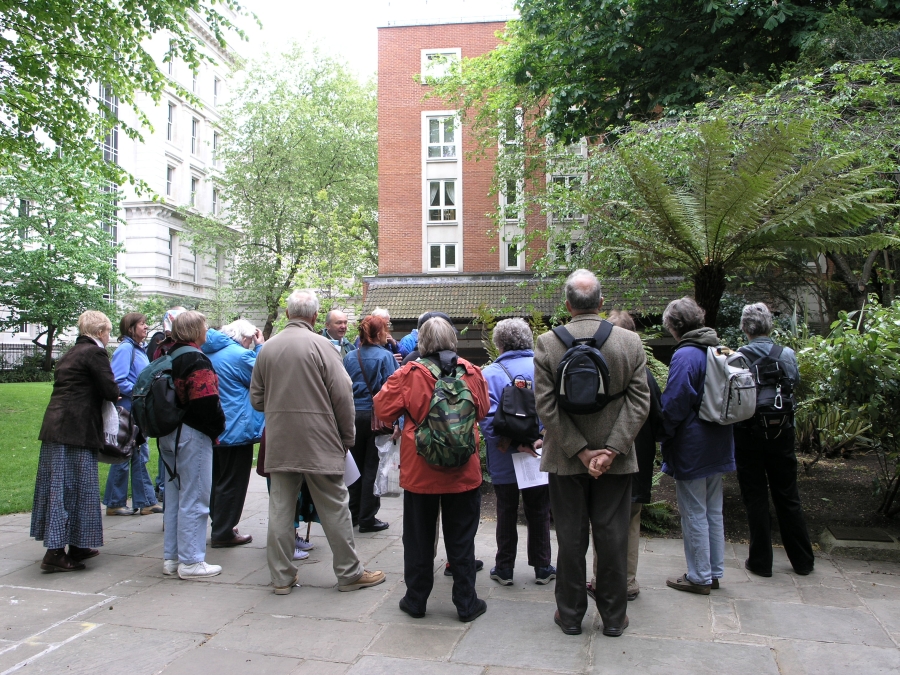
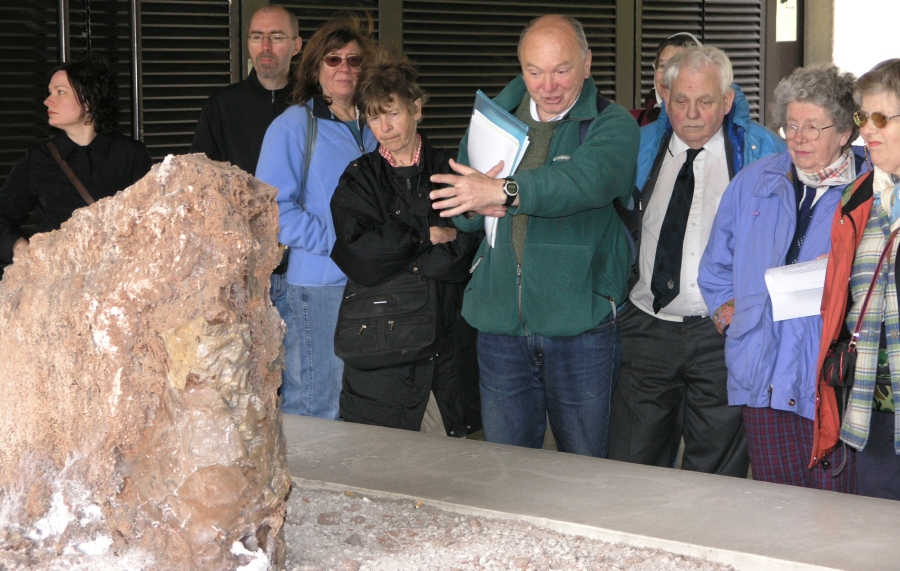
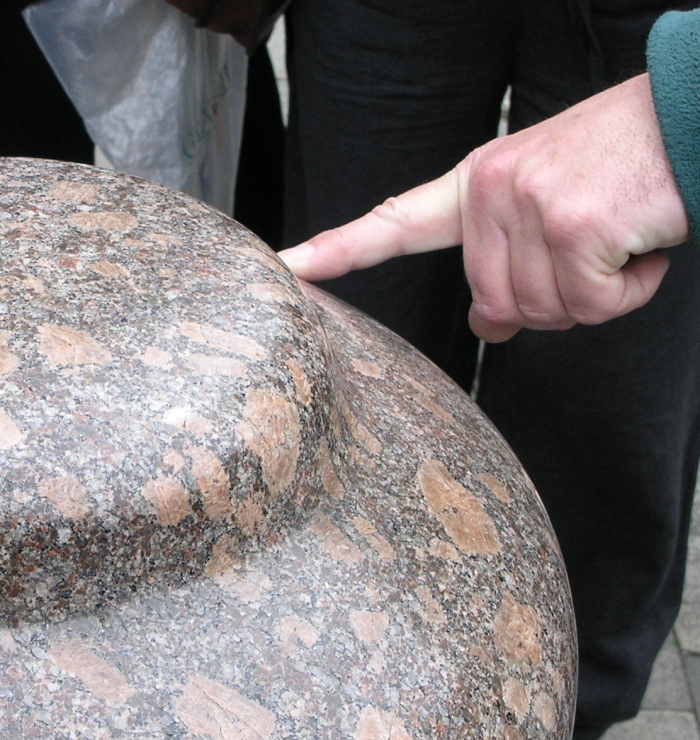
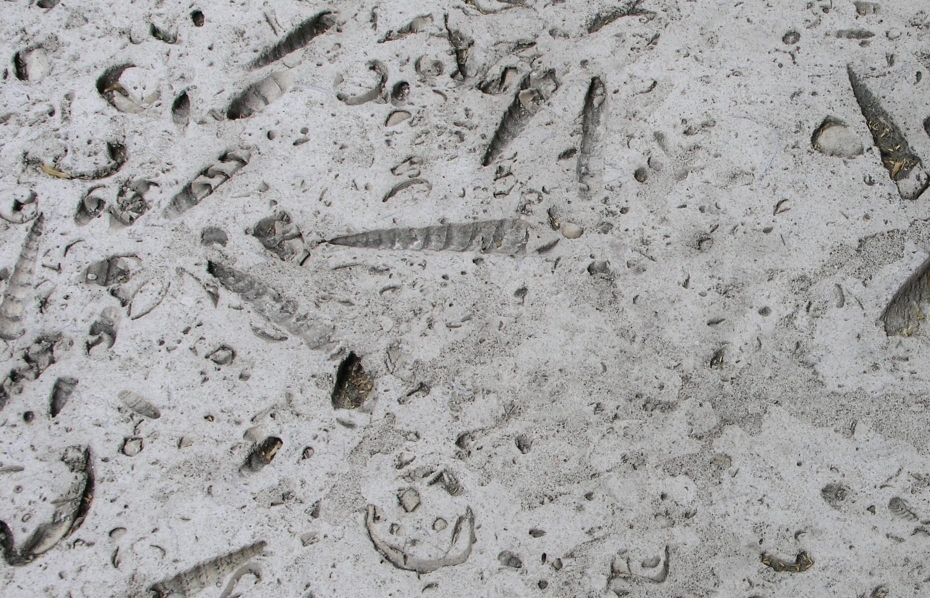
Report on the Centenary 2010 Working Parties
The Observing Section of the Hampstead Scientific Society has had a major spring clean, to kick off the next century. Many tasks and improvements had been contemplated for some time, and celebrating our Centenary, seemed a good excuse to implement them. Simon Lang, under the experienced and watchful eye of Doug Daniels, organised and ran the parties.
Prior to the Centenary Party, the Observatory buildings were tidied up and painted, Doug and Julia Daniels prepared and put up a wonderful exhibition charting the Observatory's history. We bought a party gazebo and put it up and organised food and drinks for the guests.
After the party, during the summer, the front gates and railings surrounding the Observatory were cleared of rust and re-painted, and the cables attached to them, tidied up. The barrier between the Meteorological grounds and the Observatory was re-positioned, to provide a larger viewing area for additional telescopes and give more room for visitors, as we have found ourselves very cramped during special events. The dome's covering of roofing felt had developed many holes, and these were patched. Lastly when doing maintenance jobs in the past, it was always necessary to unbolt a section of fencing, to gain access to outside of the building and railings. This section of fence has now been turned into a gate, which will save a lot of time and effort in future. Many smaller jobs - part of the general maintenance, have not been mentioned.
The Observatory Section are most indebted to the many volunteers who stepped up to the task, without their help, many of the repairs would have to have not been done. We had 10 working parties in all.
Our thanks go to;
Abigail Frost, Daniela Marx, Prof. Michael Crawford and Mandy, Juan David Barrada, Sarah Shearman, Liz Partridge, Sara Lukic, Julie Atkinson, Nayna Kumari, Daniel Pooley, Jim Brightwell and to 'P.G'. of the SAS (Special Astronomical Service) for his role in"Operation Sycamore" (classified).
Also we send a special thank you, to those hard core volunteers who gave up many days to help out:- John Tennant, Roger O'Brien, Ennio Tabone and John Durham.
Next year we ought to repair and recover the dome, watch out for the Secretary and Assistant's 'Twitter from Rio'.
Assistant Secretary; Simon Lang
Solar activity October 2003
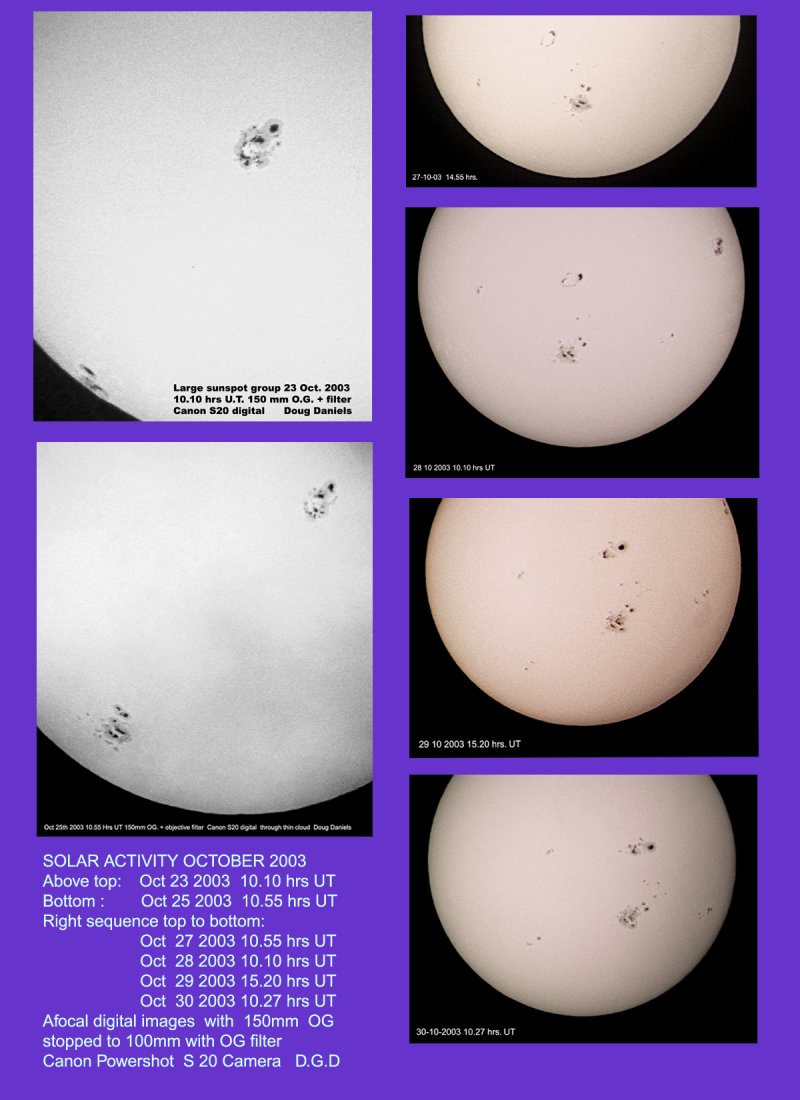
During the latter part of October 2003, the sun underwent a burst of activity which resulted in the formation of several large groups of sunspots, groups large enough to be seen with the naked eye (Through dense filters, of course). This sudden and unexpected activity - unexpected as it is three years past solar maximum, fortunately corresponded to a week of unseasonable good weather. This allowed continuous daily observation of the sun and a record of the developing activity.
My observations began on the 23rd of Oct. A large complex spot group was already well on the solar disk and another one following, was just visible on the limb. This group was reported to be associated with a huge prominence, observed by a colleague with a Solar Max telescope. As this second group moved further onto the disk, a small circlet of spots developed above it, first seen on 27th of Oct. Over the next three days, this group developed sufficiently to become yet another naked eye spot. All of these events were accompanied by intense flares and particle emissions. Terry Pearce and Paul Clements reported a strong aurora visible from Weston Coleville in Cambs on the night of 29th of October, unfortunately it was cloudy in London.
Observations continued until all the spots had moved off of the solar disk by the 3rd of November.
Doug Daniels
Formation of CATS - Camden Amateur Telescope Society
In 1966 May Ammon, the Principal of the Ackland-Burghley School approached Doug Daniels to start an astronomy adult evening class at the school. After a year, due to the pressure of work, Doug handed the class over to Terry Pearce, a long-term friend and a keen amateur telescope maker.
During the subsequent years, by popular demand of the students, the class evolved into not just an astronomy class, but a telescope making class, where members were encouraged to grind, polish and figure their own telescope mirrors and build their own instruments from scratch.
By introducing many people to the study of astronomy and telescope making, the class also became a natural source for demonstrators and assistants at the Hampstead Observatory, many of the alumni became members of the Hampstead Scientific Society.
The class continued to meet weekly throughout the intervening years, surviving the closure of the original Ackland-Burghley venue and finally moving to the Westminster Kingsway College. It was at this institution that it was finally closed down two years ago due to 'economic cutbacks'.
The remaining members were not happy with this decision and so the Camden Amateur Telescope Society (C.A.T.S.) was formed to carry on the good work and application was made to affiliate it to the Astronomy Section of the H.S.S.
C.A.T.S. now meets fortnightly at the Highgate Newtown Community Centre and it was at that location that past and present members gathered on the evening of October the 11th to honour their mentor Terry Pearce, for 38 years continuous service to the study of astronomy and telescope making.
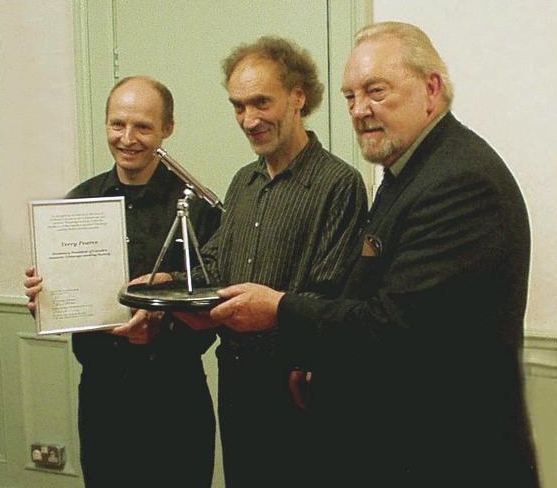
At the ceremony, Terry was made Honorary Life President of C.A.T.S. and was presented with a certificate and a trophy, in the form of a model telescope, designed and made by Simon Lang (left). Doug Daniels completes the triumvirate on the right, presenting Terry Pearce (centre) with a certificate and Trophy (Photograph by Jim Brightwell).
Total eclipse experience
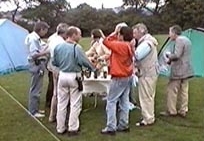
On August 11th 1999, there was a total eclipse of the Sun, visible from Cornwall. This was the first total eclipse observable from British soil, since 1927. In 1999, the Hampstead Scientific society celebrated its centenary and to celebrate these two notable events, members of the society and their friends, went to Cornwall to observe the eclipse. After experiencing initial resistance from hotels and guest houses to the idea of accommodating 30 or so astronomers for a week during their peak holiday period, an approach was made to the Cornish education authority. They proved to be most helpful and we were allowed to hire Redruth School for a week. Redruth being situated quite close to the centre line of the eclipse. Some members camped in the hall and gym, whilst the more hardy dwelt under canvas in the school playing fields. The school provided catering facilities for breakfast and packed lunches and gave access to their Internet facilities.
In the months leading up to the eclipse, members spent time and effort building and modifying equipment to record the event. Long focus telephoto lenses were obtained. Special filters were made and experiments were conducted photographing and videoing the Sun. Films were chosen and exposure times determined. In June, many members attended a meeting at the Astro. Sec's. home to discuss equipment and travel arrangements.
The media, press and television, became aware of the forthcoming event and our own eclipse chaser, Jim Brightwell, who has travelled the globe to observe 6 total solar eclipses, was much in demand for interviews. The media managed to convince much of the general public that Cornwall would be turned into a disaster zone, food and water would run out and that during eclipse week the population of the county would consume 7,500 miles of toilet paper! Presumably proving that solar eclipses have a hitherto unknown laxative effect on rural populations! Moreover, the roads in the region would undoubtedly become gridlocked and emergency services would be unable to cope. Doctors and midwives would be unable to attend confinements. One can only admire the restraint exhibited by locals, nine months earlier, if they really believed such nonsense!
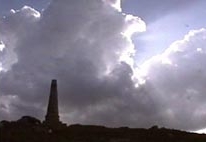
In the event, the journey to Cornwall turned out to be totally uneventful, there were no exceptional traffic jams and many of the special campsites passed on the way, appeared to be almost deserted. We arrived at Redruth School on Sunday 8th of August. We spent the next two days sorting out equipment and enjoying the local scenery. The night of the 10th of August was totally clear and many of us spent some hours photographing the night sky and looking out for any early Perseid meteors, the maximum due to occur of the 12th. The clear Cornish air afforded fine views of the Milky Way and the star clouds in Sagittarius were easily visible right down to the horizon. Despite the clarity of the night sky, we were all too aware that cloud was on the way! Meteorological reports and charts obtained via the Internet, indicated that a front was moving in. We hoped that its progress would be slow and that it would hold off until after the eclipse.
The morning of the 11th dawned totally overcast. By 10.30 am. it was raining a fine drizzle. At this point we knew for certain that we would not see the full glory of the eclipse. As the moment of totality approached, we stood on the steps of the television room, hoping, at least to witness the sudden darkening as the Moon's shadow swept over us. The sky took on an eerie pallor, darkening steadily. Then suddenly, the shadow swept over us. All the streetlights in Redruth snapped on and the seagulls set up a manic squawking. The temperature dropped and a chill wind blew. The rain abated and as we looked around we could see a band of light like a sunrise, all around the horizon. Thus it remained for a little over two minutes as we stood in the shadow cast by the Moon. A strange almost tangible silence gripped the land, nothing stirred. Nature seemed to be holding its breath. Then quite suddenly, the sky began to lighten, the seagulls began to squawk again, the streetlights blinked out and totality was over.
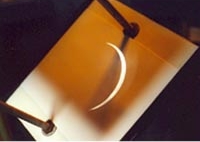
Although we had failed to see the full glory of the eclipse, we had observed the strange atmospheric effects, phenomena, that might have gone, unnoticed had we been concentrating on the Sun itself, and it was generally agreed that it was worth the journey just to experience that! Some members stated that the experience had a strong emotional effect on them. I agreed, the emotion I felt was anger! If only the cloud had been delayed by 12 hours, we would have had cloudless skies.
Meanwhile, back in London at the Hampstead Observatory, Julia Daniels, Julie Atkinson and Geoff Shelley, managed to project the 97% partial eclipse for the benefit of visitors and even managed to secure a few photographs. So at least some members of the Society saw something of the Sun on eclipse day!
Comet Machholz 2005
Comet Machholz was visible in the sky in 2005. It was discovered by Don Machholz in August. The comet was seen as a diffuse patch with a star like nucleus and, in December, no discernable tail. It was at about magnitude 5, faintly visible to the naked eye.
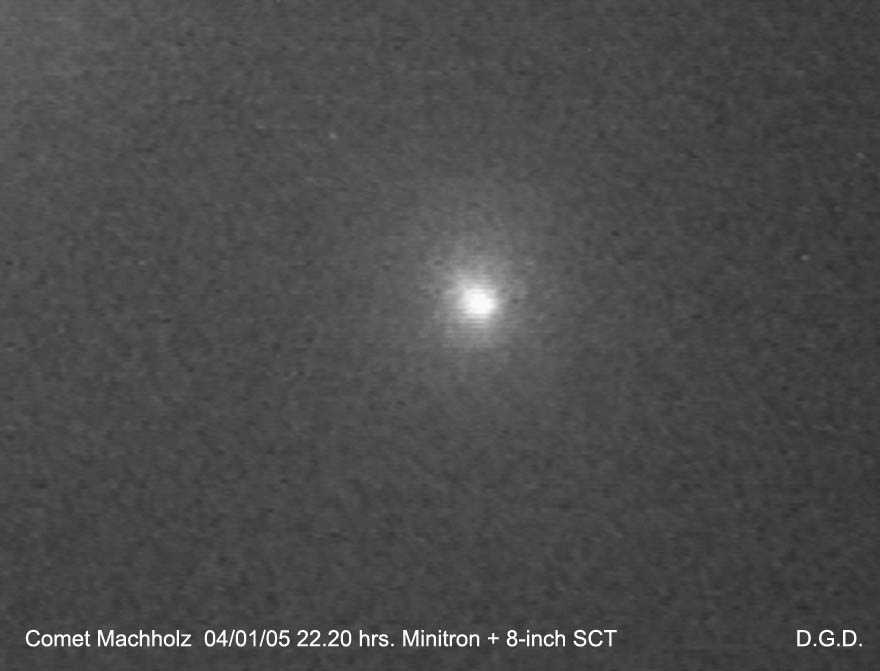
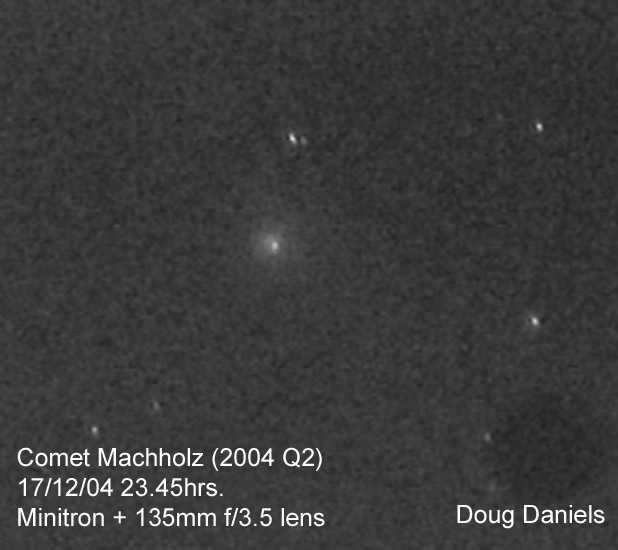
During early January 2005, Comet Machholz climbed steadily through the southern sky up into the constellation of Taurus and on the evening of Jan 8th it was to be seen in the same low power field as the Pleiades star cluster.
Observing from the darker skies of Weston Colville in Cambs., Terry Pearce managed to obtain some beautiful images of the comet when it was close to the Pleiades.
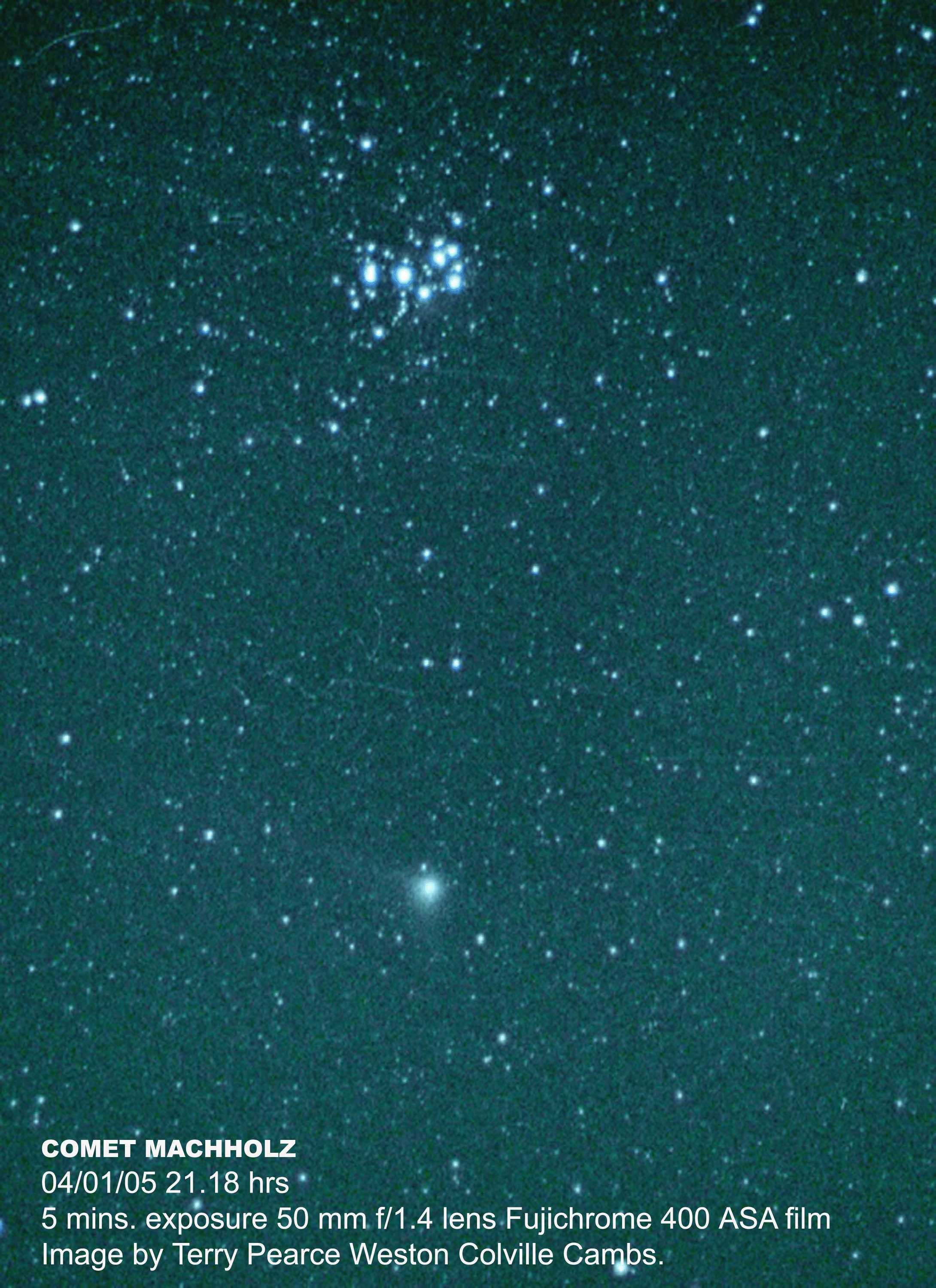
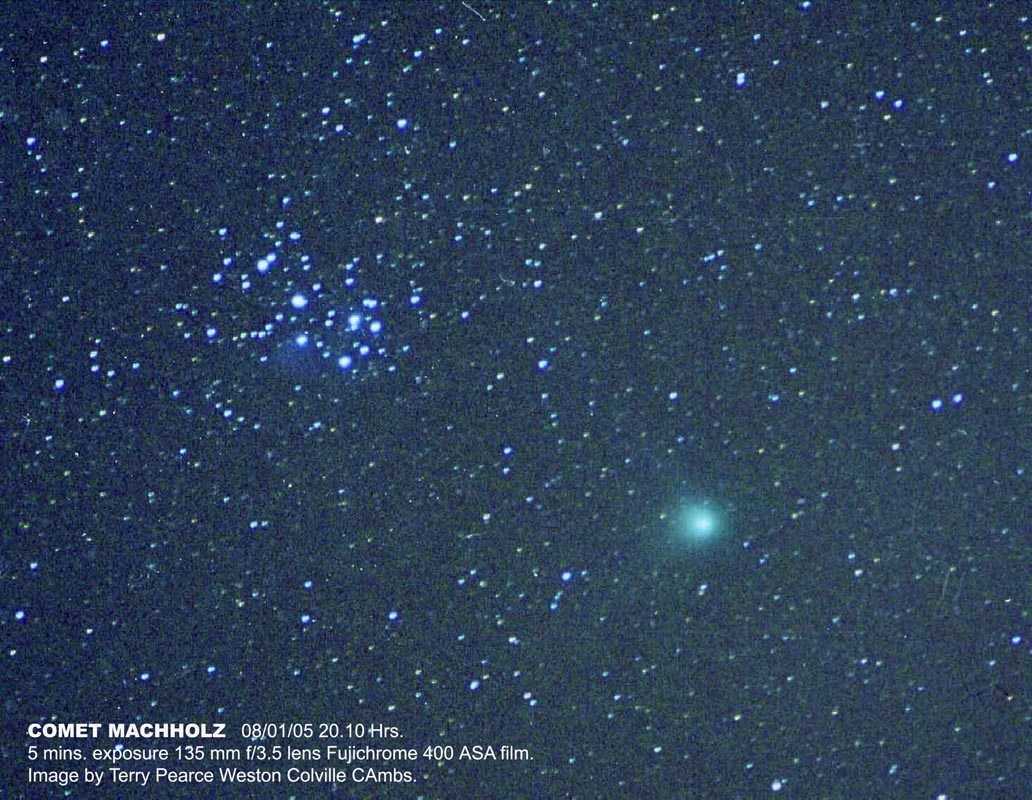
Terry used a Canon SLR 35mm film camera mounted piggyback on a small equatorial telescope for the 5 minute guided exposures. The images were captured on 400 ASA Fujichrome colour print film. The negatives were scanned and then processed in a computer using Adobe Photoshop.
SOLAR ECLIPSE MARCH 29 2006
On 29th of March 2006 there was a total eclipse of the Sun. The track of totality crossed parts of northern Africa and southern Turkey. In London, the eclipse was partial, about one third of the Sun obscured.
On the morning of the 29th, several members attended the Observatory, bringing an assortment of portable equipment with which to observe the eclipse. The 29th dawned brightly but by the time of first contact: 09-45.1 UT (Greenwich), the skies were totally overcast.
However, a few minutes later, a small clear patch allowed just a glimpse of the start of the eclipse. From then on we had to wait for the clouds to part to allow us brief tantalising views of the advancing Moon.
There was a small group of sunspots close to the Moon's limb and the view through Brian Bond's Coronado hydrogen alpha telescope revealed a number of short-lived prominences, adding greater interest to the event. The Astro. Sec. managed to take a few digital images through his 6-inch Helios refractor during a few clear moments.
The classes of schoolchildren, who were due to come, failed to turn up, but about 40 or so members of the public attended, some with the organized Hampstead Walks. The eclipse ended at 11-22.3 UT (Greenwich). It was an interesting event spoiled once again by bad weather. We hope our colleagues who travelled to Turkey to witness totality, faired better.
Doug Daniels
P.S. Jim Brightwell fared a great deal better in Turkey.
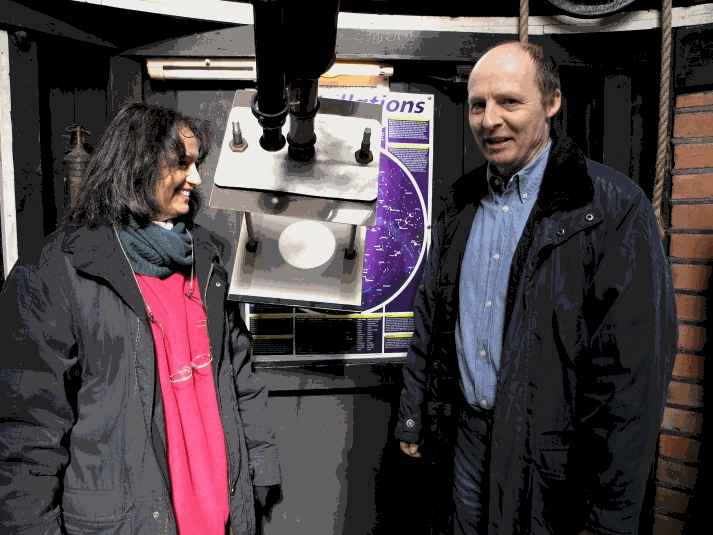
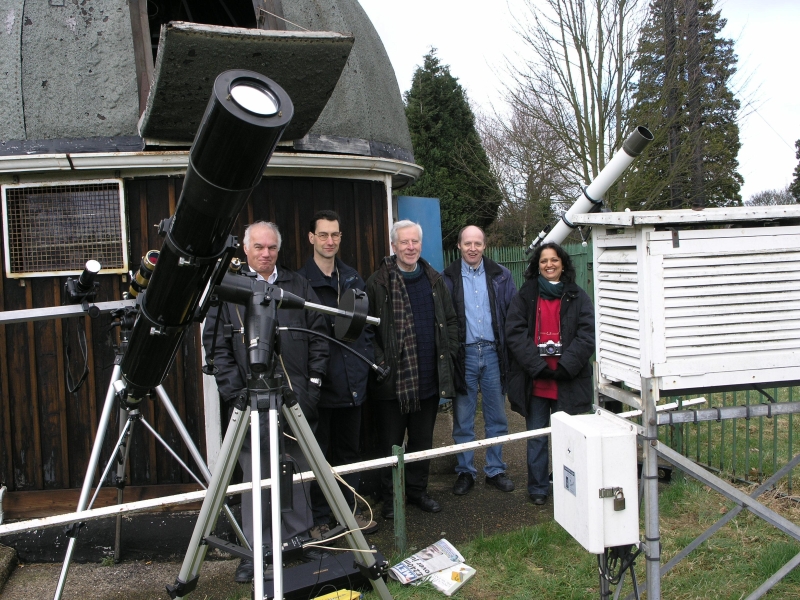
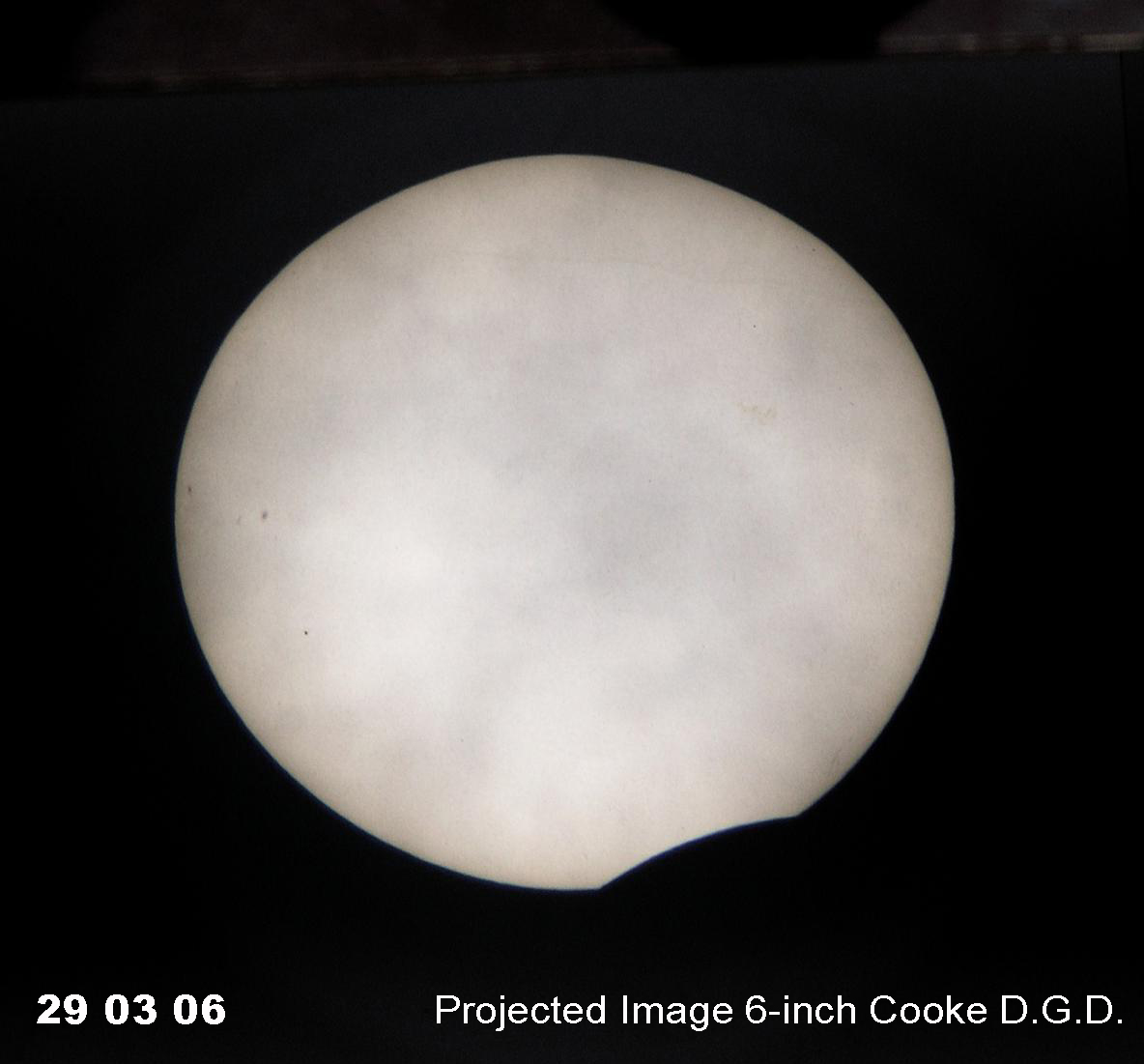
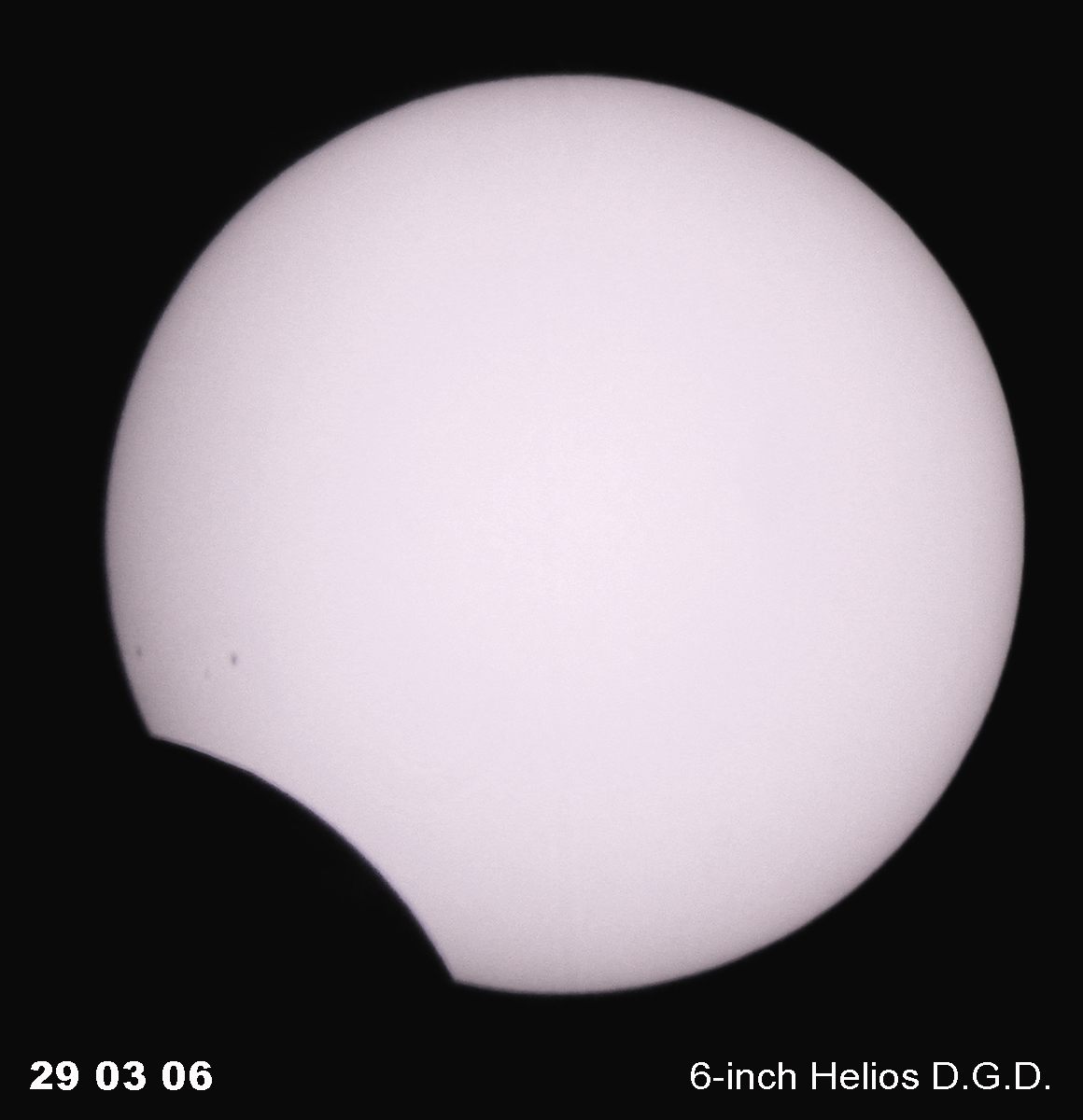
Comet McNaught, (C/2006 P1)
Comet McNaught, (C/2006 P1) was discovered by Robert McNaught working at the Siding Spring Observatory in New South Wales Australia in August 2006. When discovered, the comet was a very faint object, but when its orbital elements were calculated, it was realized that this comet had the potential to be a bright object. Its perihelion was calculated to bring it as close as 15.8 million miles from the Sun, that is about half the orbital distance of Mercury. Its brightest predicted magnitude was about +3, but comets are unpredictable and McNaught greatly exceeded its predicted magnitude. It possibly underwent a flare up because its nucleus attained a magnitude about that of the planet Jupiter -2.
For most of the time, the comet remained a southern hemisphere object, but for just a few days in January 2007, the comet was accessible to northern hemisphere observers.
During this time the comet was, for a short time, observable as
both a morning and evening object. Then it moved into the evening
twilight sky close to the south-western horizon. For this reason it
was difficult to observe as a very low unobstructed horizon was
required - a difficult requirement from London.
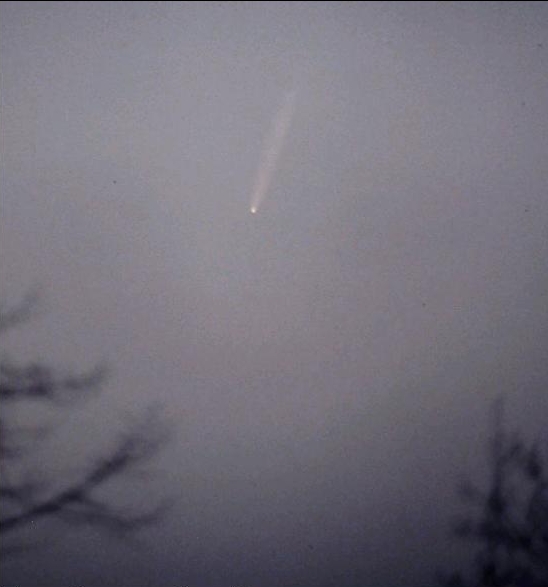
Nevertheless, two members managed to view the comet. On the evening of January 11th, Daniel Pooley observed it from Parliament Hill and Simon Lang managed to get an image observing from the top of a tall building in Frognal Gardens.
Both described the comet as having a bright stellar like nucleus and a long broad tail extending for at least 5 degrees.
Comet McNaught has been described as 'the brightest comet for 40 years'. It is a pity that it remained in the northern hemisphere sky for so short a time and in such an inaccessible position.
The photo shows Comet McNaught captured by a 3 second exposure by Simon Lang on January 11th from Hampstead.
BBC Stargazing Live and the Hampstead Observatory
As is usually the case, one organises for people to watch the skies, only for the weather to close in and spoil the event. The BBC decided to try and get people more interested in astronomy and organised 'Stargazing Live' for the first two weeks of January 2011. The event relied on Astronomical Societies, up and down the land, to open their doors to the public to view the conjunction of Jupiter and Uranus, the Quadrantid Meteor Shower and the partial solar eclipse (75% at Sunrise) on the morning of the 4th January.
On BBC 2 from the 3rd – 5th January there were three 1 hour programs at 8pm each evening, to report on the apparitions and give basic advice to novice astronomers. The event was also organised to include local news reports, an events section on the 'Stargazing Live' website and to organise people sending in their photos from the various events and related material. Our Astronomical Secretary Doug Daniels was interviewed for the BBC London website and he made a large contribution to the Sky at Night images on Flickr (flickr.com/photos/doug_daniels). The BBC also produced some wonderful small Star Guides to hand out to the public with tiny compasses attached. A large banner was also supplied to hang up to advertise the event, and that alone attracted at least 10% of the visitors to the Observatory during the week.
We opened our doors every evening for the first week in the hope of observing the conjunction of Jupiter with Uranus. Despite the clouds we received around 60 visitors from Monday to Friday at the Observatory and around 40 people joined us up on Parliament Hill, on the Tuesday morning, to see the partial solar eclipse. At the Observatory we entertained people by telling them about our history and the telescope, we also took questions and expanded on their topics. Sadly not one thing was seen from Monday to Friday due to the stubborn thick cloud cover.
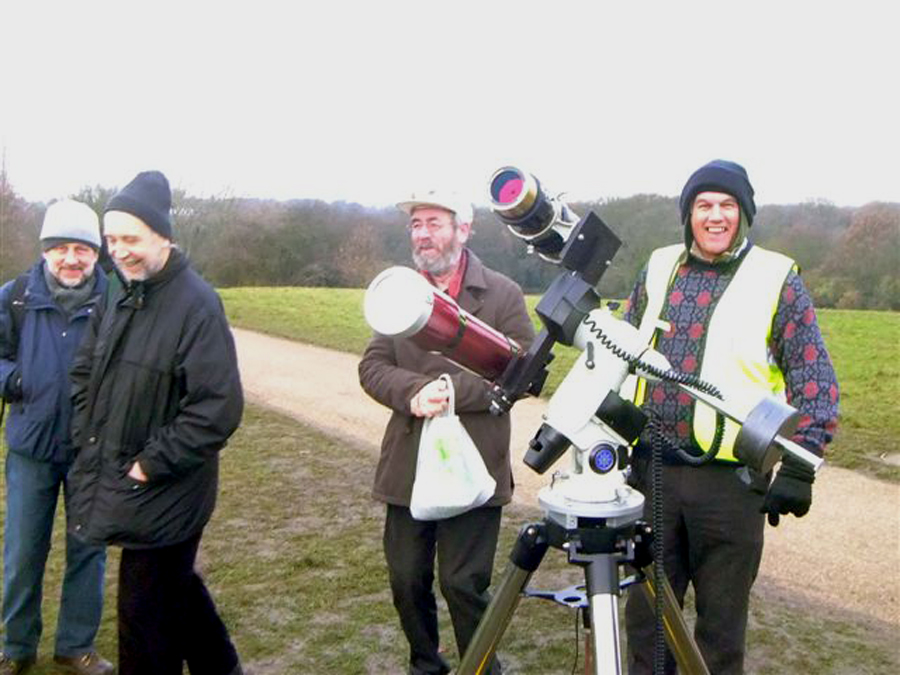
At the Eclipse Watch we all stood around getting cold whilst looking at broken cloud, sadly the holes in the cloud never made it to the Sun except for two momentary gaps. Intriguingly there were gasps and shouts of 'there it is' and an extremely amorphous eclipse could be seen, strangely the Sun's disc with the Moon on it appeared, but was at least twice as big as usual and not clear. On discussing this among ourselves we came to the conclusion that the eclipse had been projected onto low cloud from a small hole above, creating a 'Ghost Eclipse', have we seen an extremely rare event? Shortly after that the eclipse proper appeared through misty cloud for all of about 5 seconds. Fortunately we had Matthew Morris and a cameraman from BBC's London News, who were with us to cover the event. Fortunately the cameraman managed to get the sun in his sights and was poised to catch it. Although the eclipse was a non event for most of the assembled group, being a positive bunch most of us enjoyed trying anyway.
The bonus was BBC London deciding to make a long article on the Eclipse Watch, shown on all three main news programs on the Tuesday. After each, Peter Cockcroft the weatherman focussed on the Hampstead Observatory as part of the weather. Many visitors on the subsequent evenings came as a result of the news.
Copy this link into your browser to see the news report; http://cdnedge.bbc.co.uk/local/london/hi/people_and_places/nature/newsid_9337000/9337417.stm
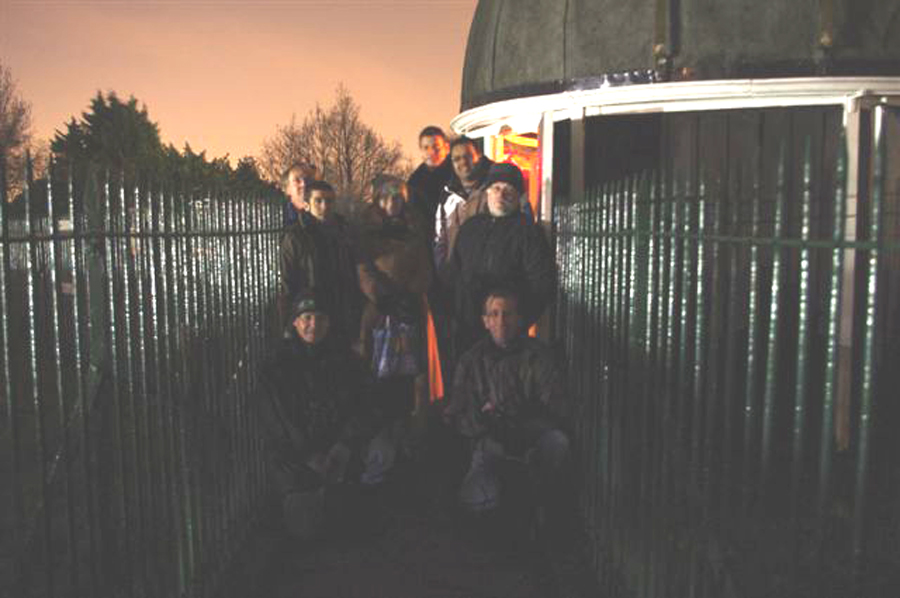
The week was capped off with the first clear sky (corresponding with us opening of course) for a month. We received somewhere in the region of 100 visitors in two hours, fortunately I'd anticipated this and organised 6 staff to be on hand with additional equipment, at least everybody got to see one thing, or another, namely Jupiter or the Orion Nebula. On subsequent weekends the numbers remained high, peaking on the evening of the 'Super Full Moon' when we estimate somewhere between 150 to 200 visitors queued patiently in the freezing cold.
Our thanks go out to all our staff that went the extra mile, attending the extra events and bringing equipment, as well as Sara Lukic and Jim Webb from the Astronomical Society of Haringey. We also would like to thank Kathryn Morrison our Stargazing Live liaison at the BBC, for her sterling efforts in helping us maximise our profile throughout.
Assistant Secretary; Simon Lang
Total lunar eclipse: March 3rd 2007
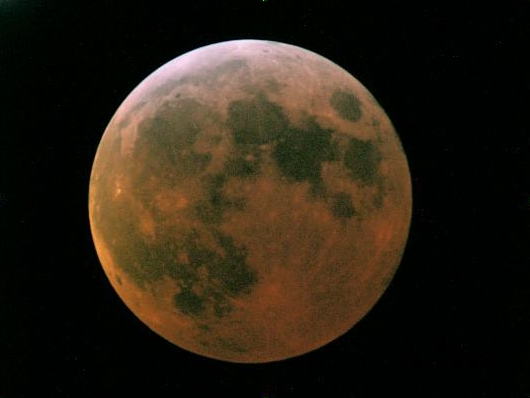
The Observatory threw open its doors and dome to more than 100 visitors who came to observe the total eclipse of the Moon on the evening of Saturday March 3rd 2007. The day had been cloudy and showery, but it cleared up by sunset and then clear skies prevailed allowing us to enjoy this beautiful event under almost perfect conditions with the Moon at high declination in Leo.
The penumbral phase began at 21.30 hrs and totality lasted from 22.44 hrs until 23.57 hrs, during which time the Moon took on the characteristic deep copper red tint. We observed until the moon entered its final penumbral phase at 01.11hrs on the 4th by which time most visitors had departed.
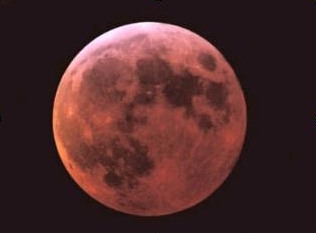
The following series of images were taken by Doug Daniels, with an Olympus E-500 digital SLR attached to a 450mm f/5.6 Watson telephoto lens with a x2 teleconverter piggy-backed on the 6-inch Cooke refractor.

Mercury transit 2003
On the morning of May 7th 2003, the planet Mercury transitted the Sun. This was an early morning event as ingress took place at 05 hrs 12 mins 53 secs and the event ended with egress at 10 hrs 31 mins 42 secs. Simon Lang kindly volunteered to open the Society's Observatory for those members who fancied an early morning session and several took advantage of it. For once the sky was actually clear and I managed to secure several good digital images with my 150 mm helios refractor. This was equipped with a 102 mm objective filter produced by Terry Pearce. The early part of the transit was however, ruined by aircraft contrails, several of which criss crossed the Sun and persisted for a very long time. The increase in air traffic in the London skies is providing yet another form of pollution which we now have to suffer!
Doug Daniels
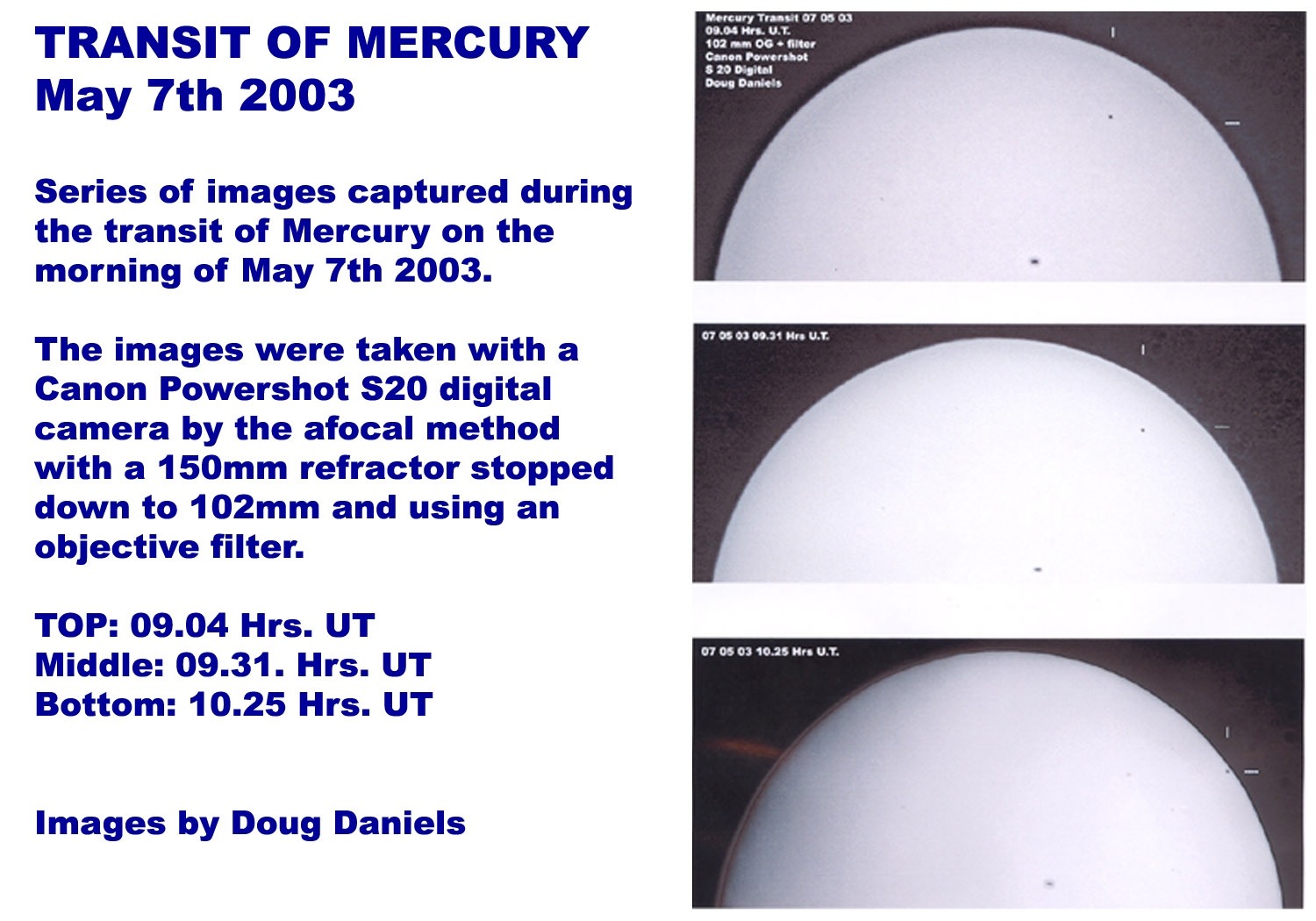
Mars opposition 2003
During August 2003, Mars was in close opposition and on August 28th, the planet made its closest approach to the earth for 60,000 years! At just .37 AU (34.4 million miles), from earth, Mars attained a visual magnitude of -2.9 and presented a disk diameter of some 25 arc/secs - just about as large as it can get and considerable detail could be discerned despite the low declination of the planet for northern hemisphere observers. This year, National Astronomy Week was arranged to coincide with the opposition of Mars and the Society opened the Observatory on every clear night during the week. In all, over 400 members of the public took the opportunity to observe the planet.

Despite the low declination of the planet, convection currents rising from a city gripped in a mini heat wave, a turbulent atmosphere and the vapour trails of numerous aircraft, the prominent wedge shaped feature Syrtis Major was easily seen. The white southern polar cap was very obvious as Mars' southern hemisphere was tilted towards us by about 19 degrees. On all the open nights some visitors lingered to well after midnight by which time the planet had risen to its maximum height above the horizon and the definition improved. The view in the early hours of the 31st. can only be described as 'stunning'.
By this time the Syrtis Major had just crossed the central meridian and further south a dark Iapigia contrasted with the pale ovoid of Hellas which was well seen bordered by the Mare Hadriacum and Trinacria to the east and Yaonis Regio and the Mare Serpentis to the west.
Syrtis was followed by a dark Sinus Sabeus, above which the pale Deucalionis Regio stood out in contrast to the dusky streak of Pandorae Fretum to the south. Further to the south and west, Noachis paled into the planet's western limb. The northern tip of Syrtis was quite dark and to the east Moeris Lacus could be discerned below a pale Libya, above and to the east of which stretched the dark swathe of Mare Tyrrhenum, but I could not trace Nepenthes. The southern polar cap was quite prominent with a dark collar, particularly dark on the eastern border of Depressio Hellispontica. The desert regions of Aeria and Arabia appeared quite featureless with no trace of either Phison or Euphrates. The brighter desert regions Meroe, Dioscuria and Cydonia, merged into a general limb brightening to the north. I saw no trace of Ismenius Lacus.
Observations continued to well past opposition but the rapidly shrinking disk size coupled with the low declination made observations increasingly difficult from London. We look forward to the next opposition in two years time when despite the planet's greater distance, its higher declination will perhaps afford us a better view.
Mars opposition 2005
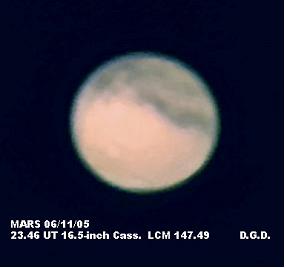
Although not quite so close as the 2003 opposition, the opposition of 2005 was far better for northern hemisphere observers. The planet was to be found in the constellations of Aries and Taurus well above the horizon and consequently out of the murk. The disk size at opposition on November 7th was a good 20 seconds of arc, large enough to reveal much surface detail given calm atmospheric conditions.

I had looked forward to this opposition, as I was anxious to try the "new" method of planetary imaging. This method involves the use of a "webcam" in conjunction with RegiStax software. The planet is imaged directly on to the chip in the webcam using my 16.5-inch Cassegrain and a short video stream is taken. This is then read into RegiStax in the computer.
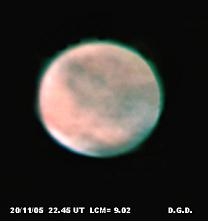
This wonderful free software allows every single frame of the video to be examined. When a sharp one is found it is used as a reference. RegiStax will then align and stack all the good frames to produce a final image. Personally, I found the webcam difficult to use, even getting the large image centered on the chip was quite difficult and focussing with the exposure delay was irritating in the extreme!
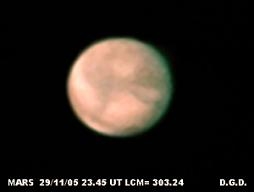
I experimented using an ordinary Canon Camcorder as it occurred to me that as it could work at 1/50th of a second exposure, this ought to capture some steady moments and produce a lot of frames in a short video sequence, some of which should be reasonably sharp. I set it up to work afocally, fitted on to a bracket and imaging straight through the telescope eyepiece. I was then able to take fairly long videos which I then processed with RegiStax. Some of the results obtained are shown here.
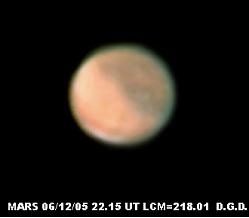
On many occasions the atmosphere was very unsteady which severely limited resolution, but despite this, much of the detail seen visually was recorded. Each of the images were built up after selecting the best of over 500 individual frames. The images clearly show the nights when definition was better. In the image taken on the 6th of Nov. the darkest marking is the Mare Sirenum with Solis Lacus on the south-eastern limb. In the Amazonis desert below, the pale circle of Olympus Mons can be discerned The night of the 20th of November was particularly good with high atmospheric pressure and slight mist producing calmer seeing. This image shows Sinus Meridiani approaching the Central Meridian with a haze over the western limb, which might be evidence of the dust storm currently in progress along the Valles Marineris. The southern polar cap had, by this time melted away but the northern cap was still very much in evidence. On Nov. 29th Sinus Meridiani is on the western limb and Syrtis Major is approaching the CM with the pale oval of Hellas evident above. By early December, the disk size was already becoming noticeably smaller at 16.1 seconds of arc in diameter on the 6th where the Mare Cimmerium is featured with the dark spot of Trivium Charontis just visible in the desert region below.
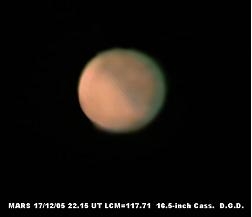
By December 17th, the disk size was down to 14.4 arc secs. and although it was a stunningly clear cold night, the atmosphere was very unsteady. The image shows Mare Cimmerium close to the western limb and some vague mottling in the Amazonis desert below. I had few further opportunities to observe the planet at the end of December and by early January 2006 its diameter had decreased to about 11 arc secs. The weather continued to be poor until the 11th of January, but despite a clear night, the seeing was bad and the disk was just about 10 arc secs. in diameter, half the diameter at opposition, too small for me to record any significant detail.
Transit of Venus 2004
For the first time since 1882 the planet Venus crossed the sun. The last time an entire transit was visible from the British Isles was 1283. The Hampstead Scientific Society's Observatory was open for the whole transit from 6am to 12:30pm (transit started at 6.20am, ends 12.20pm). We had a brilliant day for the transit. Over 500 people came, including classes of youngsters from the local schools with their teachers. The weather was perfect if not too hot! and everyone had a great time. Click on the images below for pictures of the event.
Doug Daniels
